fall inside a hole
 |
| Sets | Trains | Rail | Accessories | Thomas series |
Tomy Train Accessories
Tomy Train's accessories were a mix of Plarail accessories adapted for the system and original accessories that took advantage of the Tomy Train system's features. Initial accessories were a mix of staples like bridges and railroad crossings, Plarail adaptations, and cool new cranes and vehicles that played into the freight and train standards. Many accessories had additional studded surfaces which were removed over time.
1305 Bridge and Six Girders (1988)
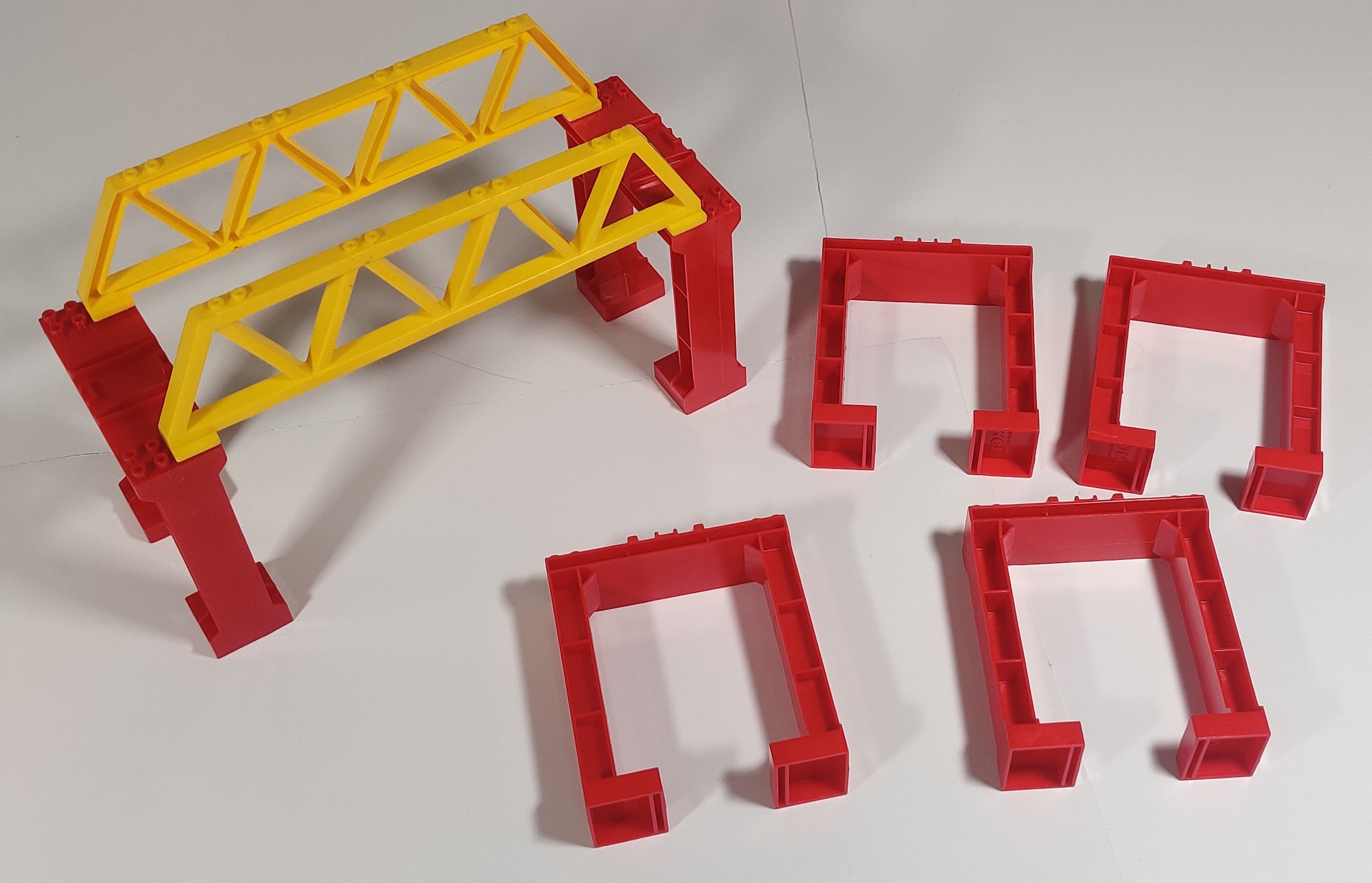
Because the Tomy Train engines are taller than Plarail trains the existing block bridge girder standard could not be used and a new taller red system was created. The top of these girders have two by four patches of studs that can be used to attach the bridge side pieces (also studded on top) or any other LEGO or similar brick-built creation.
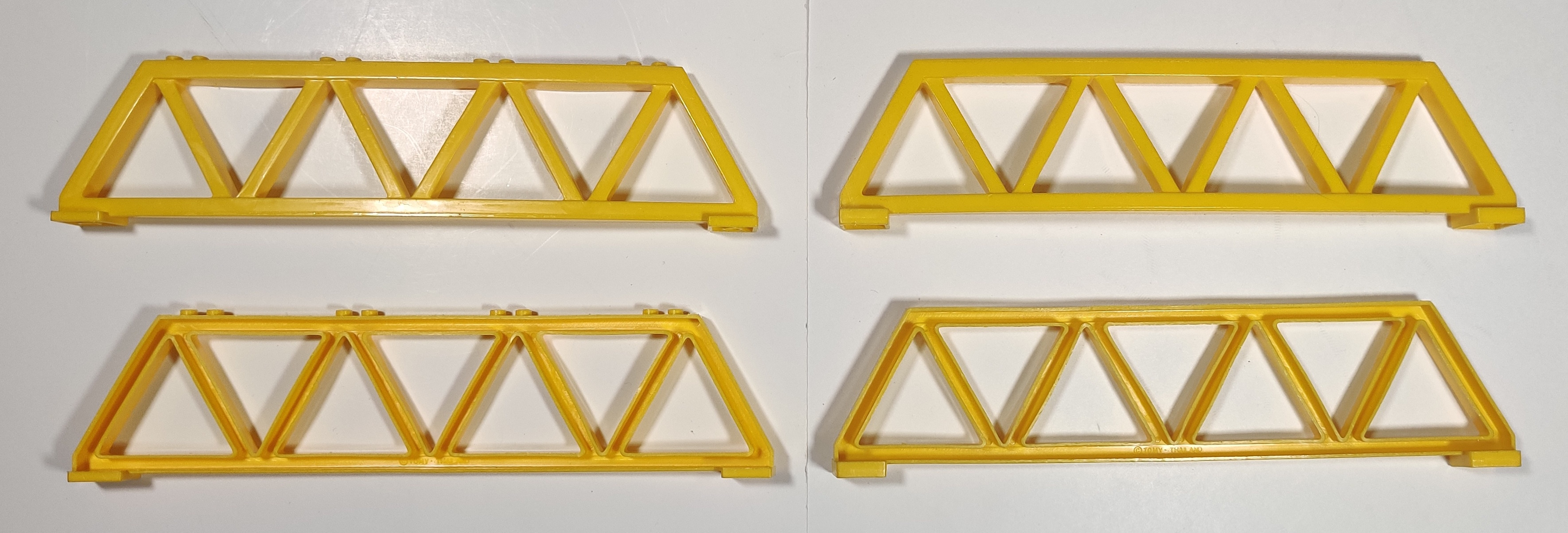
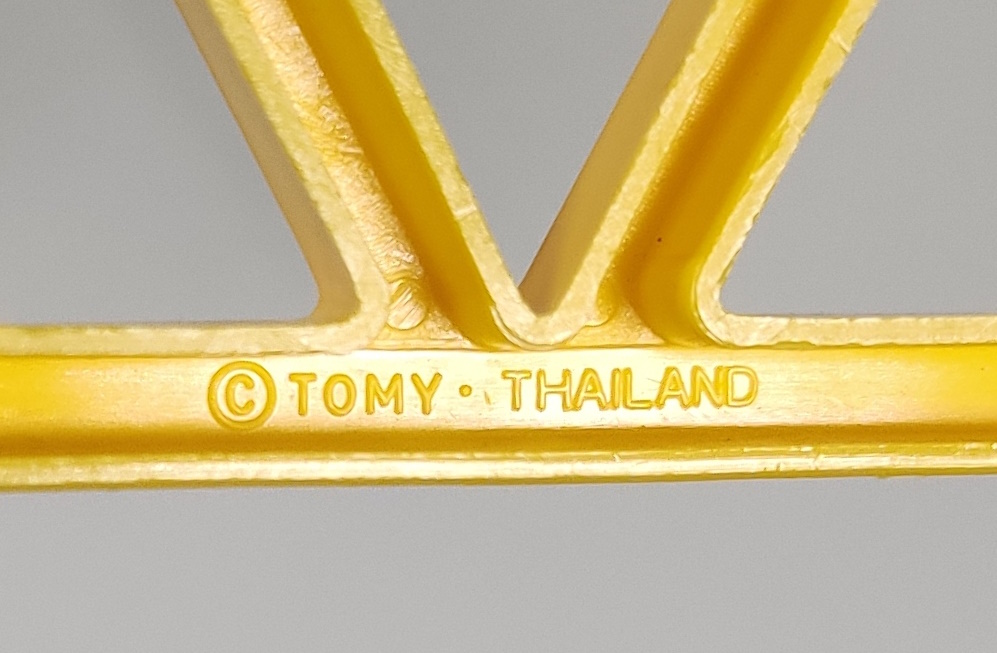
Included in several sets alongside the girders as well as this individual release is a yellow iron bridge similar in concept to the classic Plarail red iron bridge. Earlier sets have a version with studs on top of the railings while later sets that toned down the brick compatibility removed these studs, also making the connection areas deeper and stronger. See below for more on bridge differences.
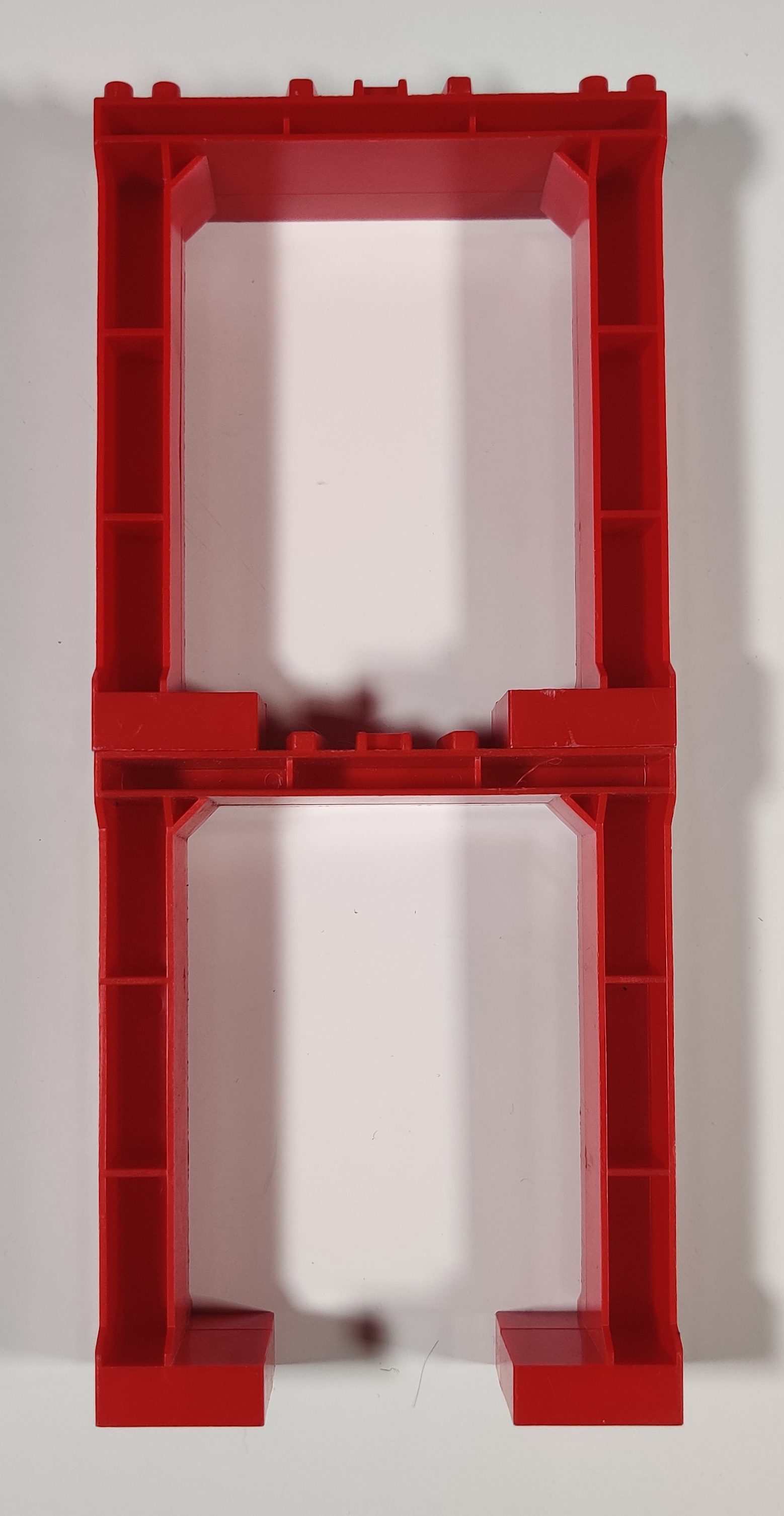
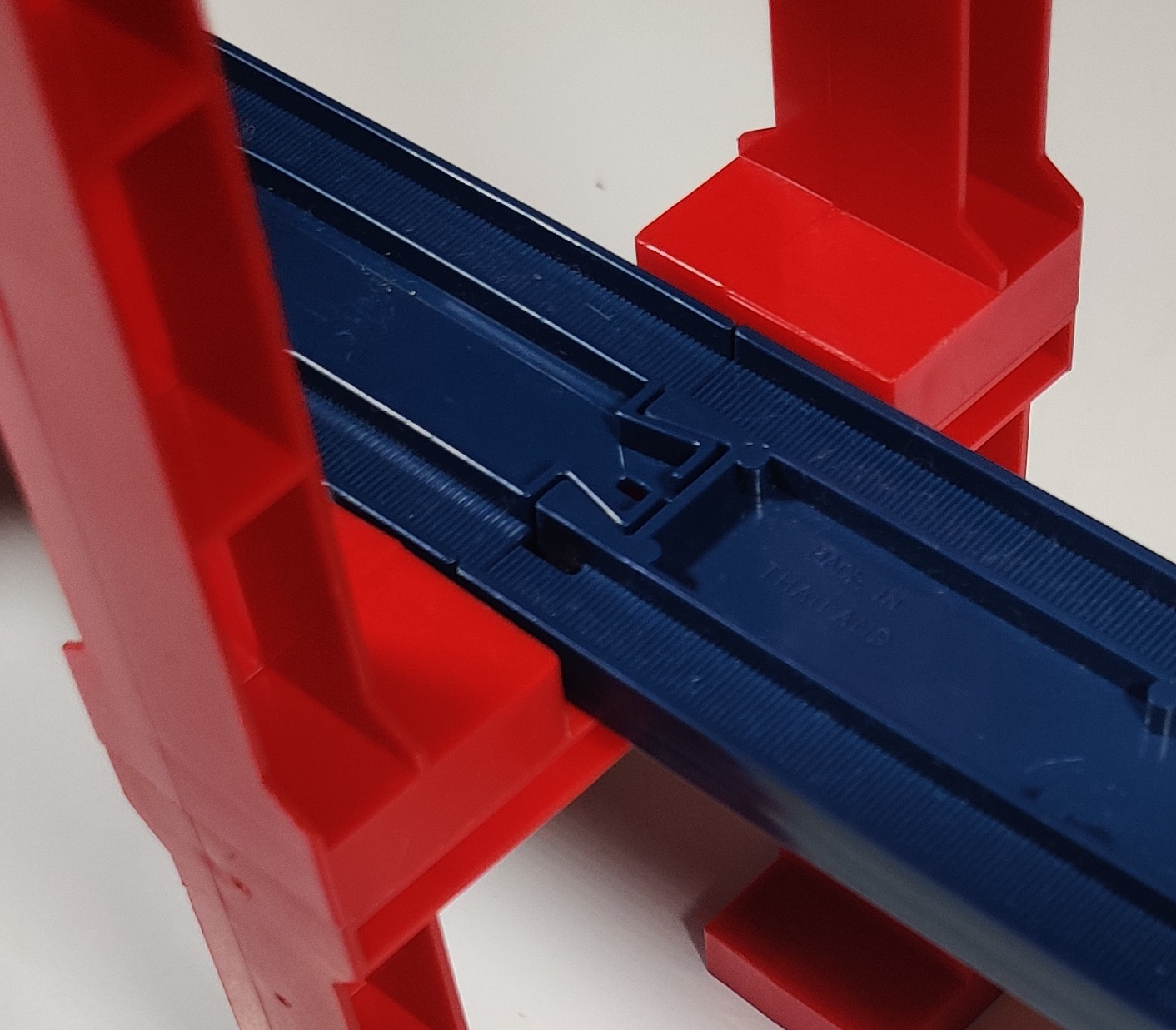
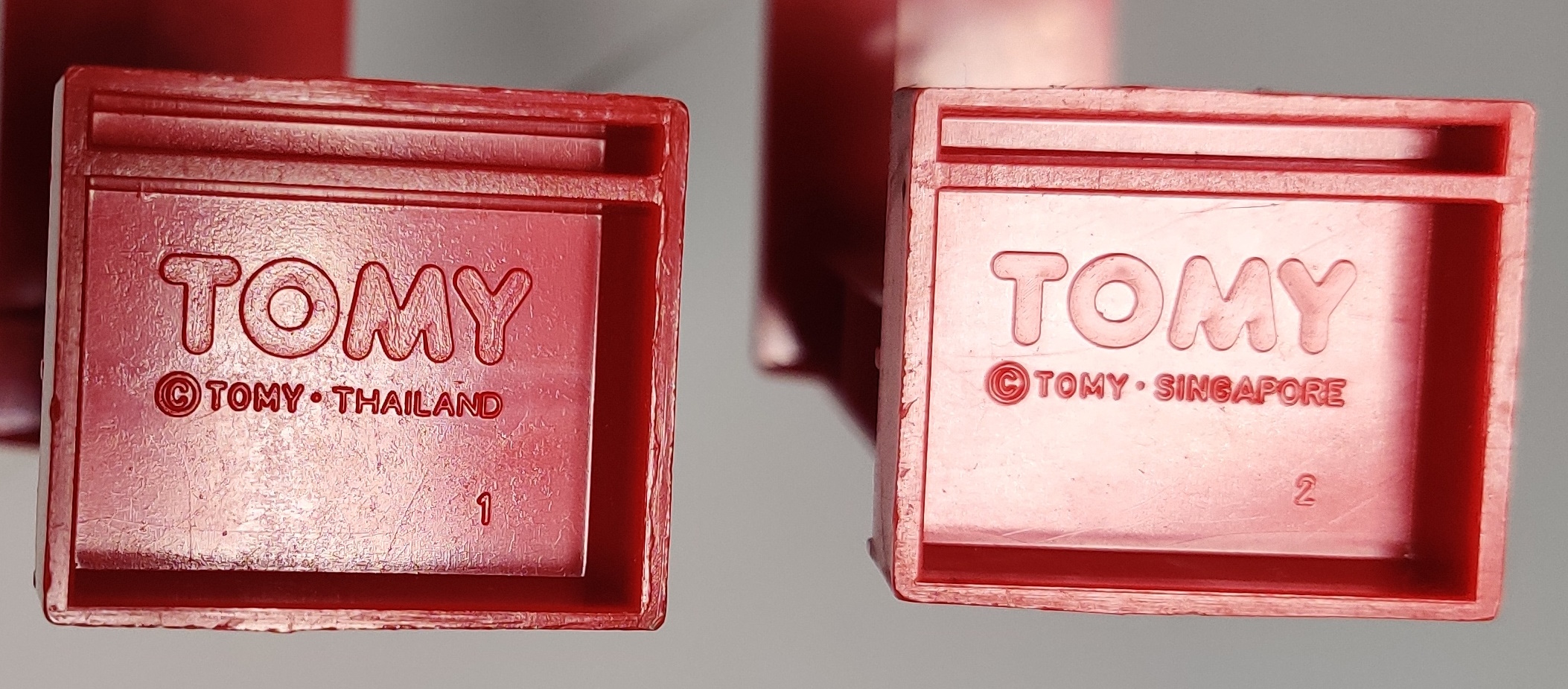
The girders also stack on top of each other like the Block Bridge Girder system. These girders raise track approximately 108mm as opposed to Plarail's 65mm and do not actually grip around the rail joint when stacked. The girders were originally made in Thailand and later Singapore.
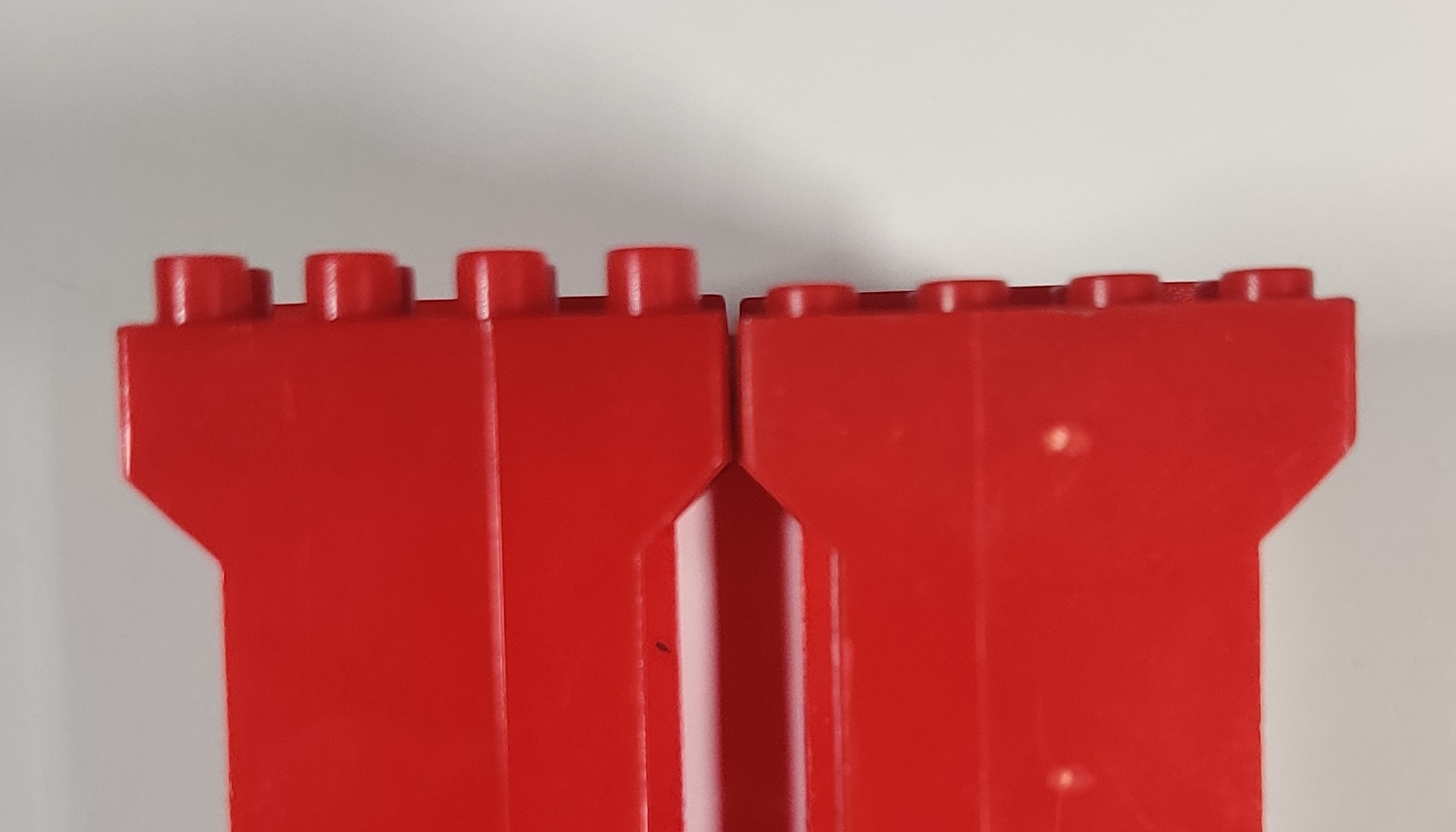
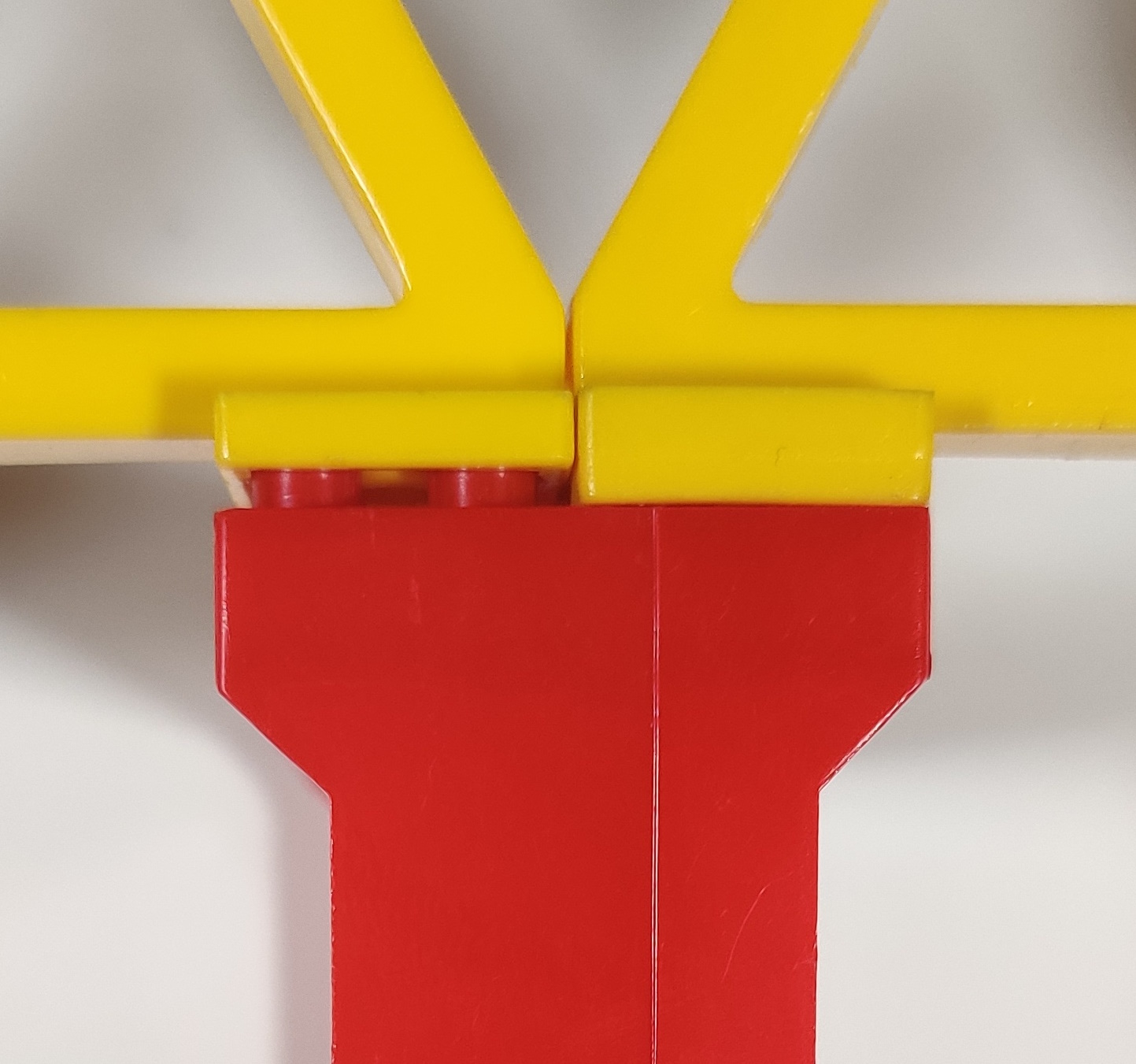
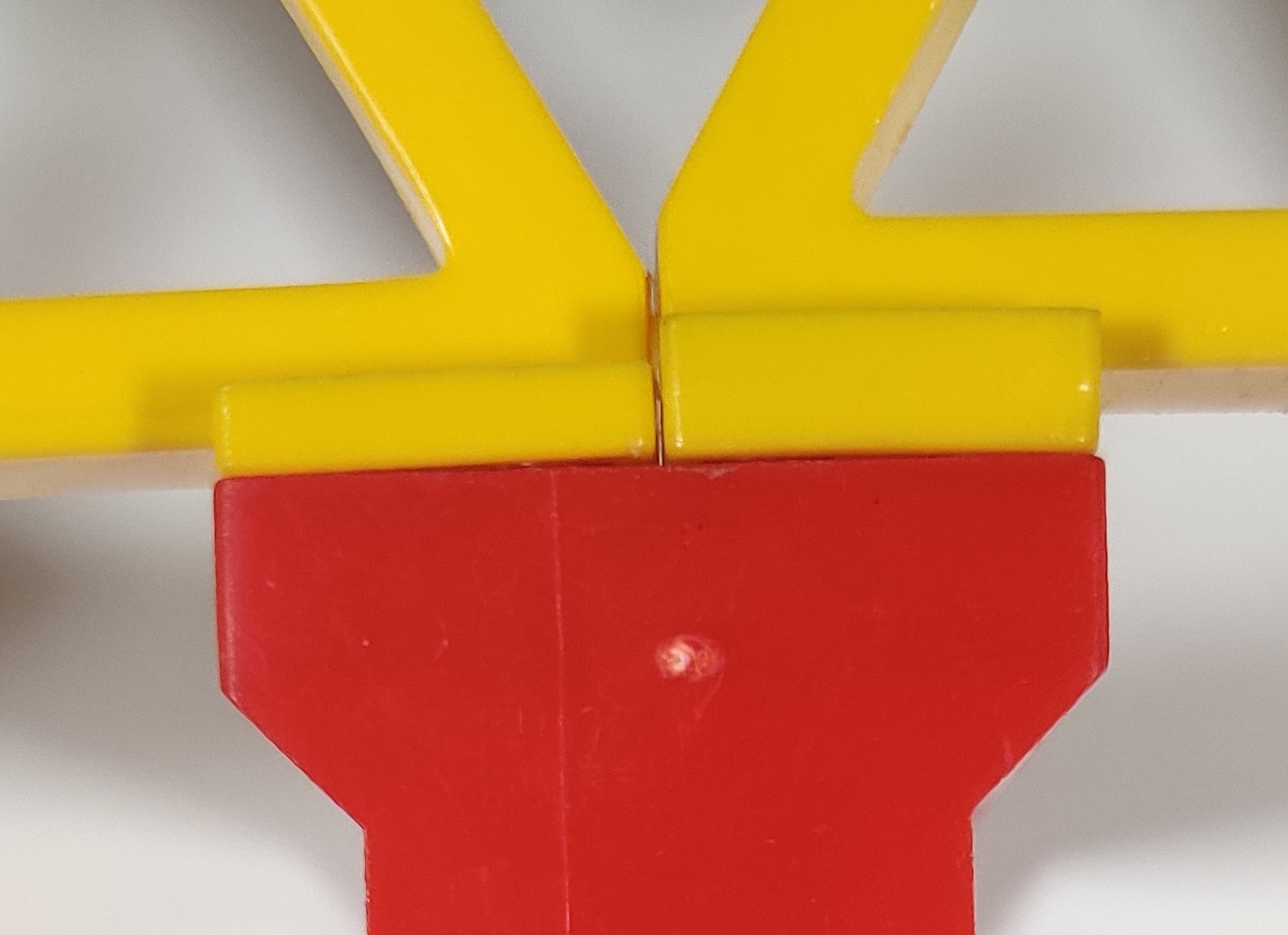
Earlier Thailand girders have taller studs on top, presumably to ensure a more snug fit with an additional girder stacked on top. Earlier studded bridge sides, like many early pieces of Tomy Train, seem to shrink and warp, usually curving inwards (this also happens with old Plarail iron bridges). The anti-stud connection to attach it to the risers is not very deep and has no "tube" like a LEGO brick. Funnily enough, the deeper connection sockets on the newer bridges work well on the old taller girders, and the older bridges work better on the newer girders with less tall studs. Perhaps at first Tomy thought it was worth it to have taller studs so people could stack tracks but with time realized the adoption rate of the bridges was far greater than anyone having enough track and girders to make multi-level tracks and decided to focus on bridge compatibility instead of stacking stability.
1306 Road Crossing (1988)


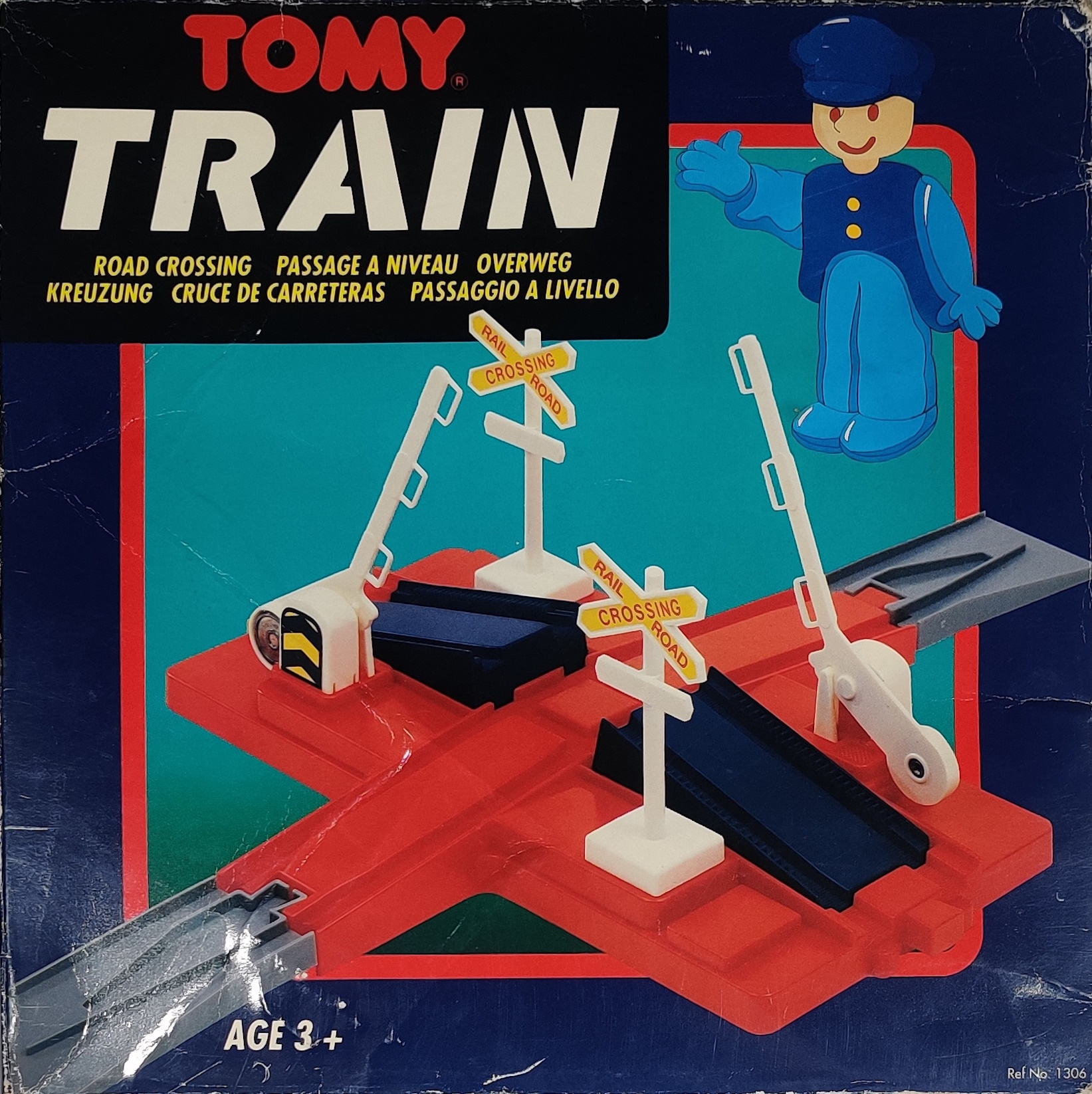


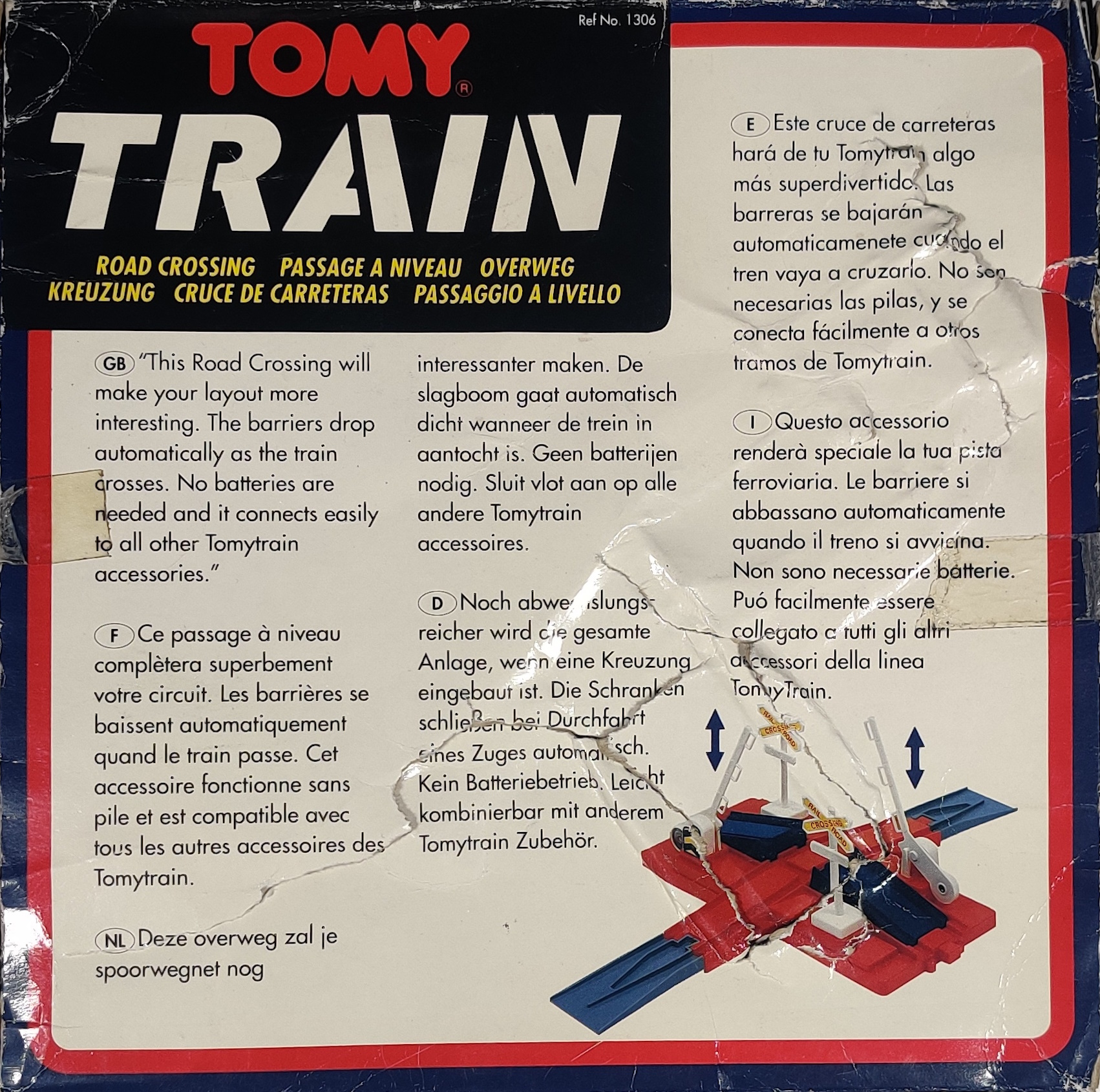
The Tomy Train railroad crossing incorporates the automatic weighted boom gate system used on Plarail crossings since the mid 1980s. Racks in the activation rails slow the train down slightly as it passes.
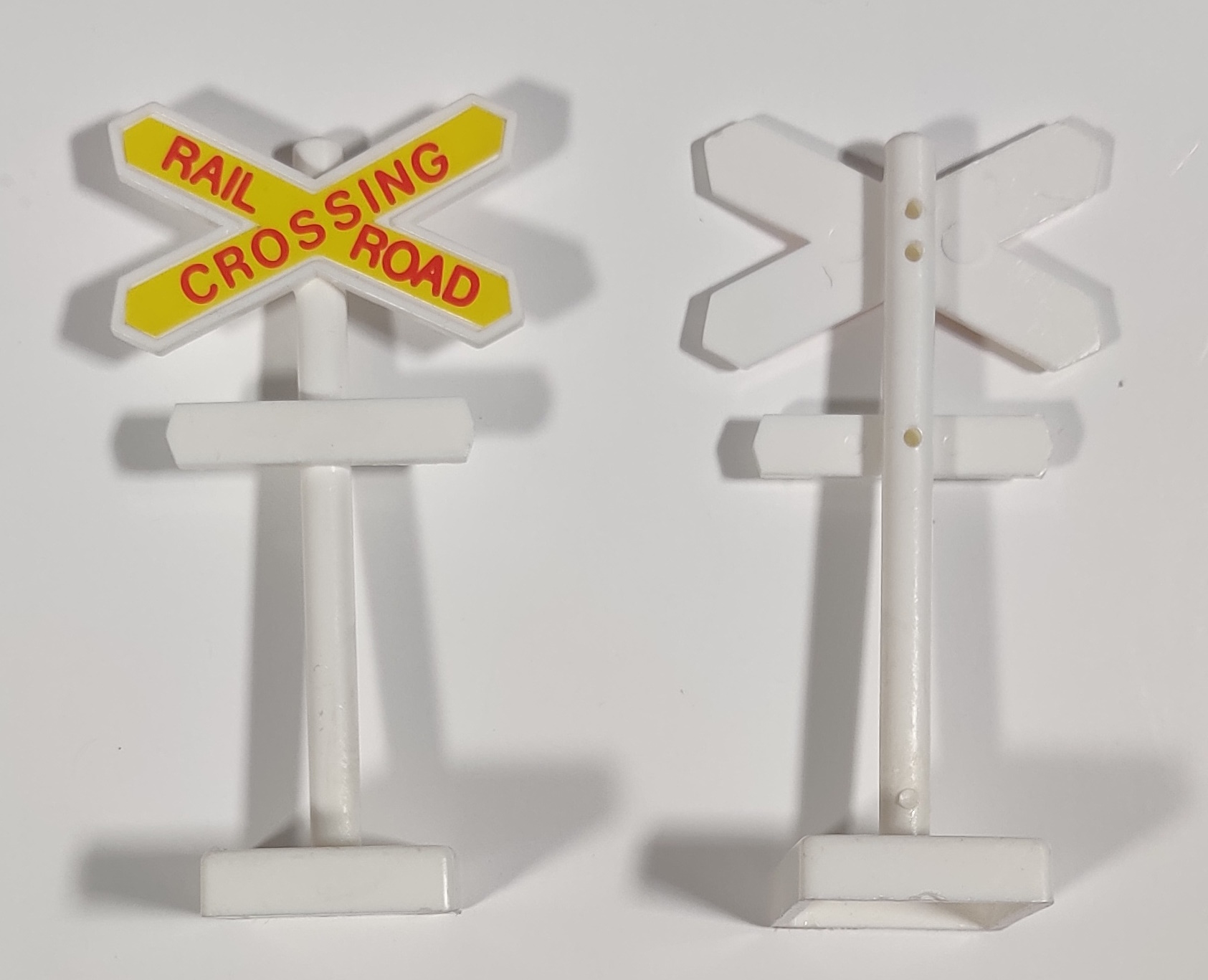
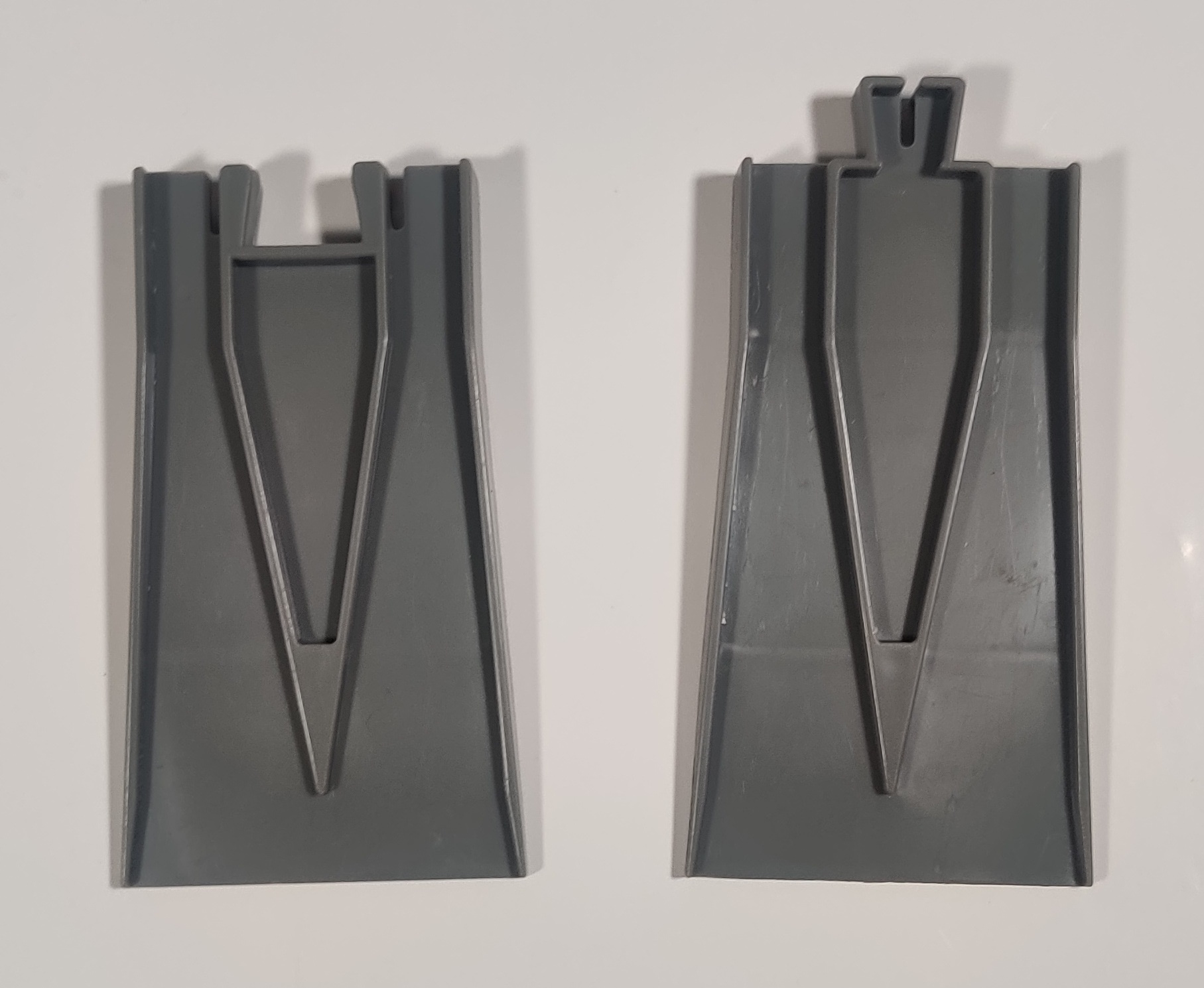
The regular release, sold from 1988 to the mid 1990s first in TOMYTRAINS packaging and later the TOMY TRAINS style seen above, includes two road/track ramps and two railroad crossing signs.
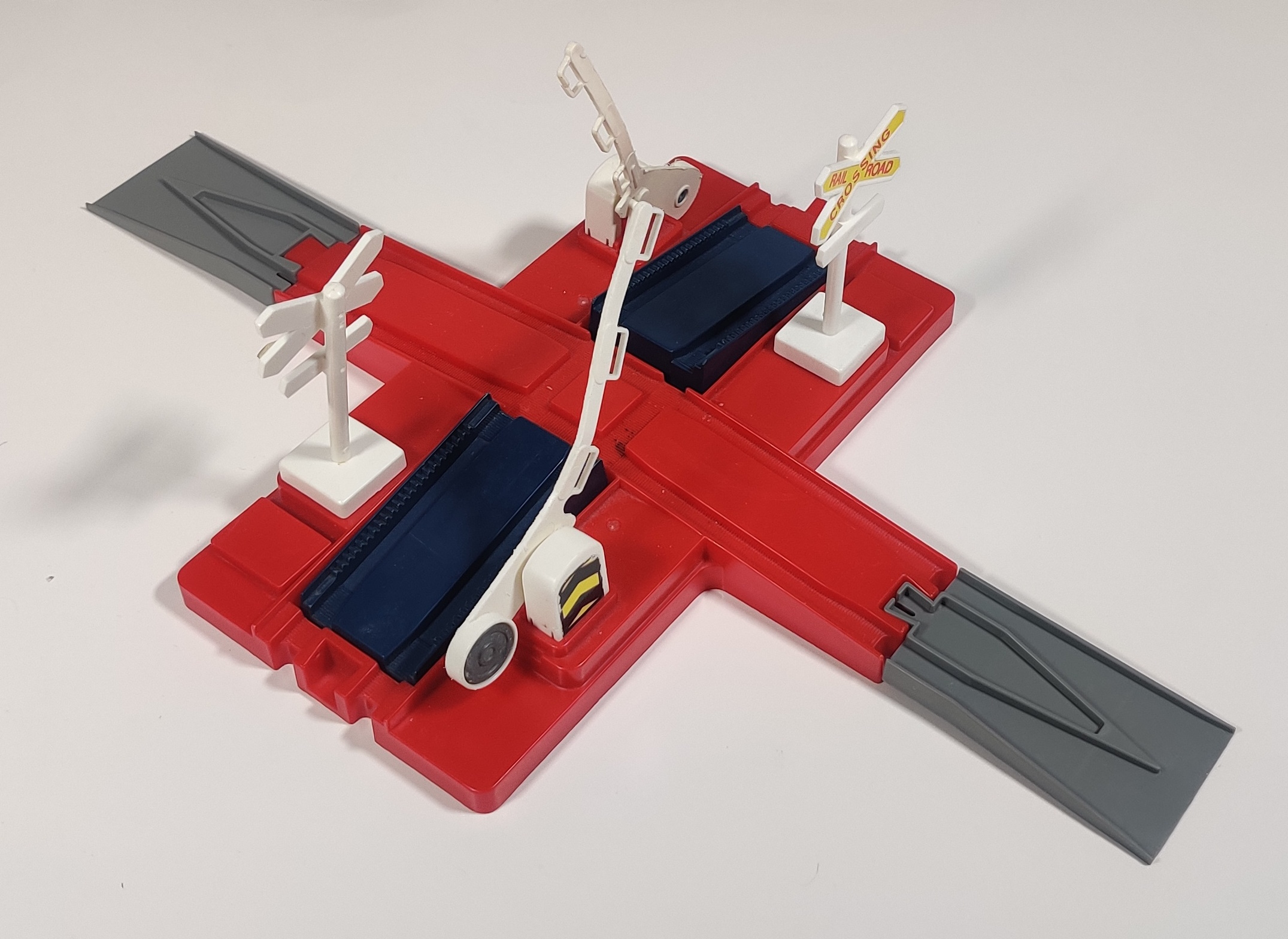
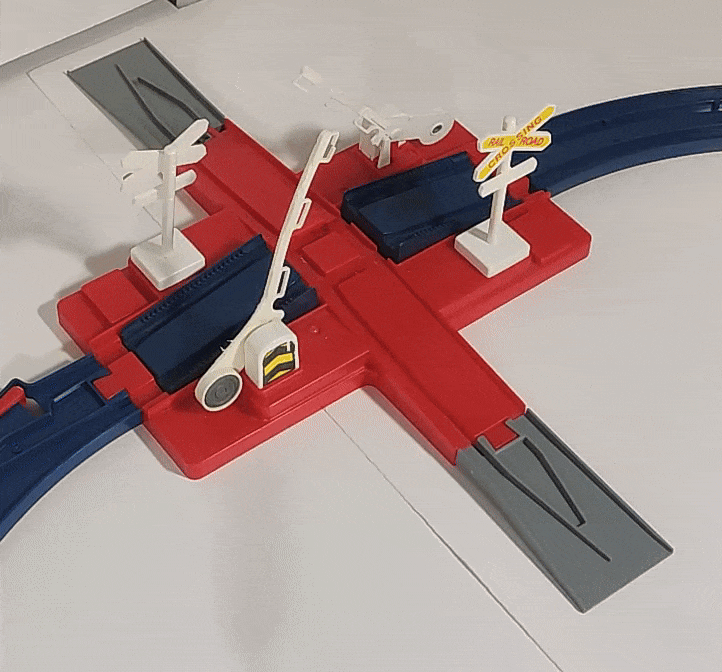
Instead of having a generic flat "road" surface for their crossing like Plarail had at the time, the Tomy Trains road crossing uses the rail standard for the crossing line and has two ramp pieces to allow the Tomy Train vehicles, which also adhere to the regular rail standard, to cross. This opens up the crossing (and system in general) to lots of cross-play - remove the ramps and make a figure-eight crossing railroad, or use the ramps to run trains onto the floor or in sidings or yards.
The boom arm system on these crossings is often broken in some way, as the Plarail versions often are.
1307 Two People (1988)
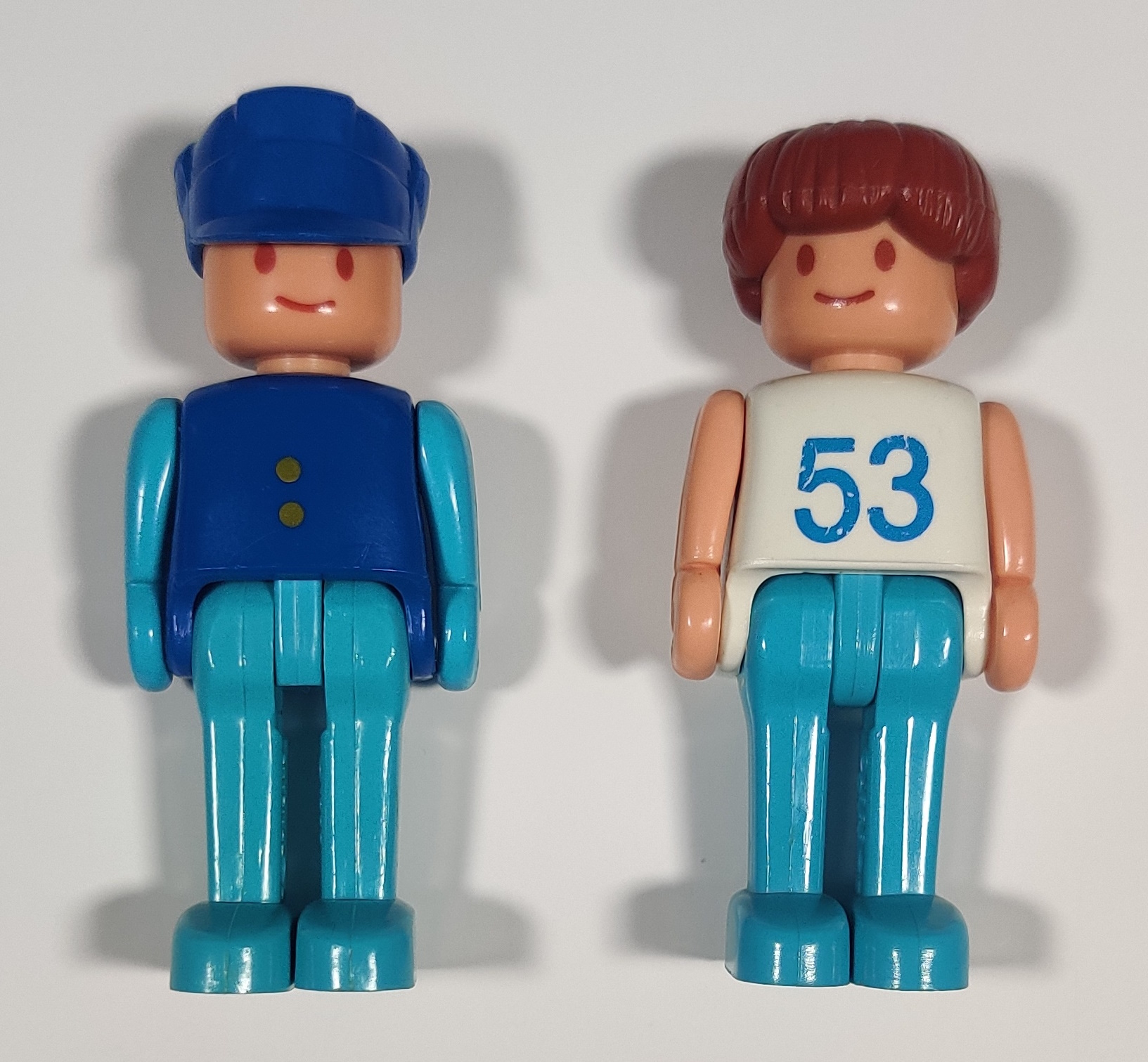
Two Tomy Train figures, the blue driver figure and the passenger in the "53" shirt.
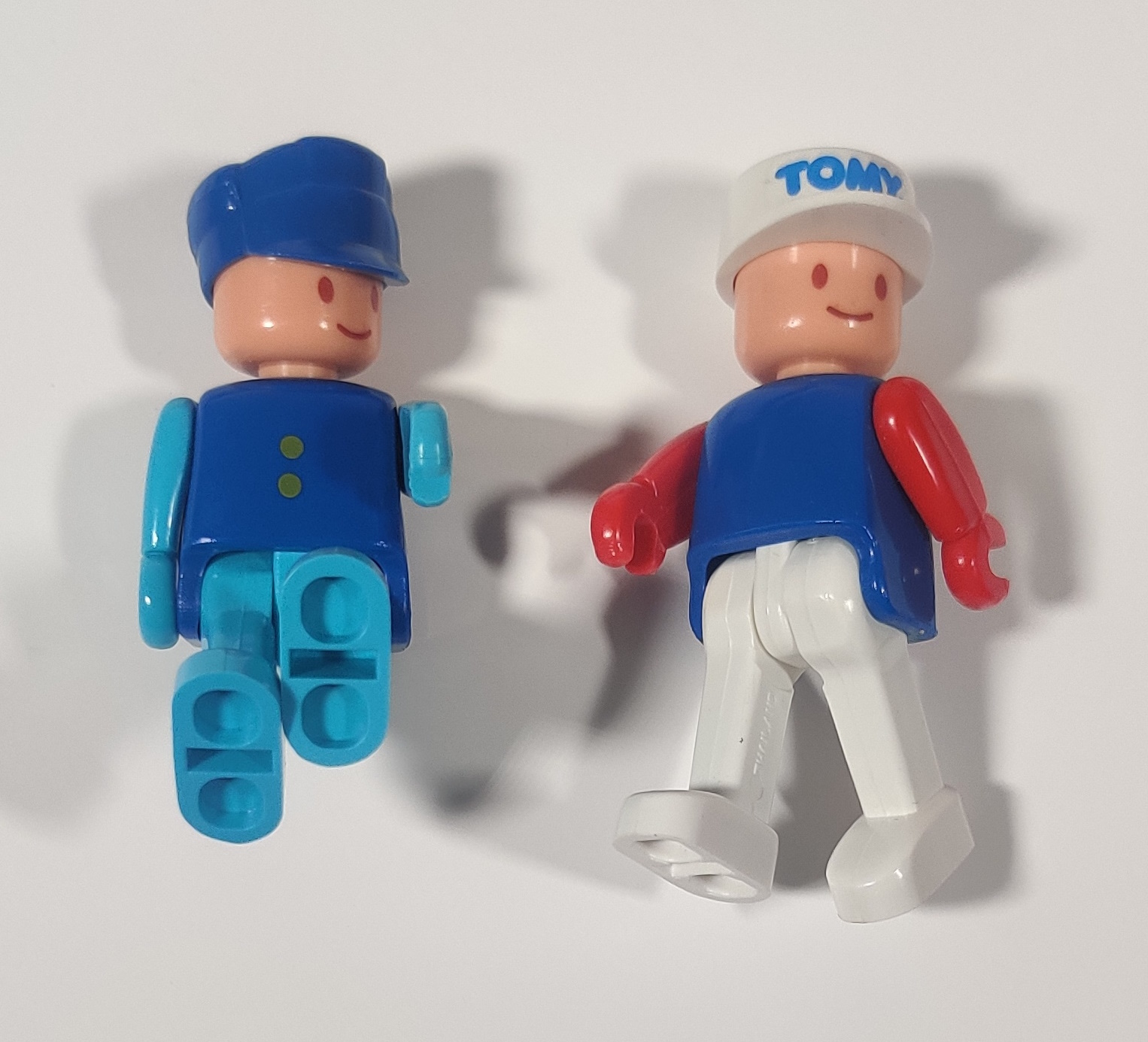
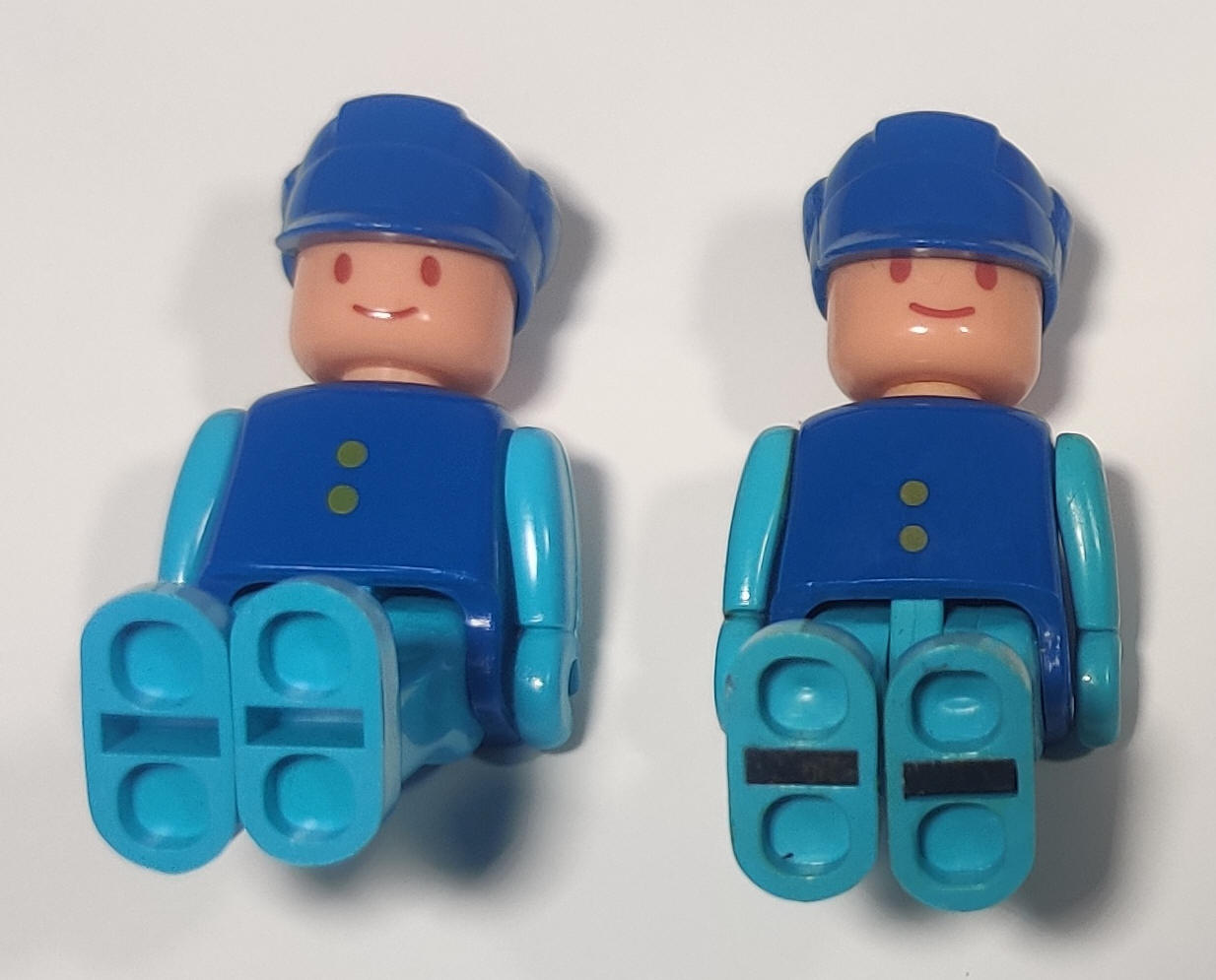
Tomy Train figures are very nicely articulated, with individually moving arms and legs and swiveling heads. Later figures (1990 and on) have magnets in the feet to interact with action accessories, but earlier figures have the deep rectangular cutouts used so it seems they may have been planned from the beginning but not implemented for a few years.
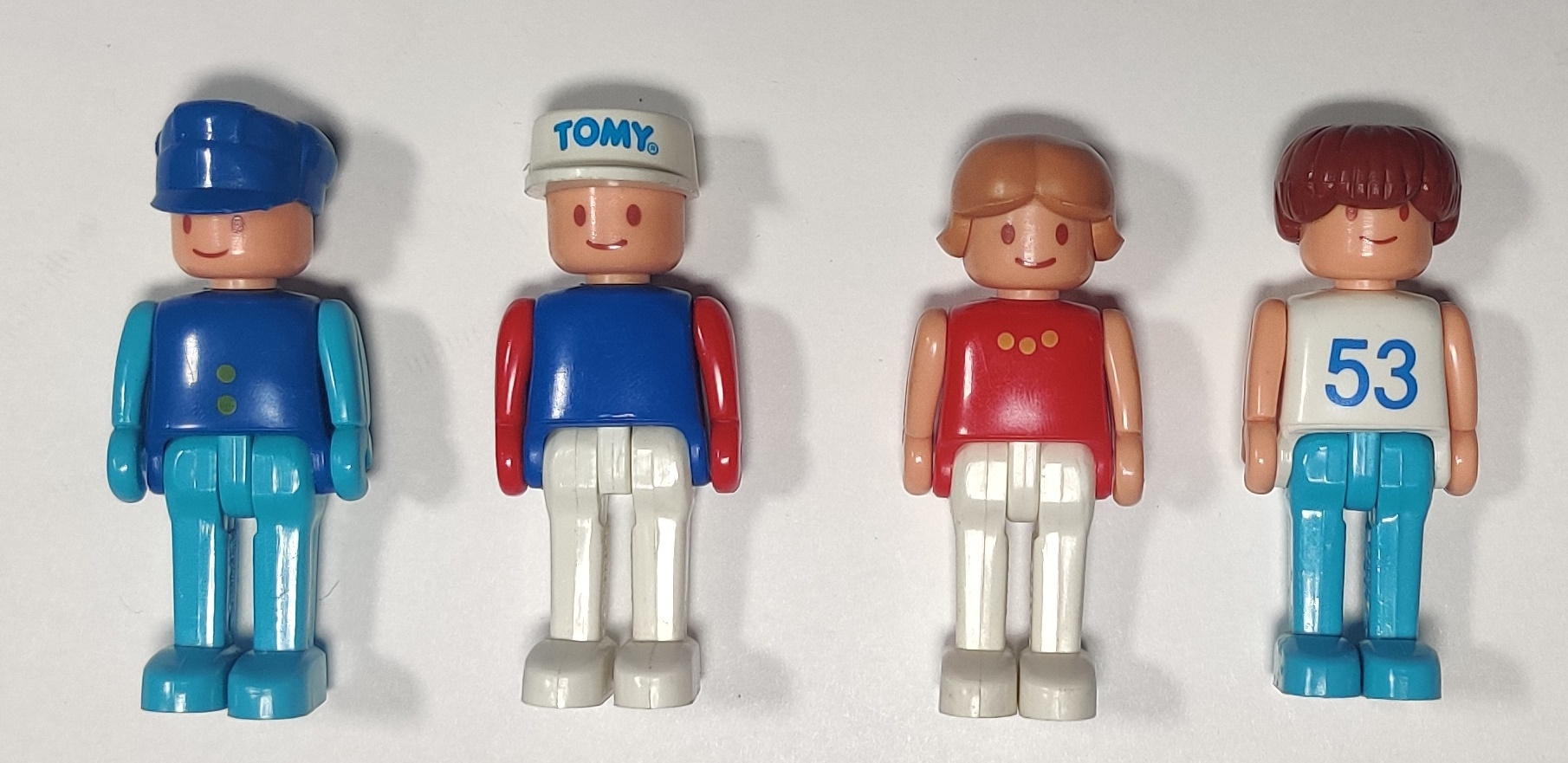
The most common figures are the blue driver figure, TOMY-hatted worker figure, and two passenger figures. Later on, other figures were developed for the Thomas range as well as specific sets and the later Tomy Trains sets.
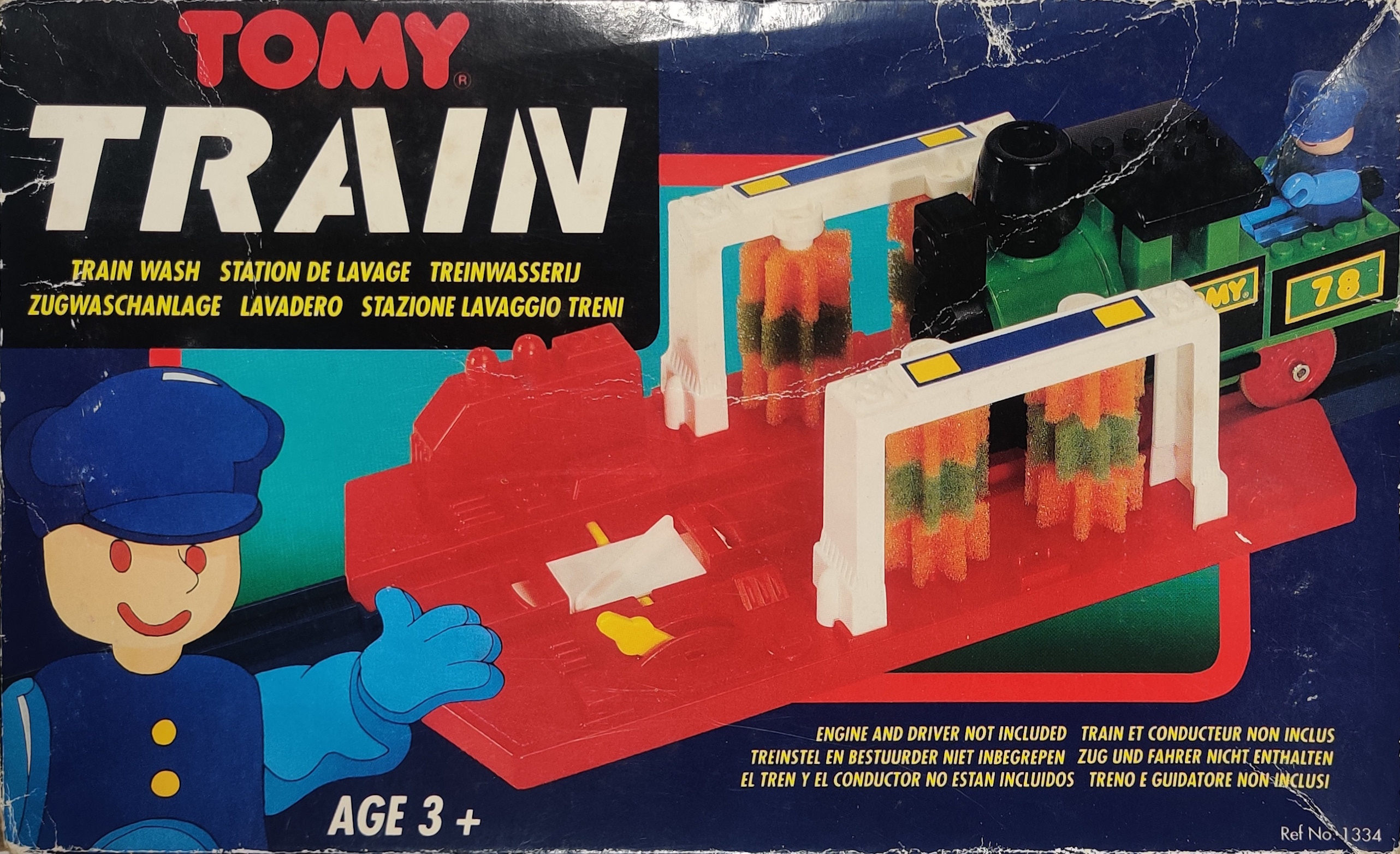

When the European range was updated to the curvy-logo Tomy with the stencil-style Train packaging, the blue driver figure was given the name Tim the Train Driver. He appeared in multiple U.K. "Trainspotters Handbook" catalogues and on the rear of boxes, with many portions of text written from his perspective.
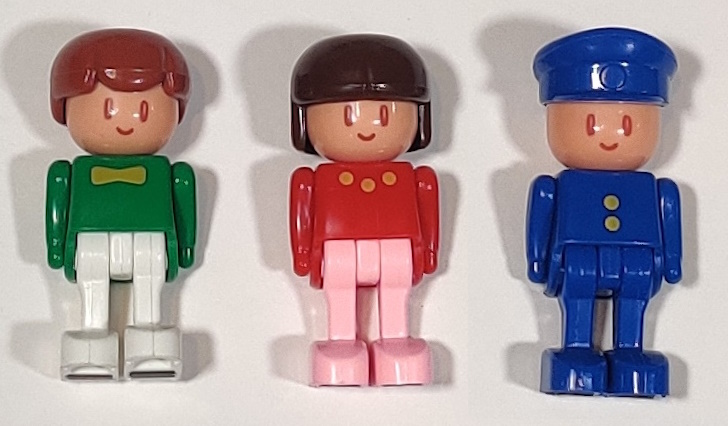
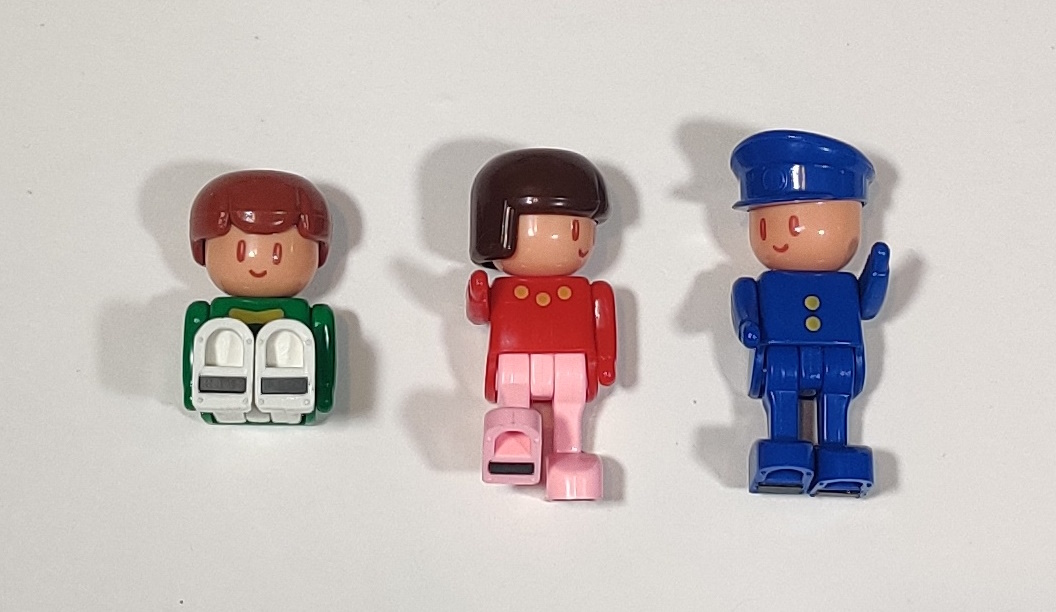
The Plarail Doll Play series that started in 1993 used similar "Doll Play Doll" figures with magnetic feet and articulated limbs that were based on the Tomy Train figures.
1308 Station (1988)

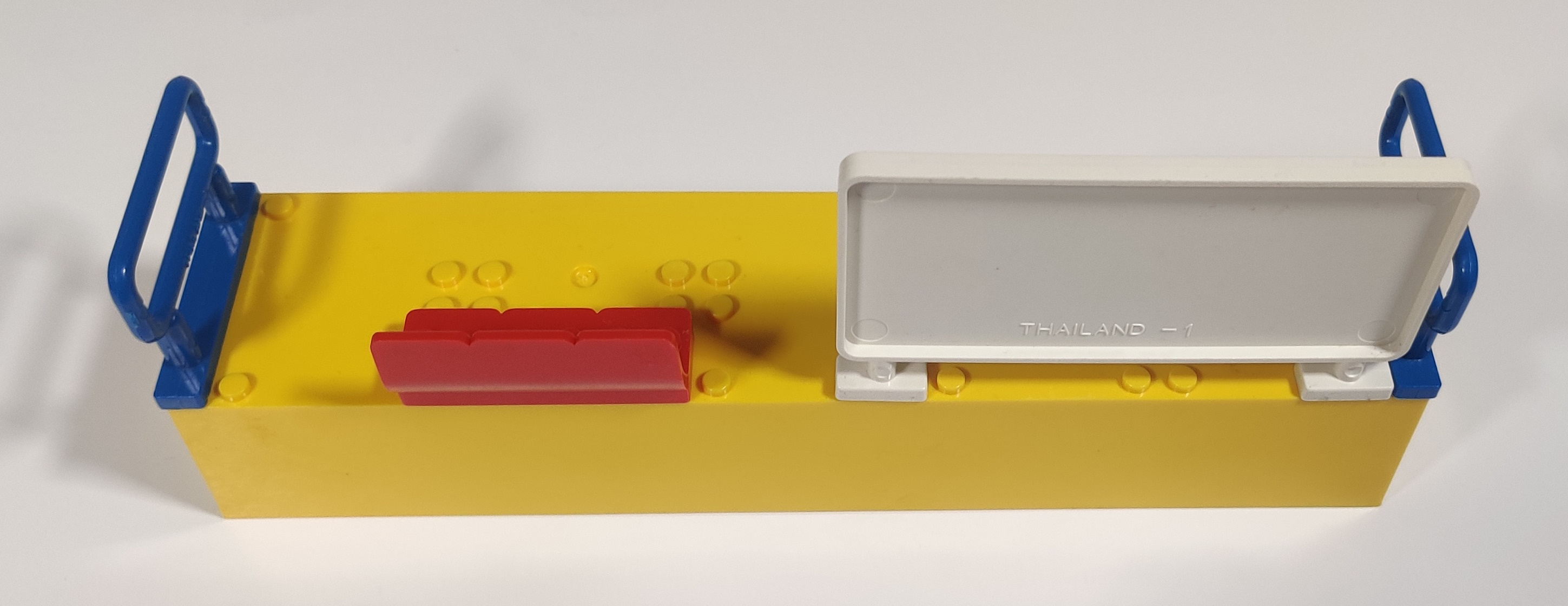
The initial Tomy Train station system used a wide plastic base piece with studs on top and a few small accessories like a hand railing and three-wide row of seats as well as a big sign with several different sticker designs. Early signs are single-sided while later ones have stickers on both sides.
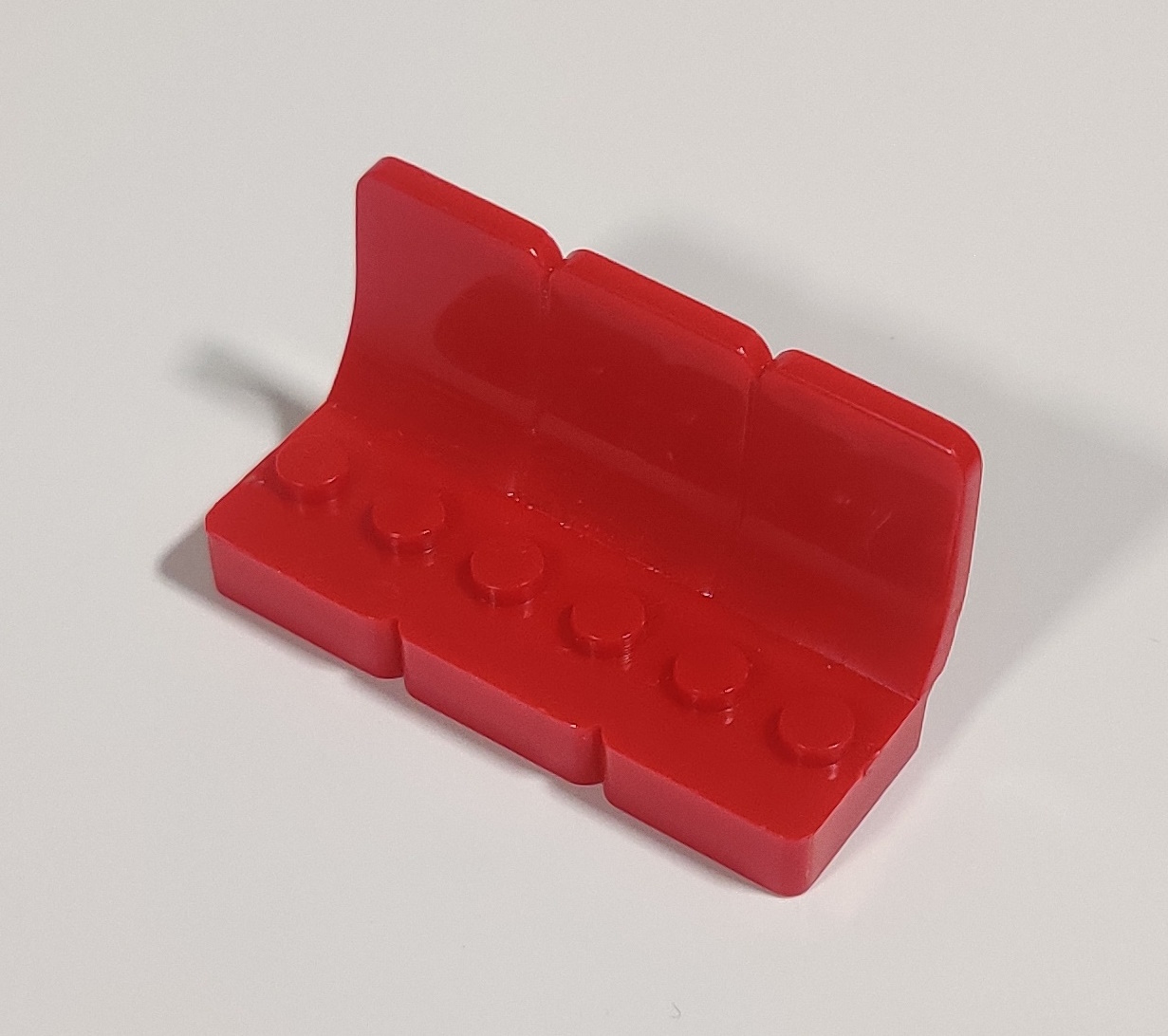
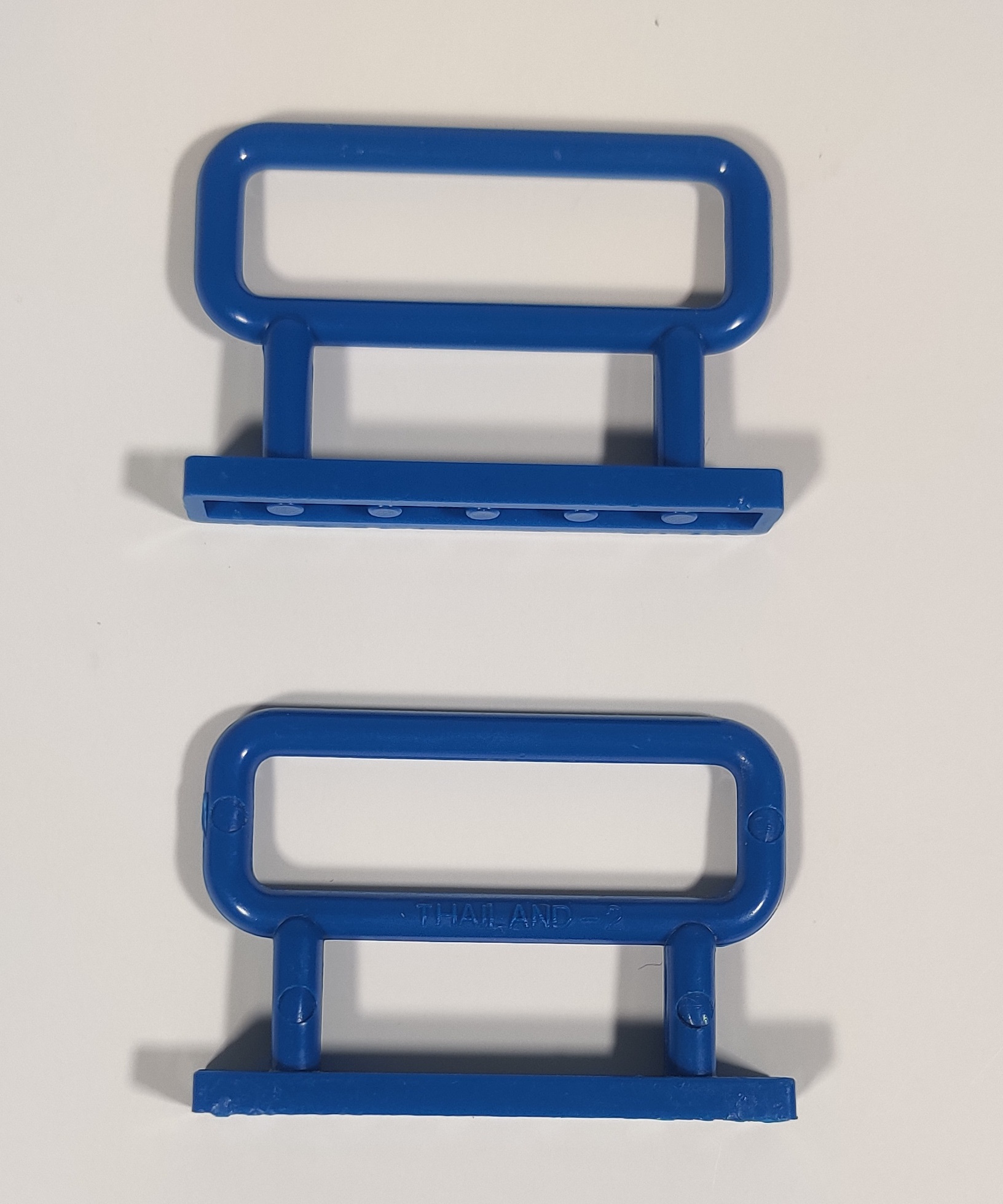
As advertised on the box, of course, you could build whatever station you want out of building blocks on top of it.
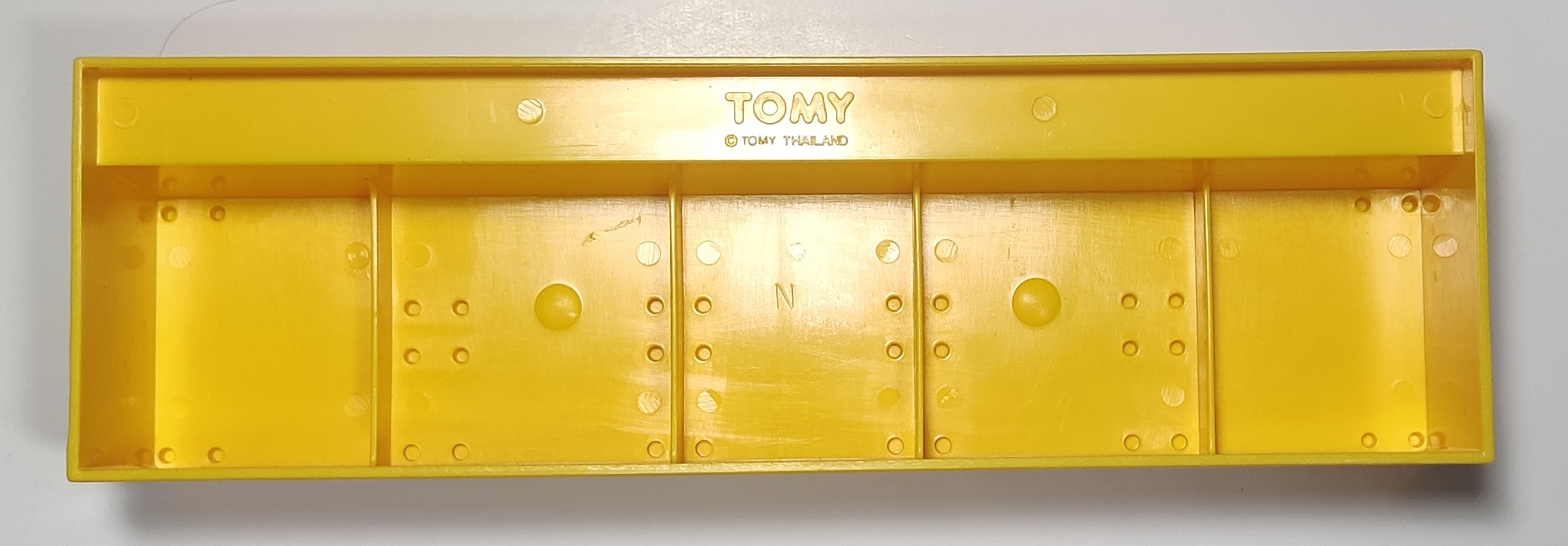
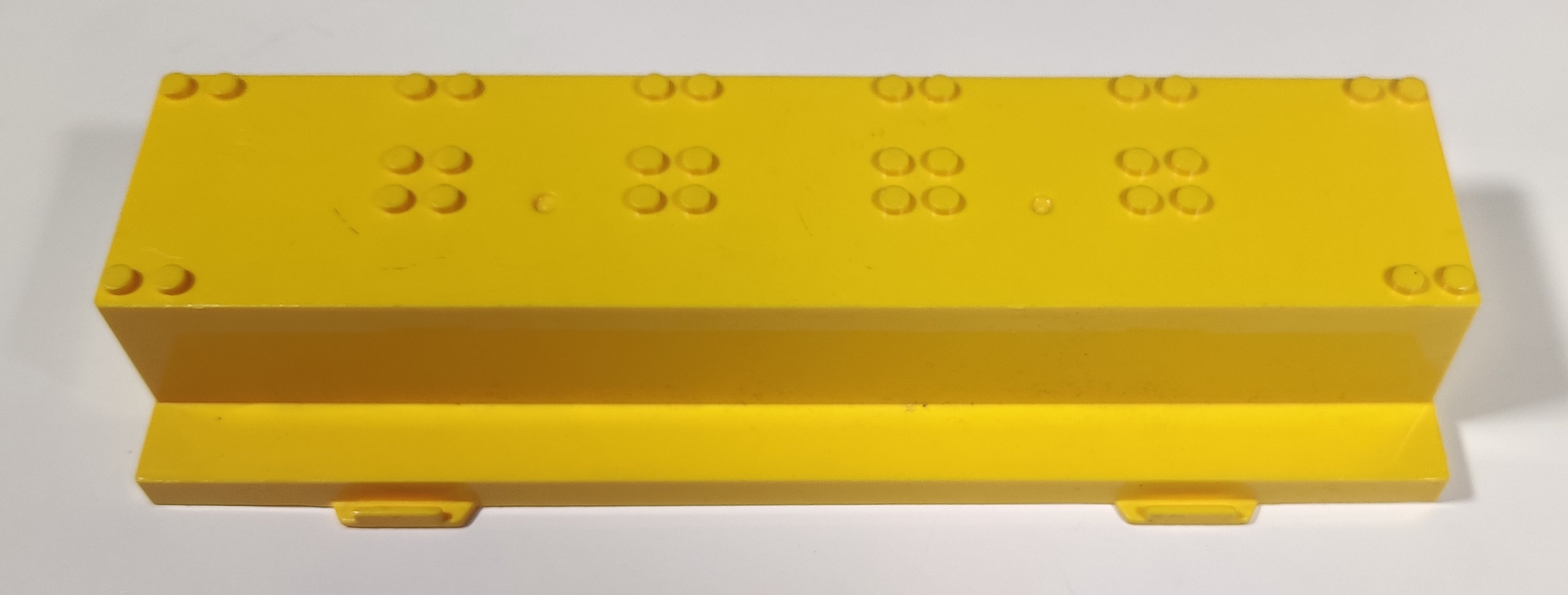
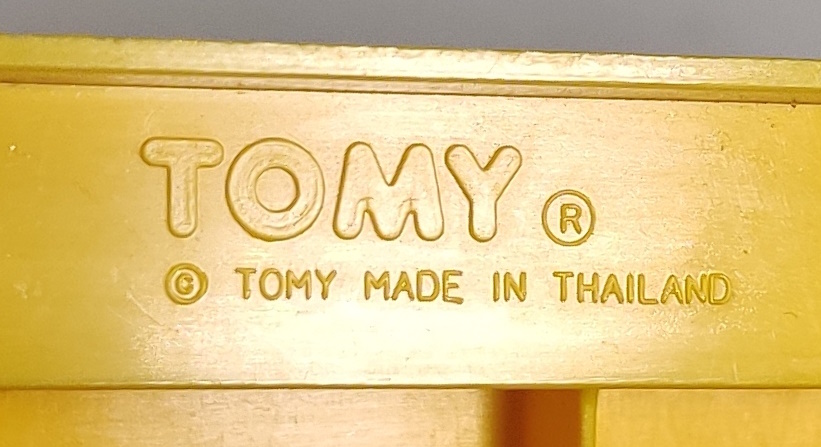
Early on, these bases did not have a track clip to affix them up against the track, but this was added in the 1990s as well as updated manufacturing text.
1309 Crane (1988)
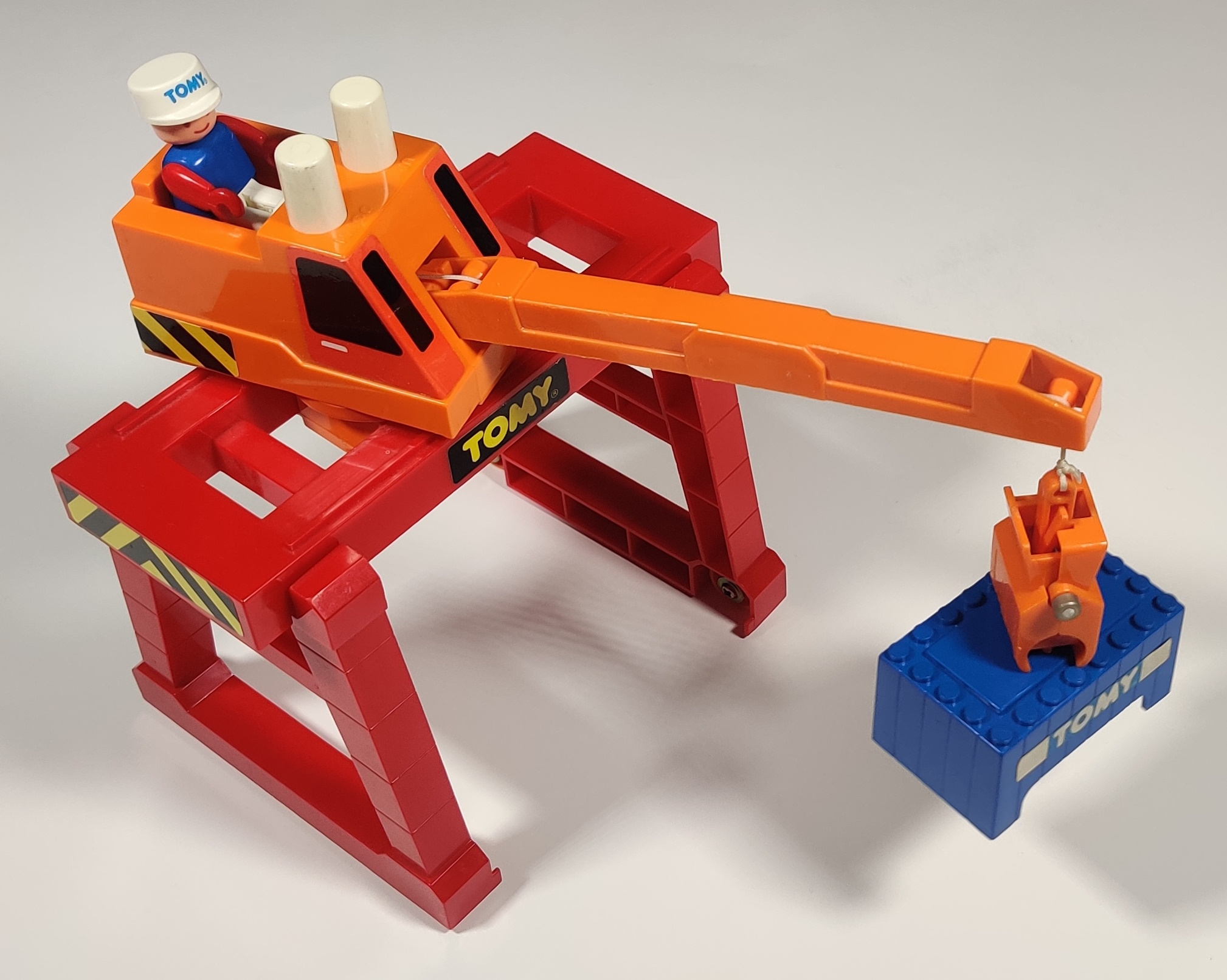
One of, in my opinion, the coolest Tomy Train accessories - a rolling, operating gantry crane. The individual European TOMYTRAIN and TOMY TRAIN box releases includes the three-piece crane, operator figure, and blue container.


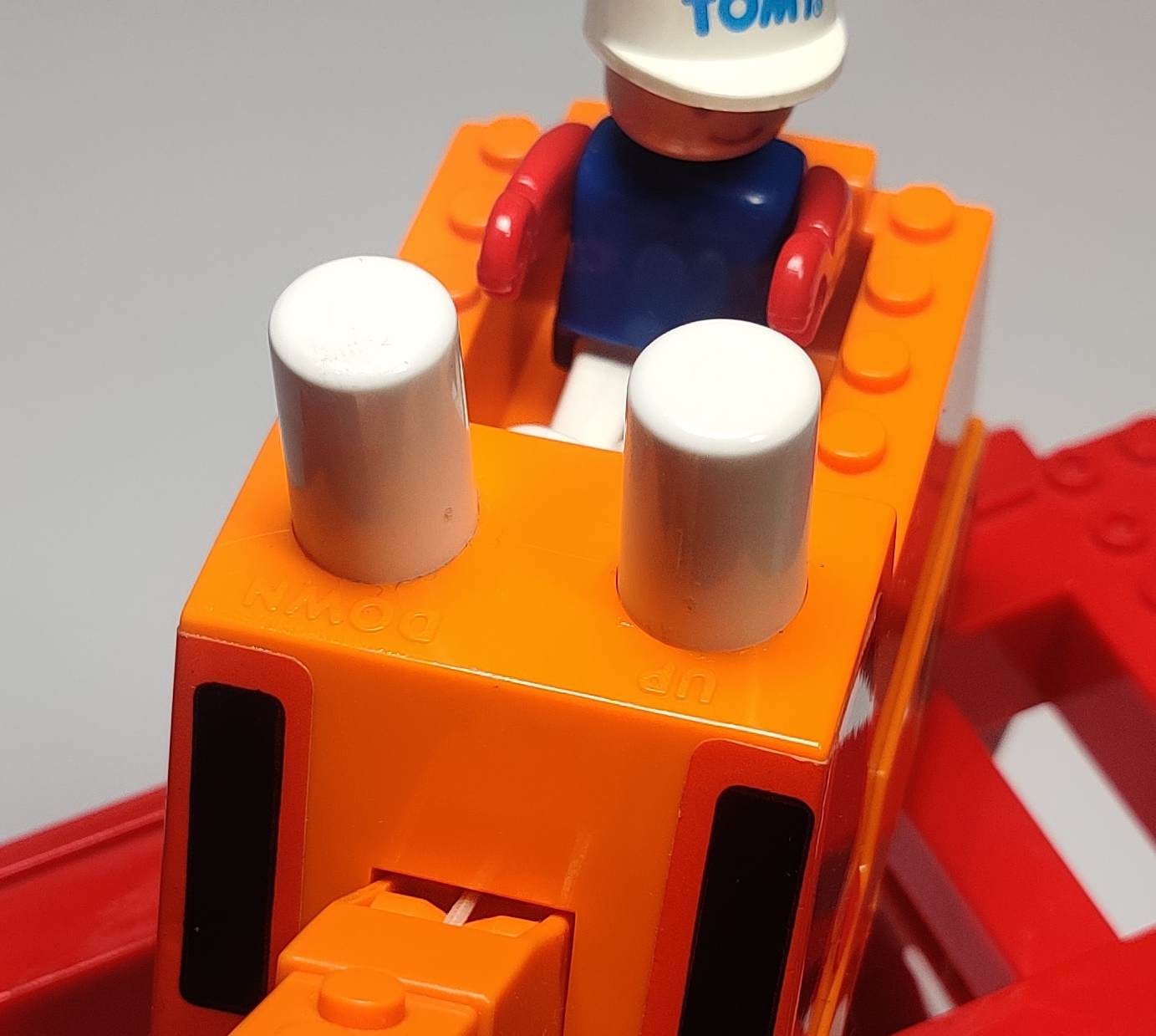
The gantry can roll back and forth and the crane carriage can shift side to side. The crane spins on the carriage and the boom arm raises and lowers. Two buttons control a ratcheting winch that raises and lowers the crane's claw.
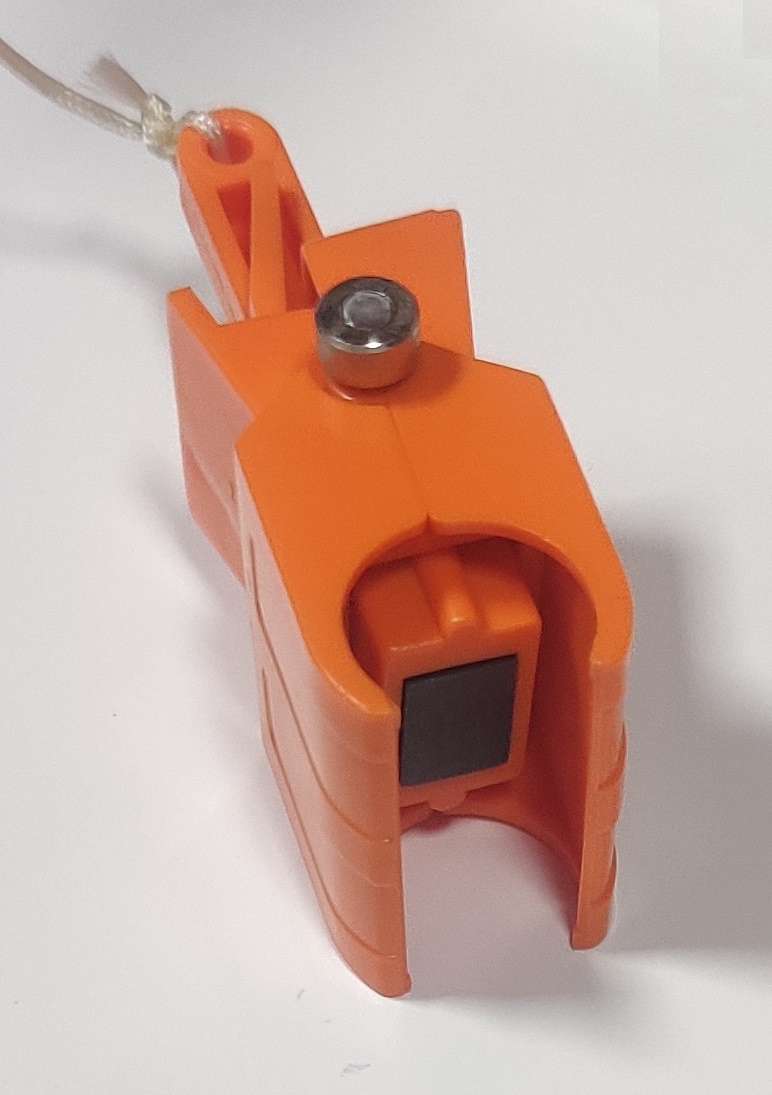
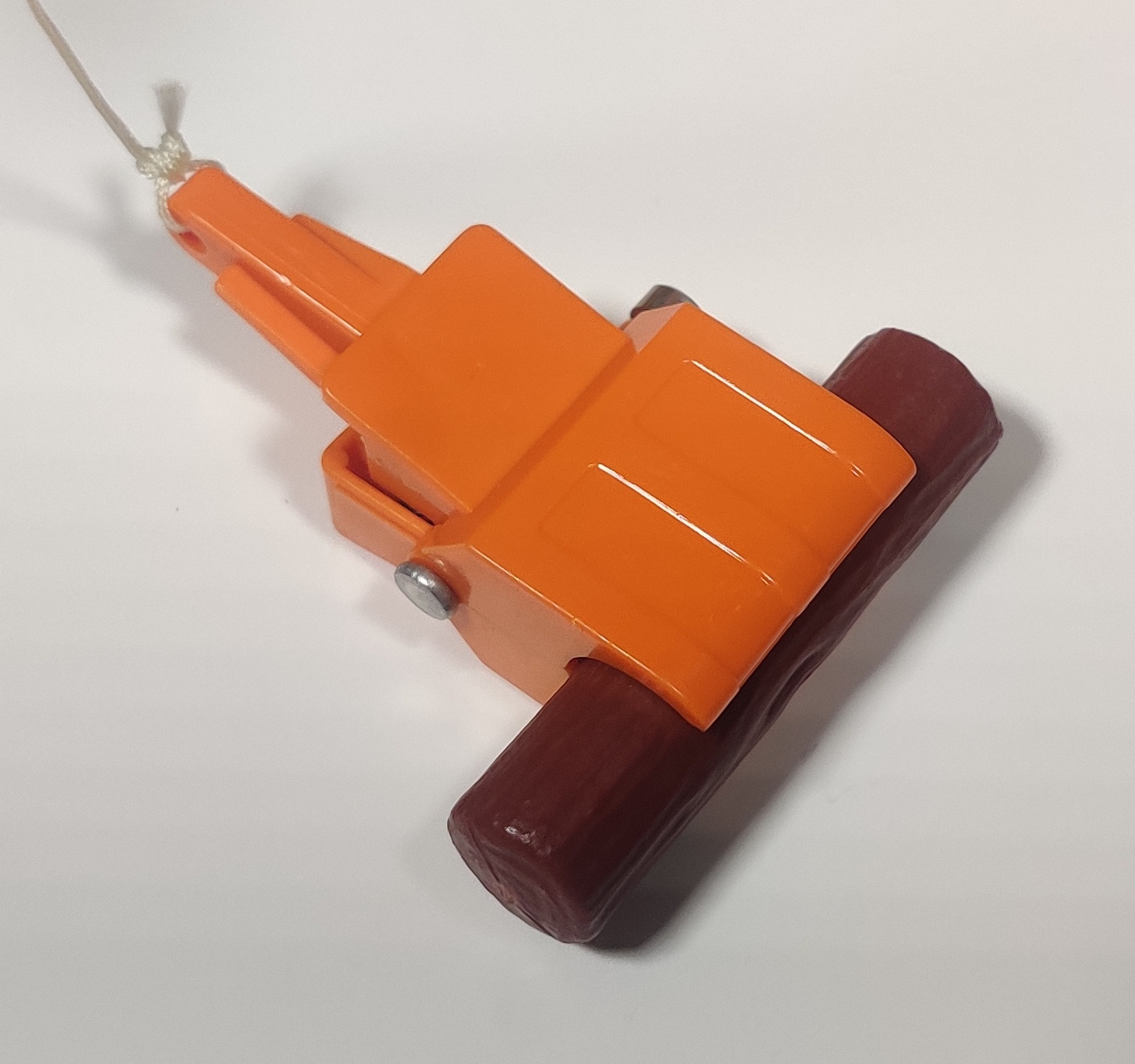
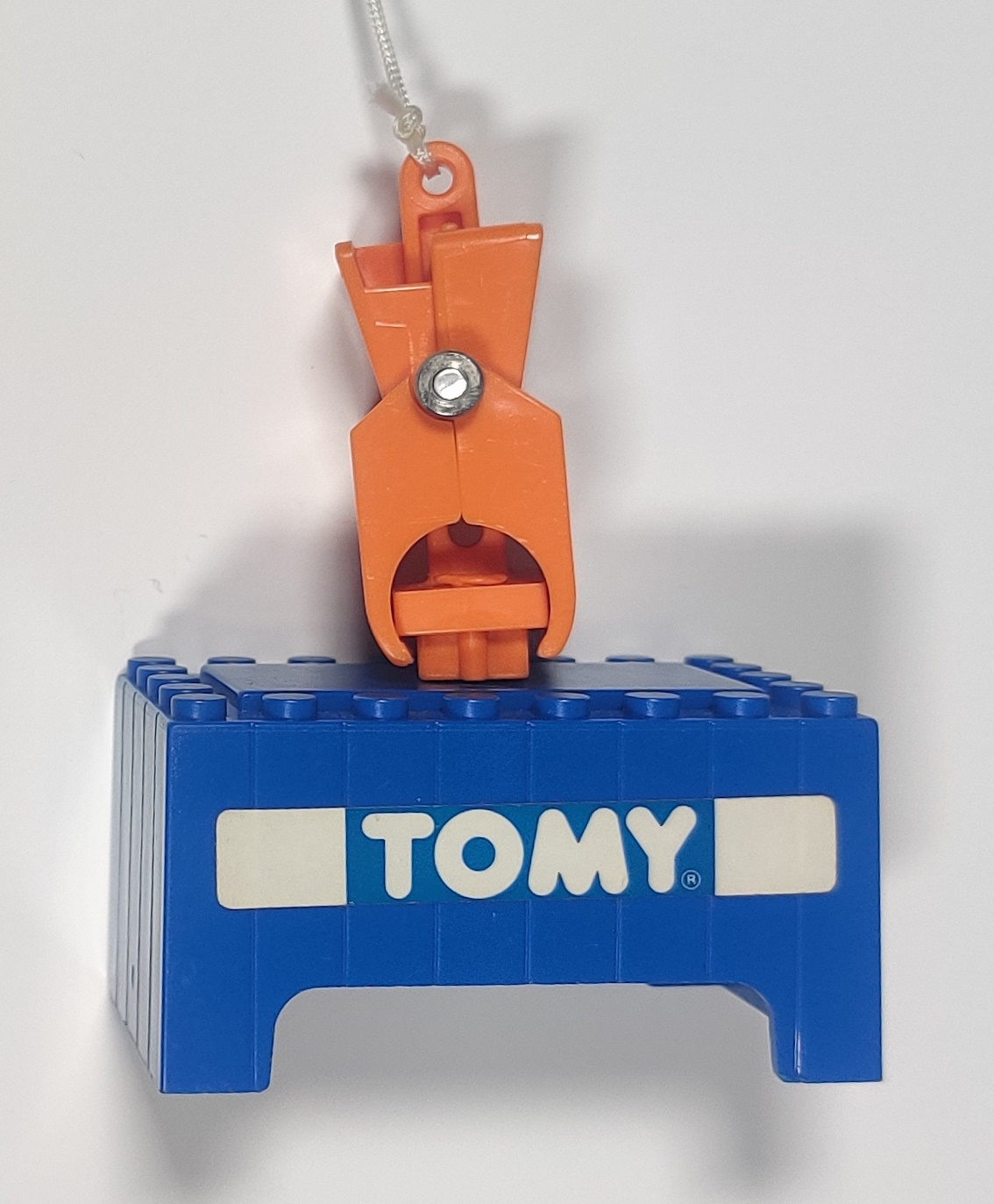
The crane's claw has two rounded jaws that fit around the log cargo pieces, which were a fresh tooling and different from the shorter Japan-made Plarail logs. Inside the claw is a recessed magnet that extends out to grab the magnetic container cargo when the two magnets are brought near enough. When the top of the claw is pinched, the jaws open and the magnet retracts back inside, dropping whatever cargo is in its grasp.
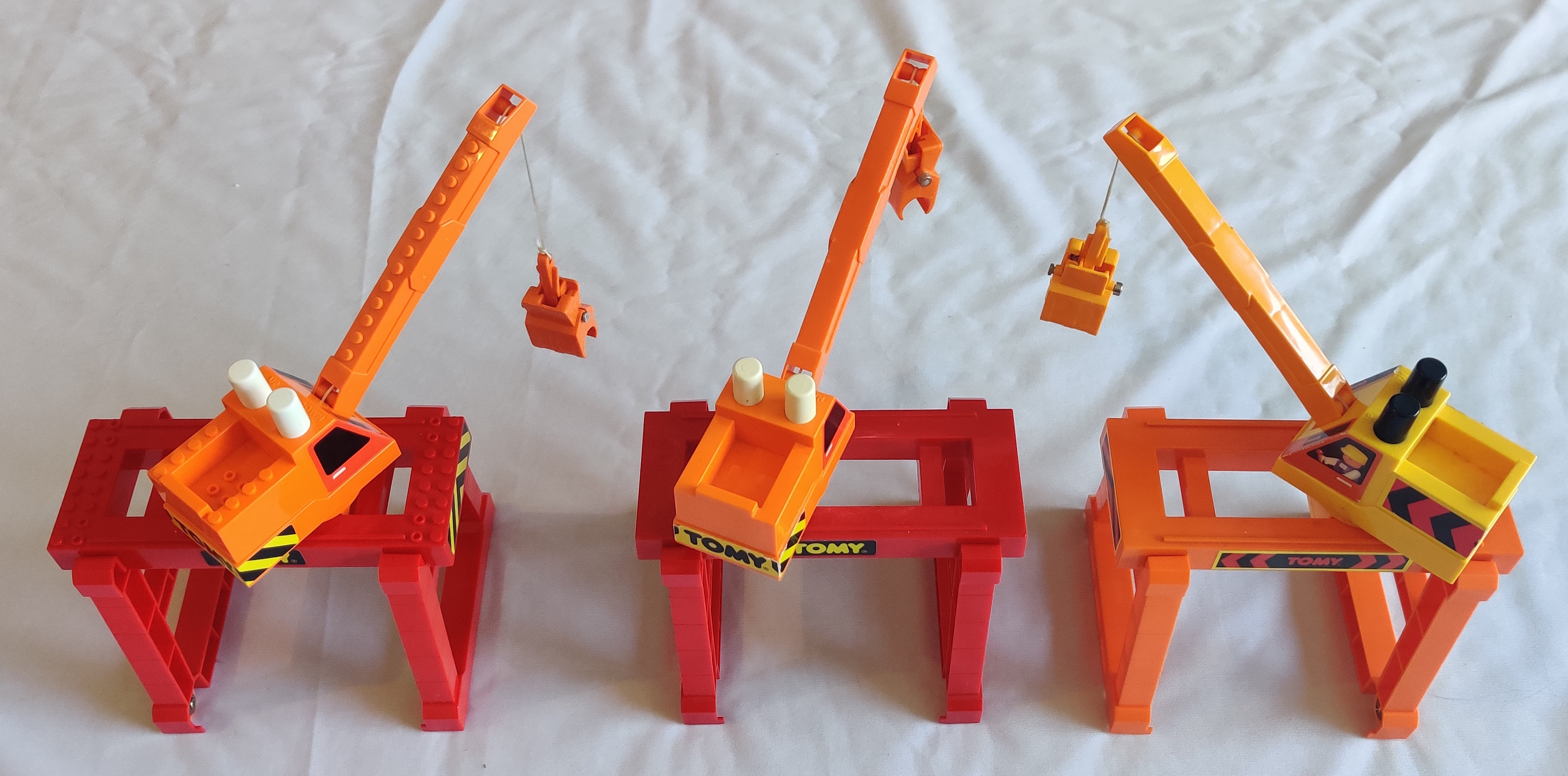
There are three variants of this crane - with and without studs, and the orange and yellow variant from the Busy Freight Train Set.
1310 Fork-lift Truck and Driver (1988)
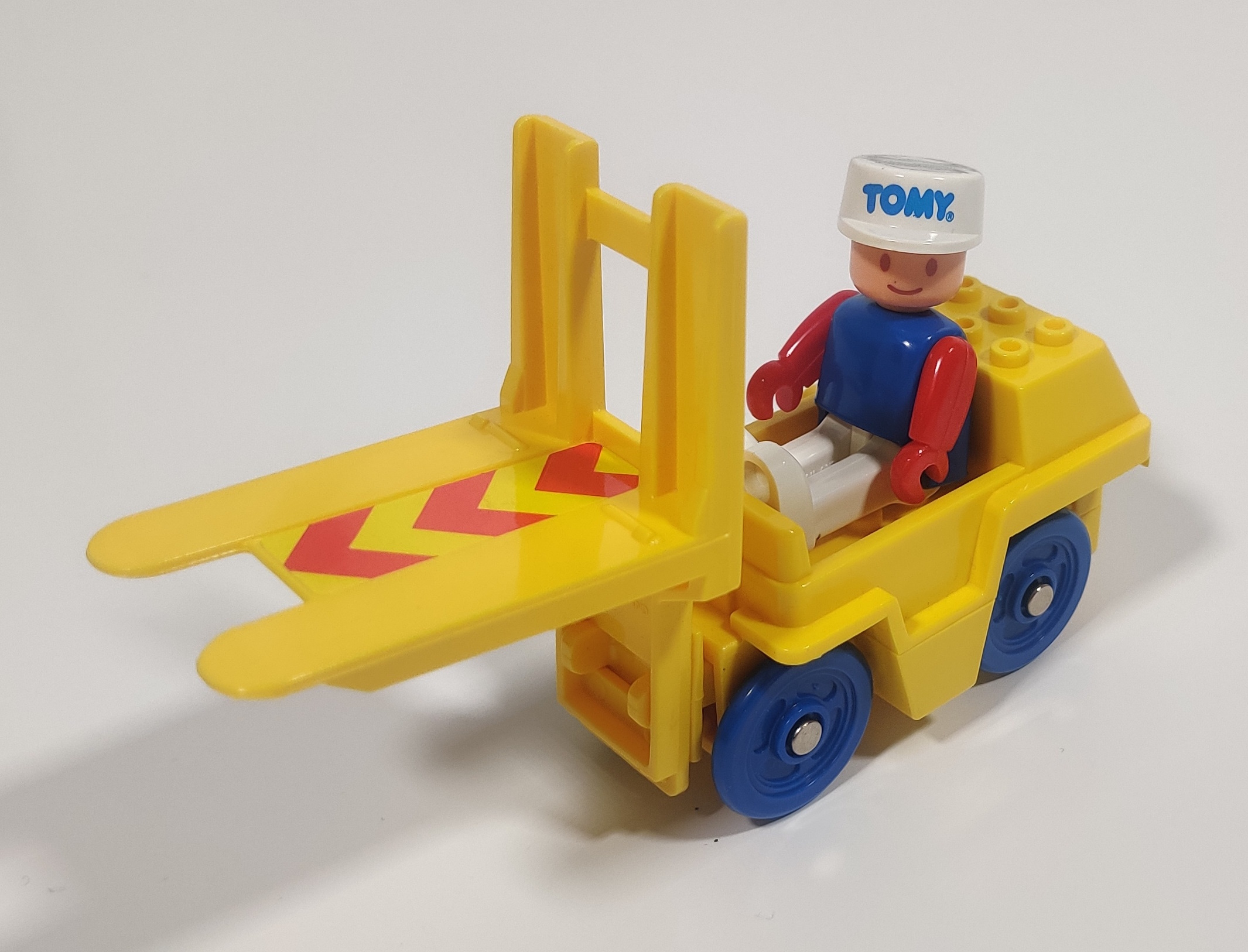
This neat little forklift can be used to load and unload containers from flatbed cars and station platforms.
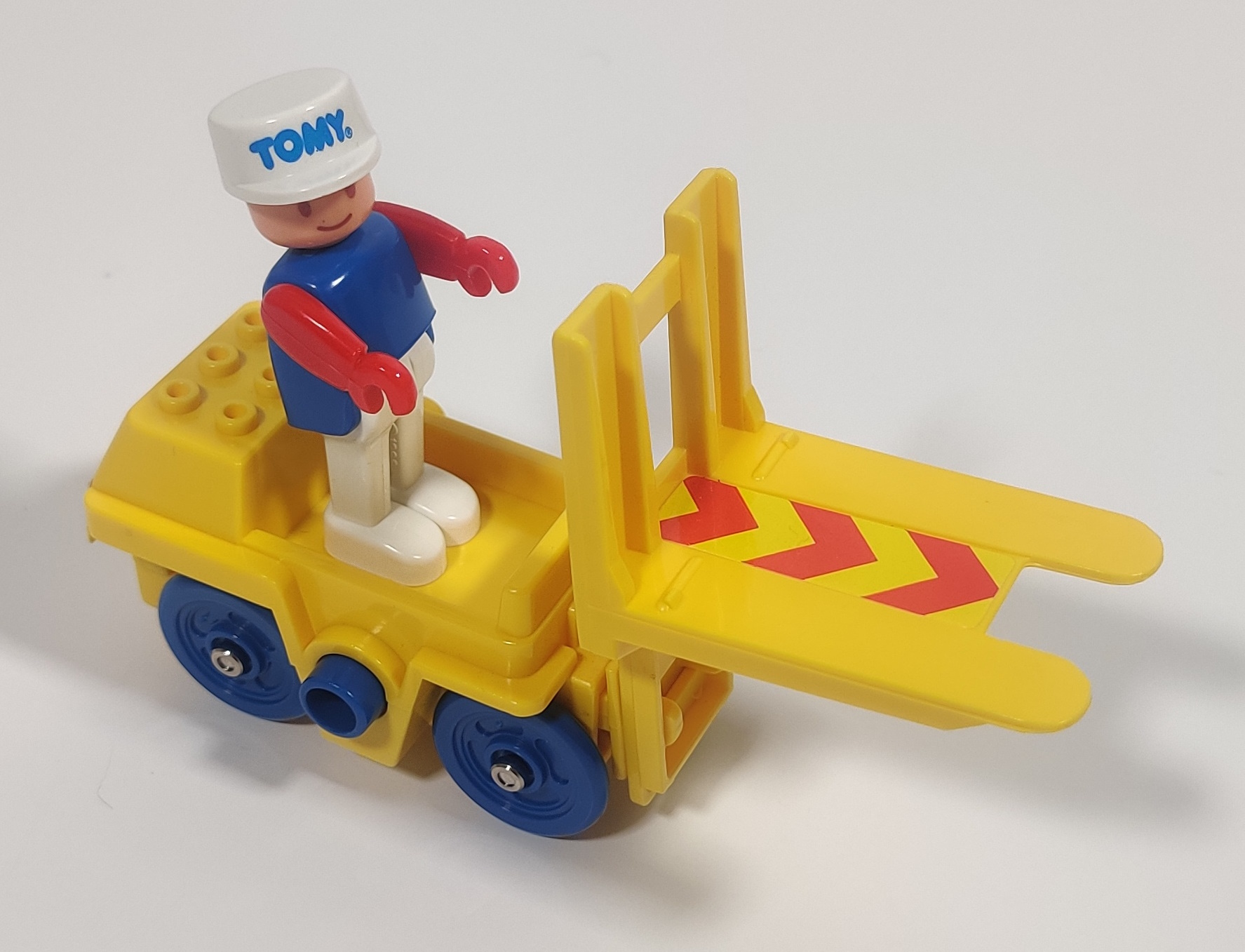
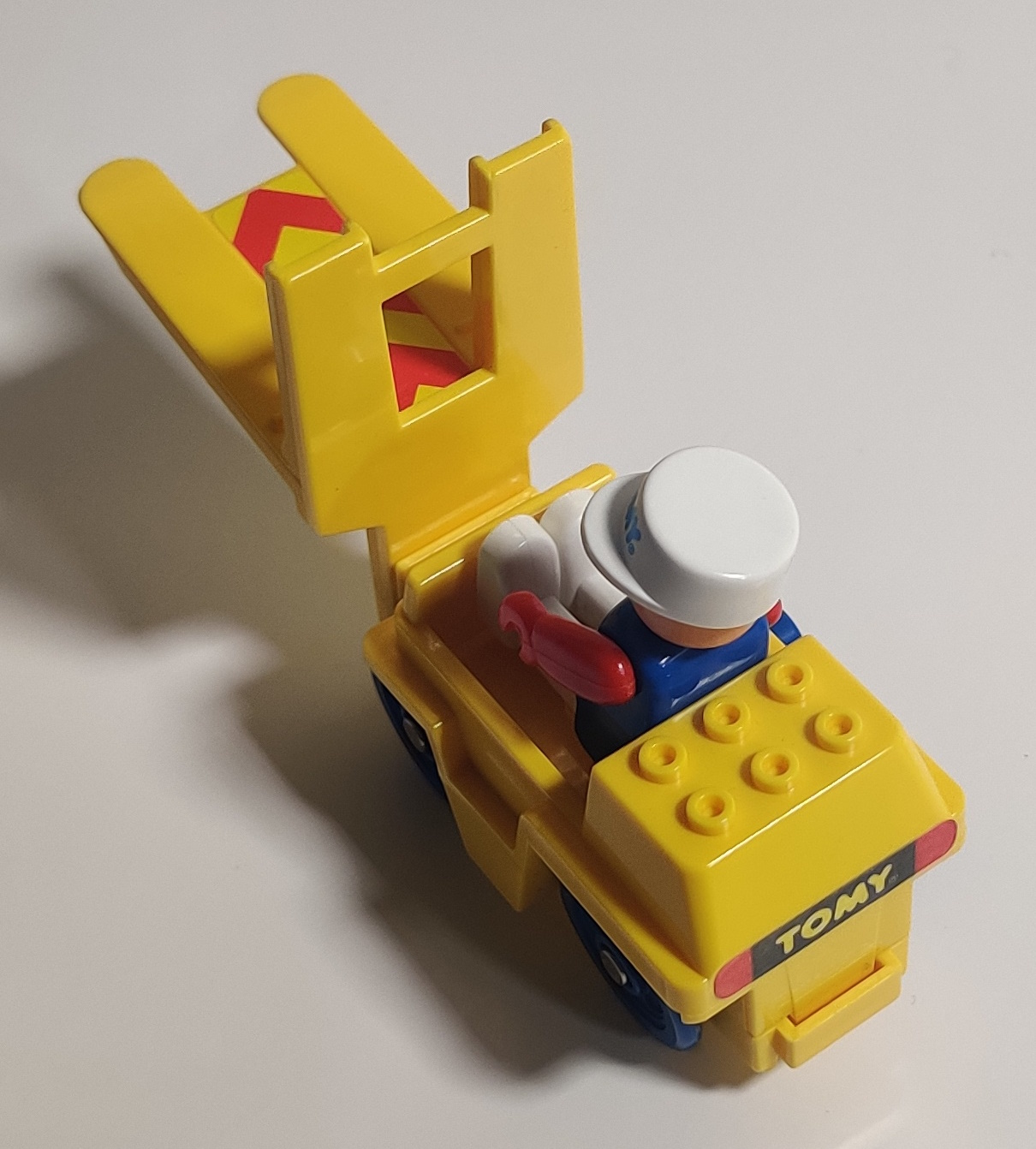
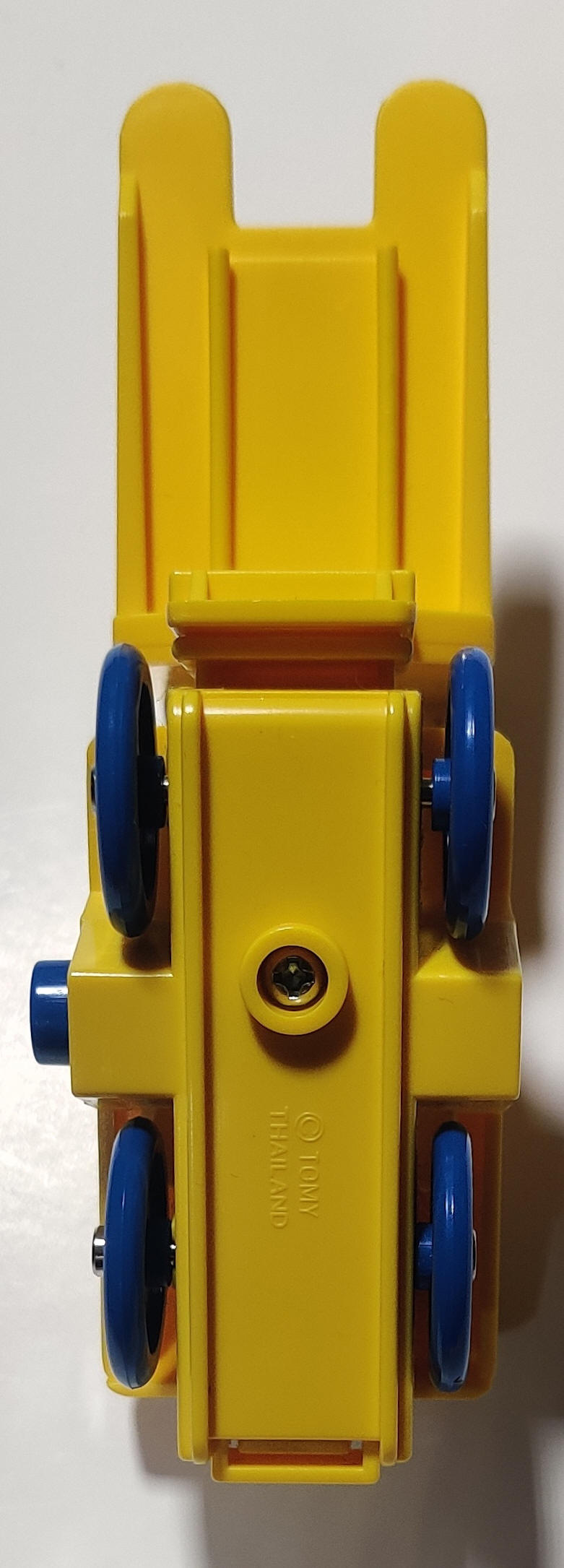
The fork itself is a separate clipped-in piece. Because it adheres to the Tomy Train/Plarail rail standard, it can run on the track or the sections of track-standard "road" on some Tomy Train accessories.


Later versions do not have studs. The tooling was reused with a different set of forks in a Plarail container loading and unloading set in the early 2000s.
1311 Signal and Stop Track (1988)
This pack includes the Tomy Trains adaptation of the Plarail operating signal and a stop rail.
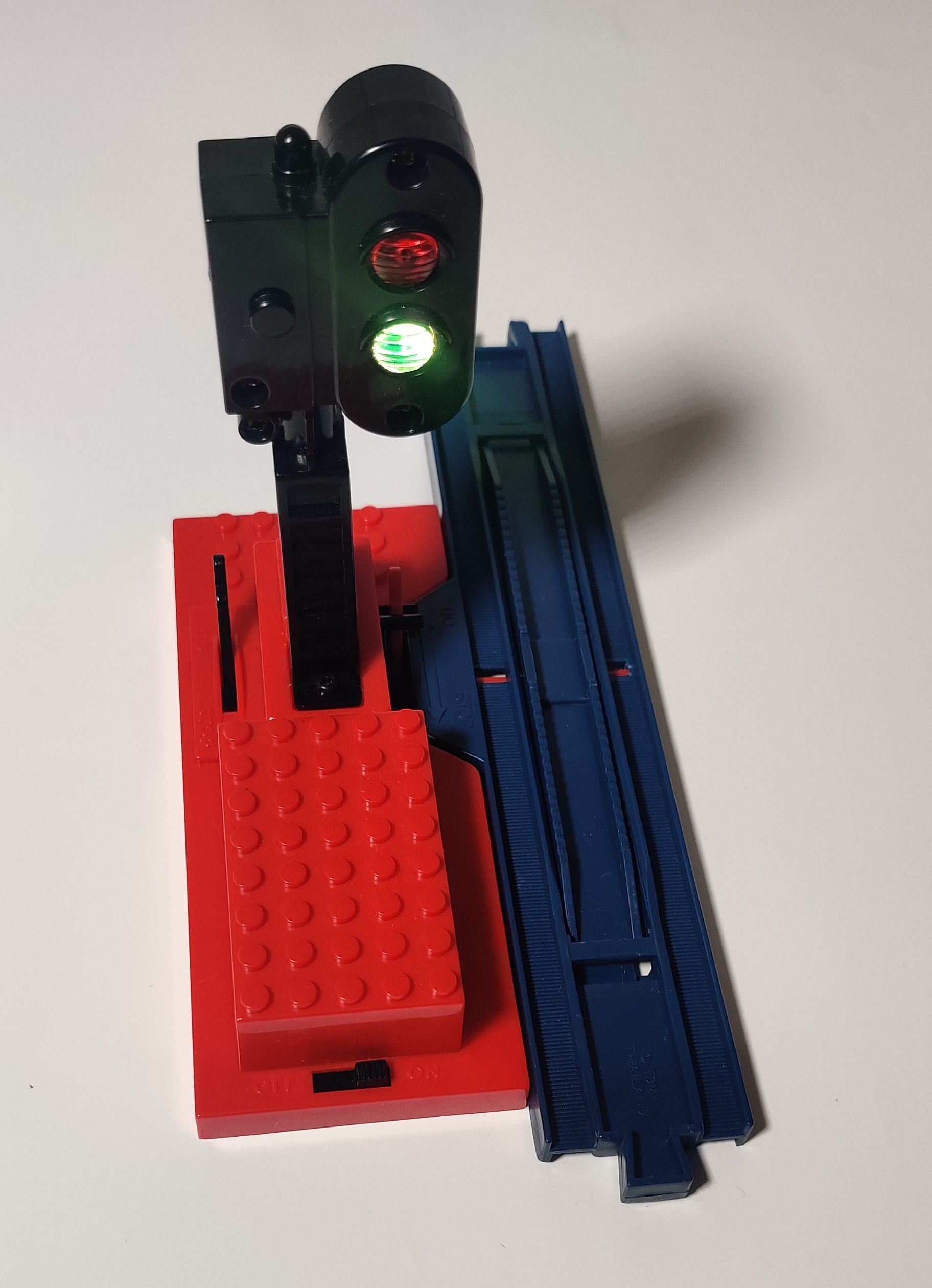
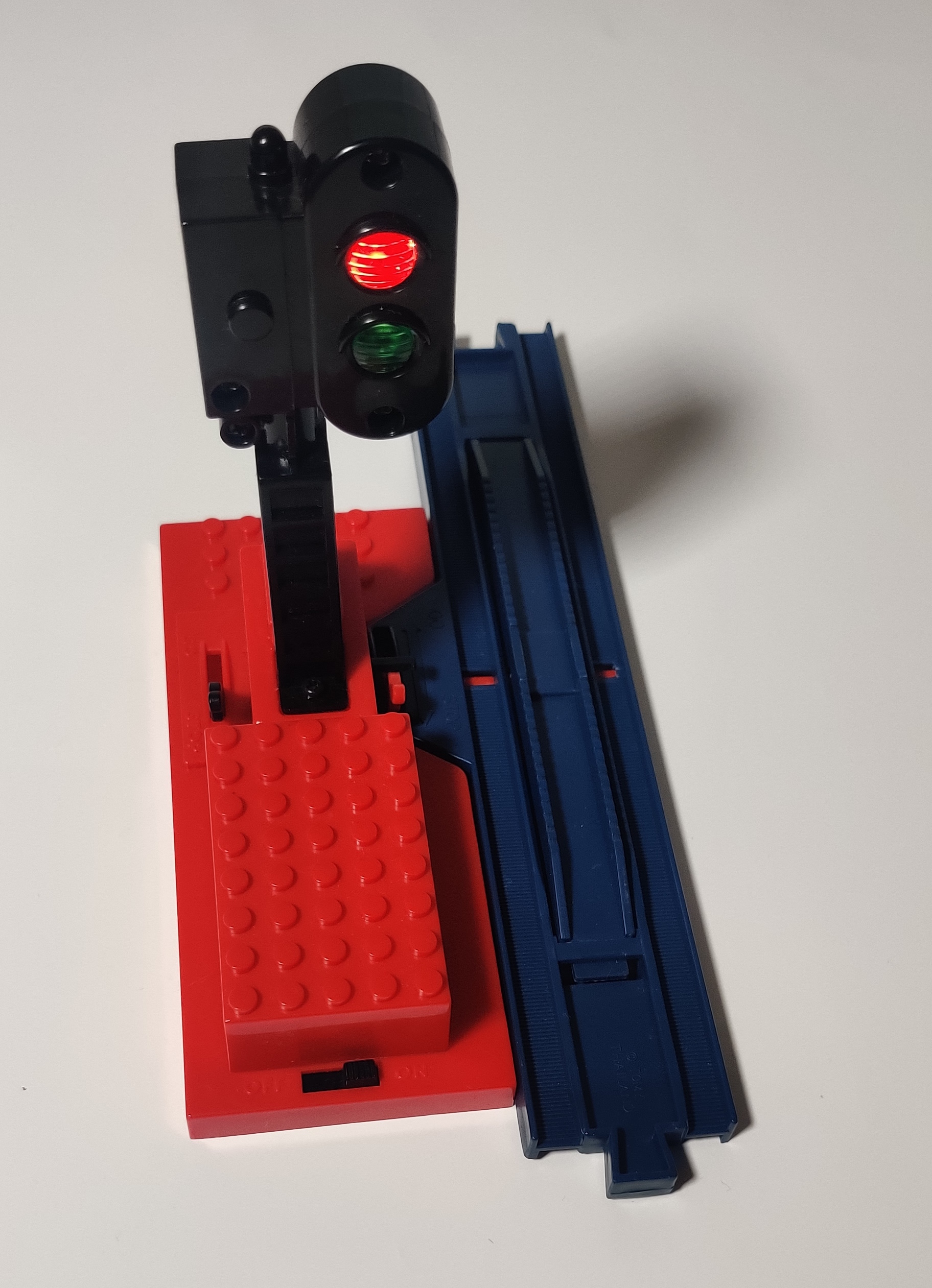
The operating signal takes two AA batteries inside a studded compartment that power an incandescent bulb in a carrier inside the signal housing. When the lever is set to stop, the bulb is positioned in the lower red-lenses chamber, and when set to go the linkage moves the lamp to the upper green-lensed position.
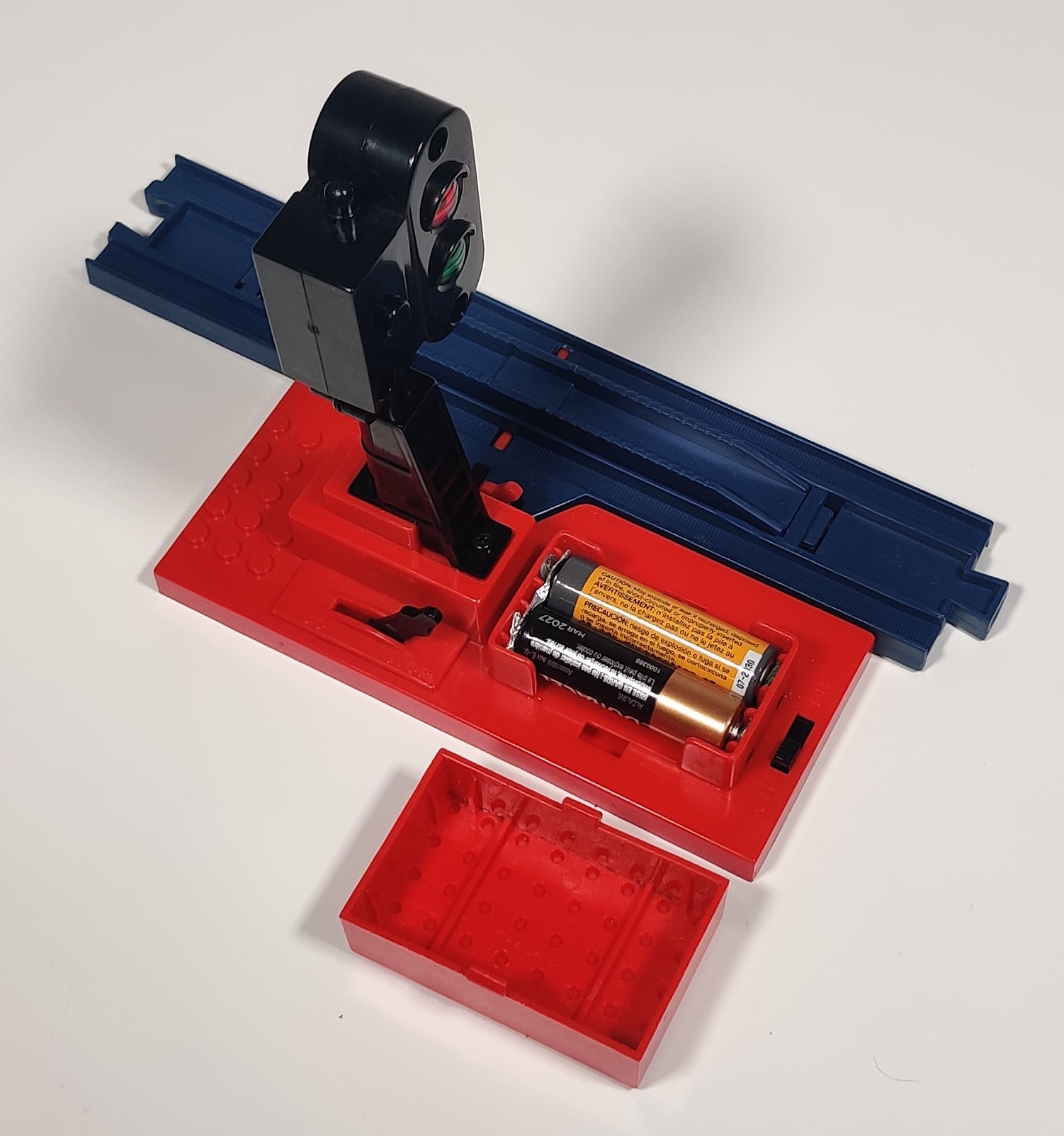
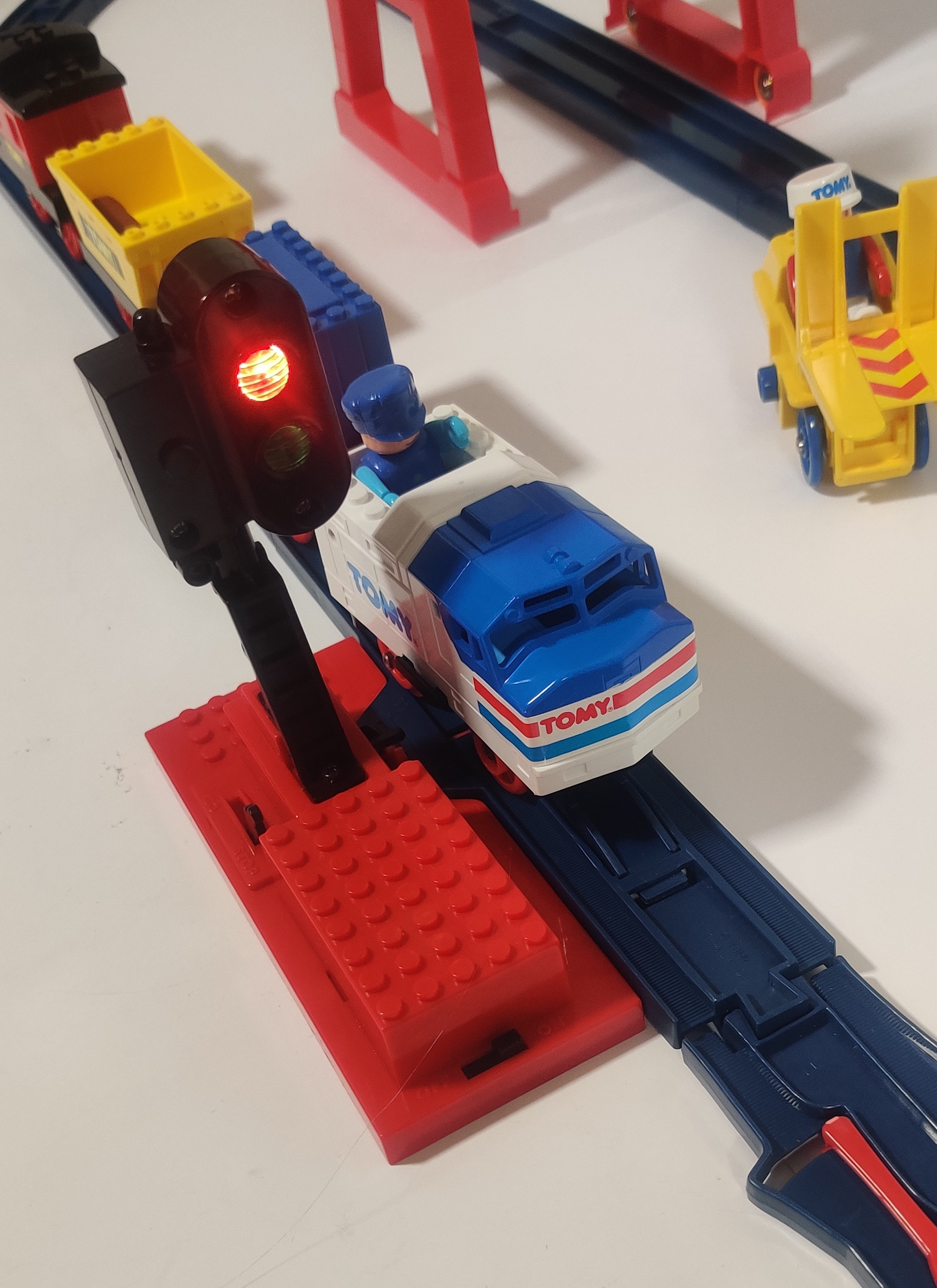
A power switch resides on the outside of the battery compartment, with several studded surfaces to build on top of. A pass-through arm attaches to the regular stop rail lever to sync the signal up up with the stop rail, stopping trains at red signals.
1312 Electronic Crossing (1988)
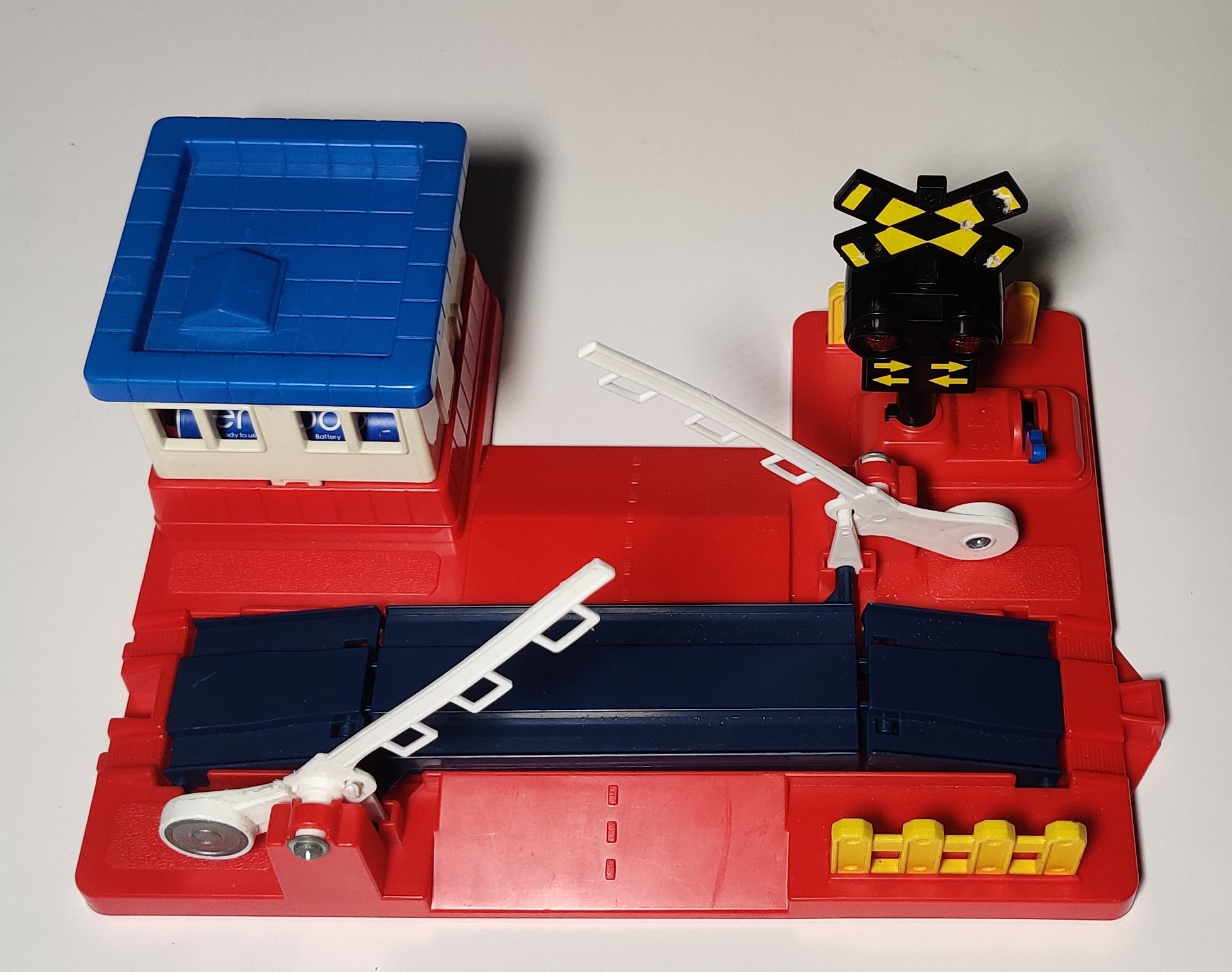
Tomy Train version of the Plarail Electro Railroad Crossing. Sold into the early 1990s.
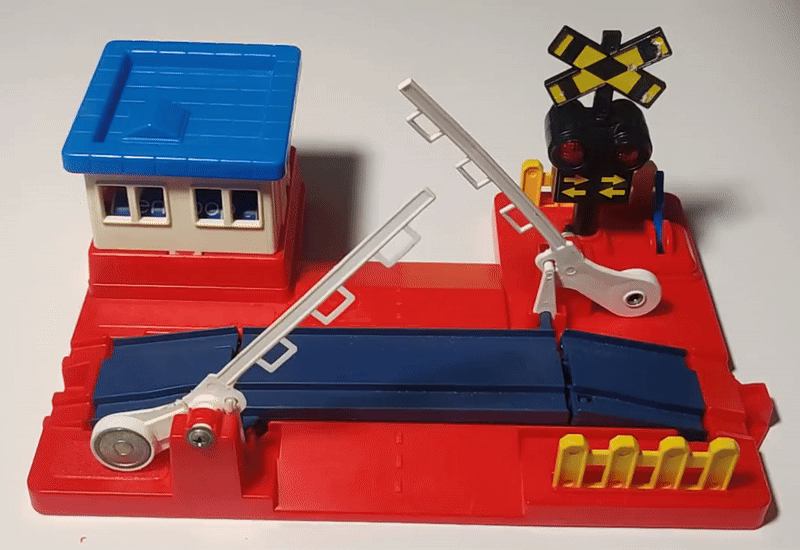
Click for video with sound!
Switch has settings for OFF, AUTO, and ON. ON plays a crossing dinging and flashes the lights. AUTO makes it only do so when a sensor under the rail is tripped as a train passes. Very neat.
1314 Bus Link Accessory Set (1990)
Neat European TOMYTRAINS pack that includes a spring-loaded passenger bus, driver and two passengers, railroad crossing, and two each of straight, curve, and point rails.
1315 Freight Depot Accessory Set (1990)
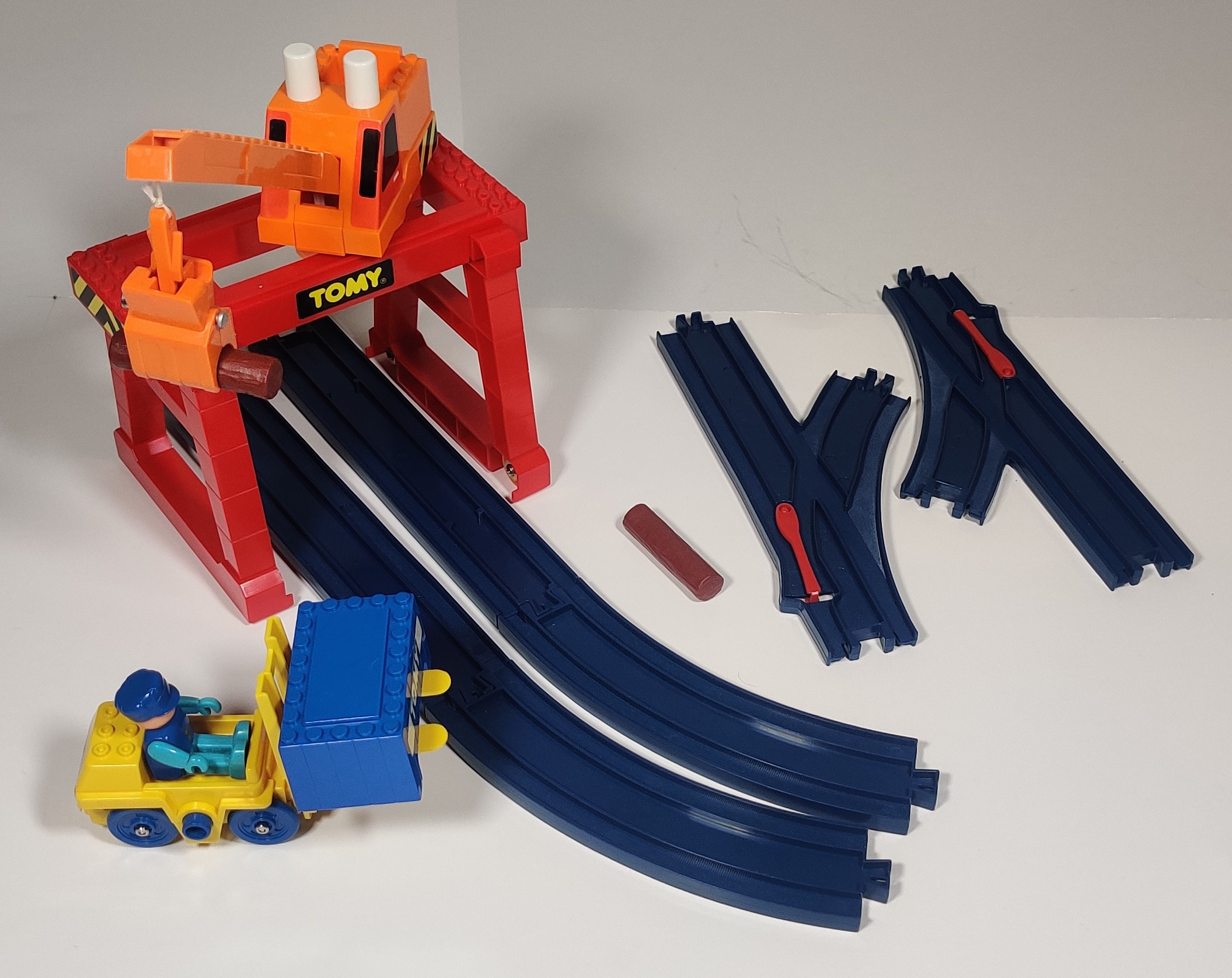
Very cool European TOMYTRAINS pack that includes a crane, forklift, driver figure, two logs, blue container, and two each of straight, curve, and point rails.
1316 Inter-City Station Accessory Set (1990)
The first magnet-base accessory and first major use of the studded block building system with a new large base with two integrated magnetic moving pathways for the included passenger figures with magnetic feet, which would become standard for all releases in 1991 with the expansion of the magnet system.
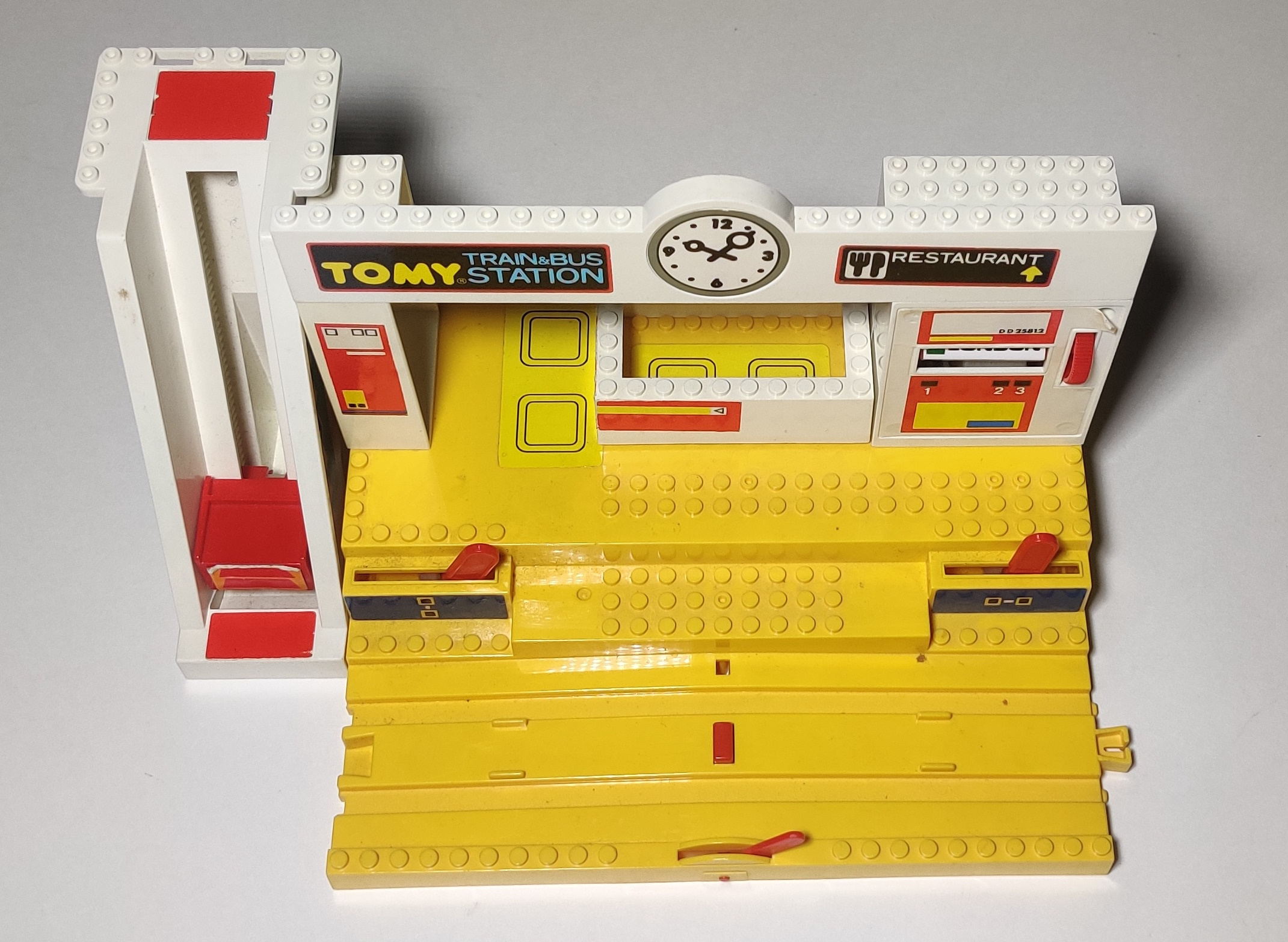
I only have a partial set of this accessory - the entire yellow upper floor baseplate and the other upper components besides the bus & train station sign with clock are absent, as is the bus and some other components.
The magnetic paths in the floors position one figure to walk back and forth behind the ticket counter while the other lets passengers pass through the gate from the bus to train side or vice versa. The escalator is functioning - its actually driven by a little pull-back motor that get's "pulled back" when the escalator is pushed down and then when a figure's magnetic feet trigger the motor it runs the escalator up to the upper level. One of the gears in mine is slipping - I'll fix it or use it for parts if I end up with the parts to complete one of these stations.


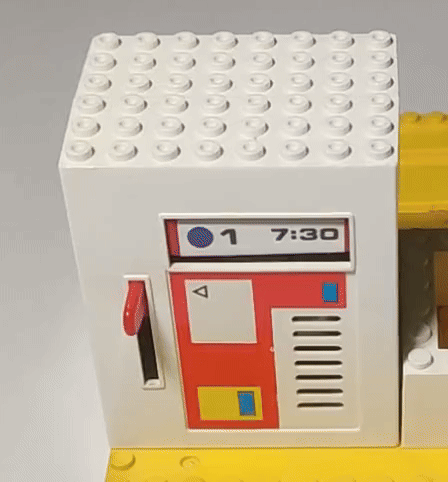
One of the "bricks" on the lower level has a rotating destination board on one side and a lever which rings a bell and flips the arrivals board around.
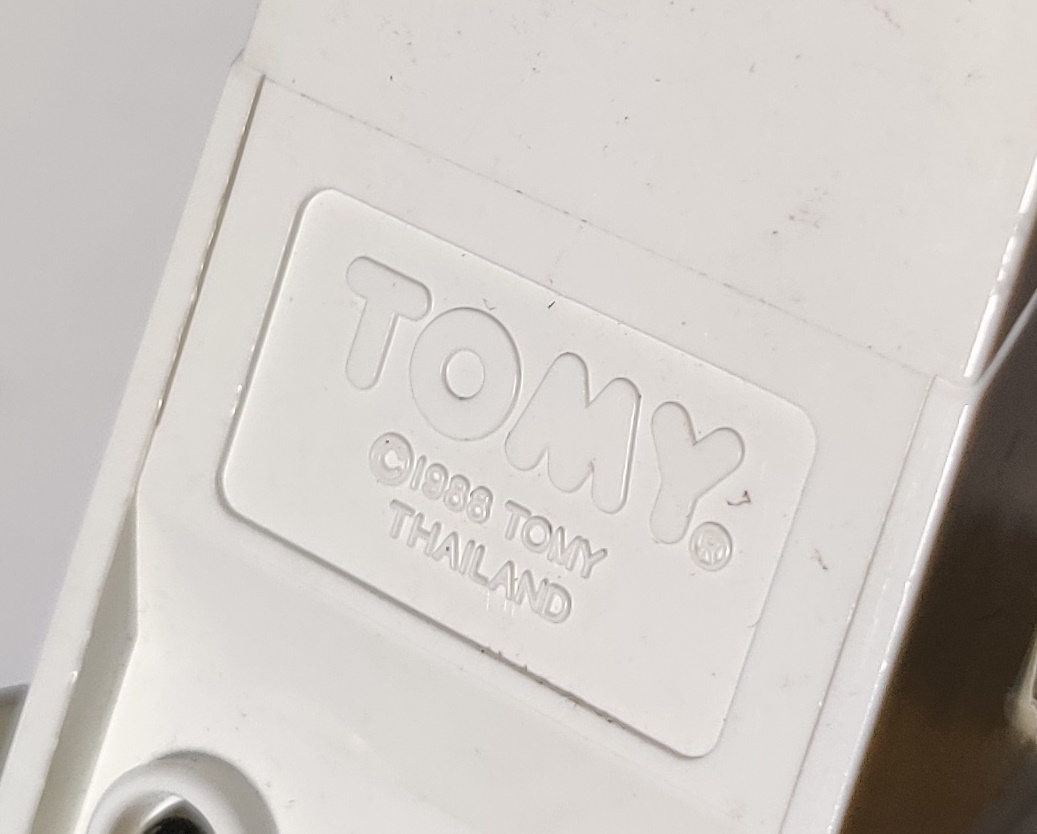
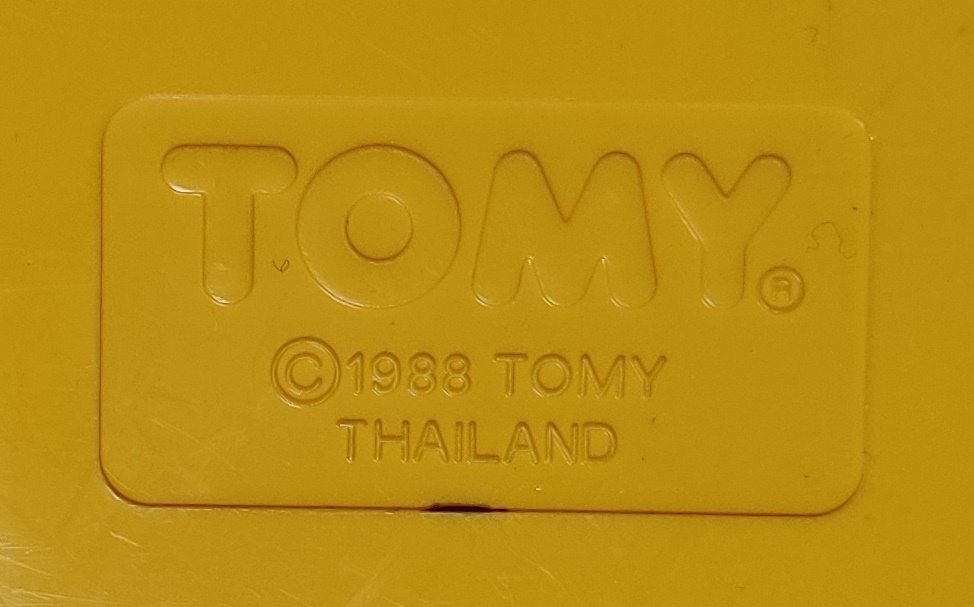
As mentioned with the figures above, it seems Tomy devised this magnet system in 1988 and just did not fully implement it for a few years, as multiple components are marked 1988.
The pack also includes two straight rails and a set of single/double point rails as well as the ramp track-to-surface pieces for the bus "road" side of the station. This was seemingly the only 1990 TOMYTRAINS accessory pack to also be released in the later TOMY TRAINS packaging.
1317 Siding Accessory Set (1990)
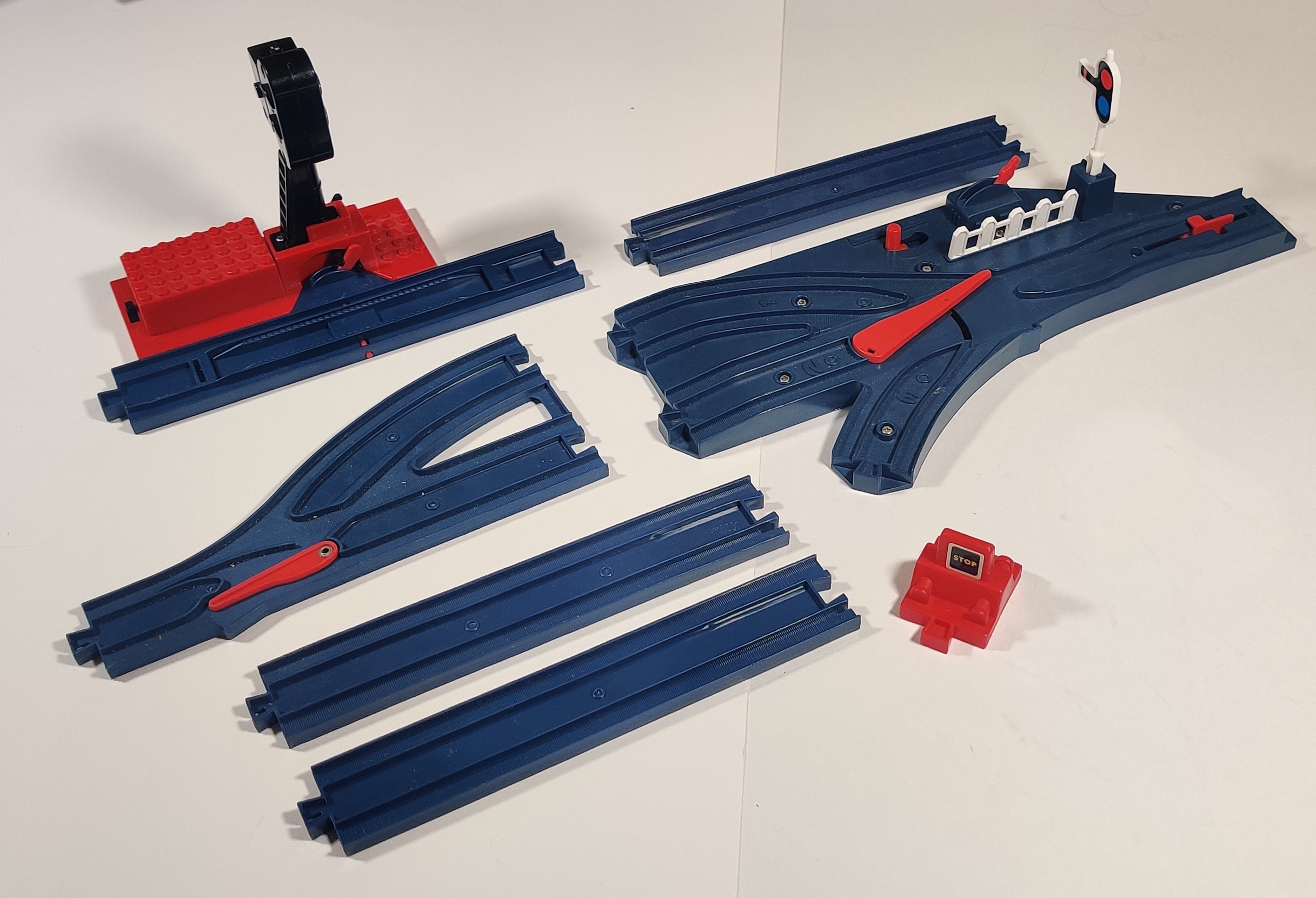
TOMYTRAINS track pack with automatic 3-way point, single/double point rail, three straight tracks, stop rail, operating signal, and stop buffer.
1318 Station Announcer/Talking Station (1990)
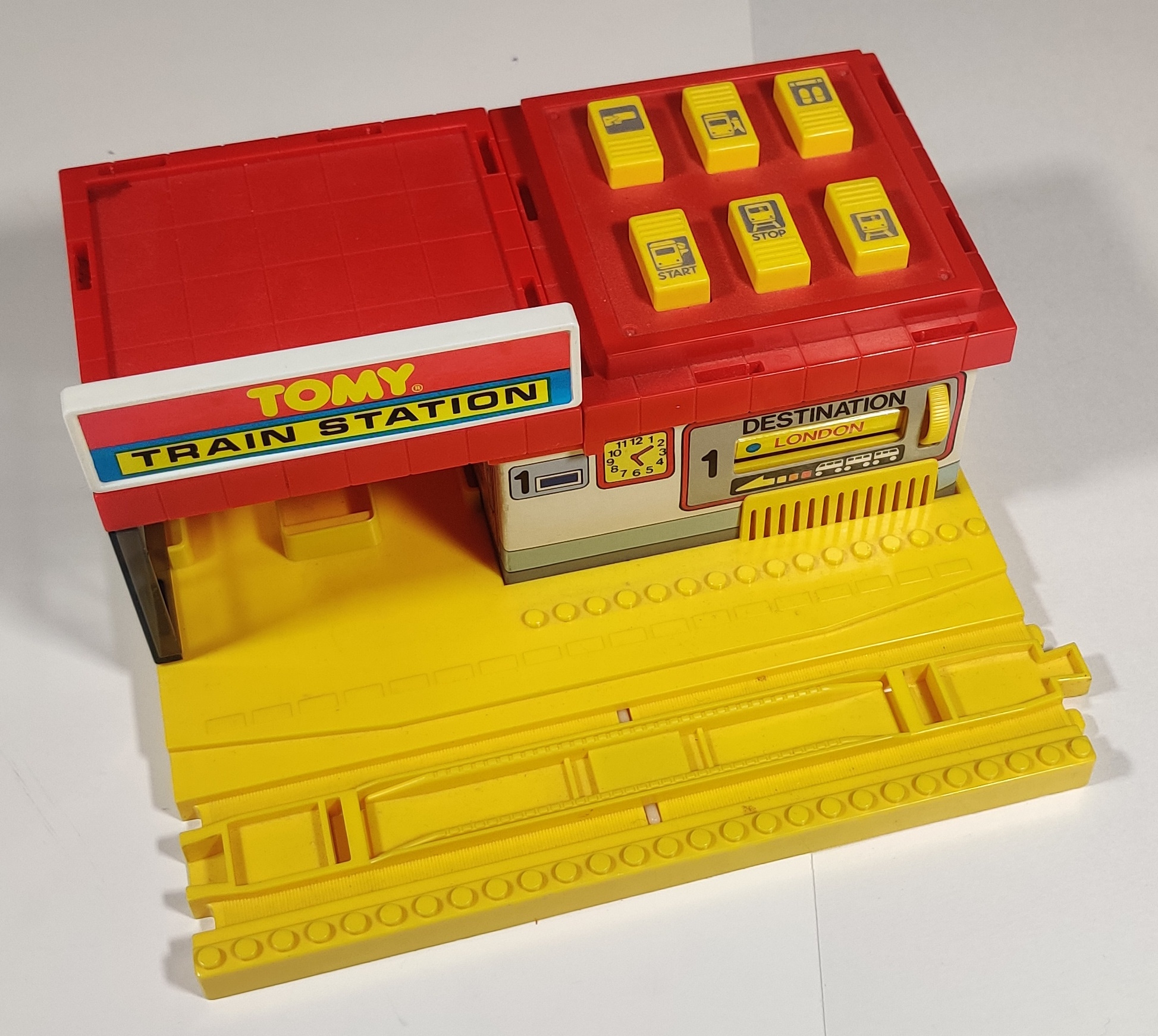
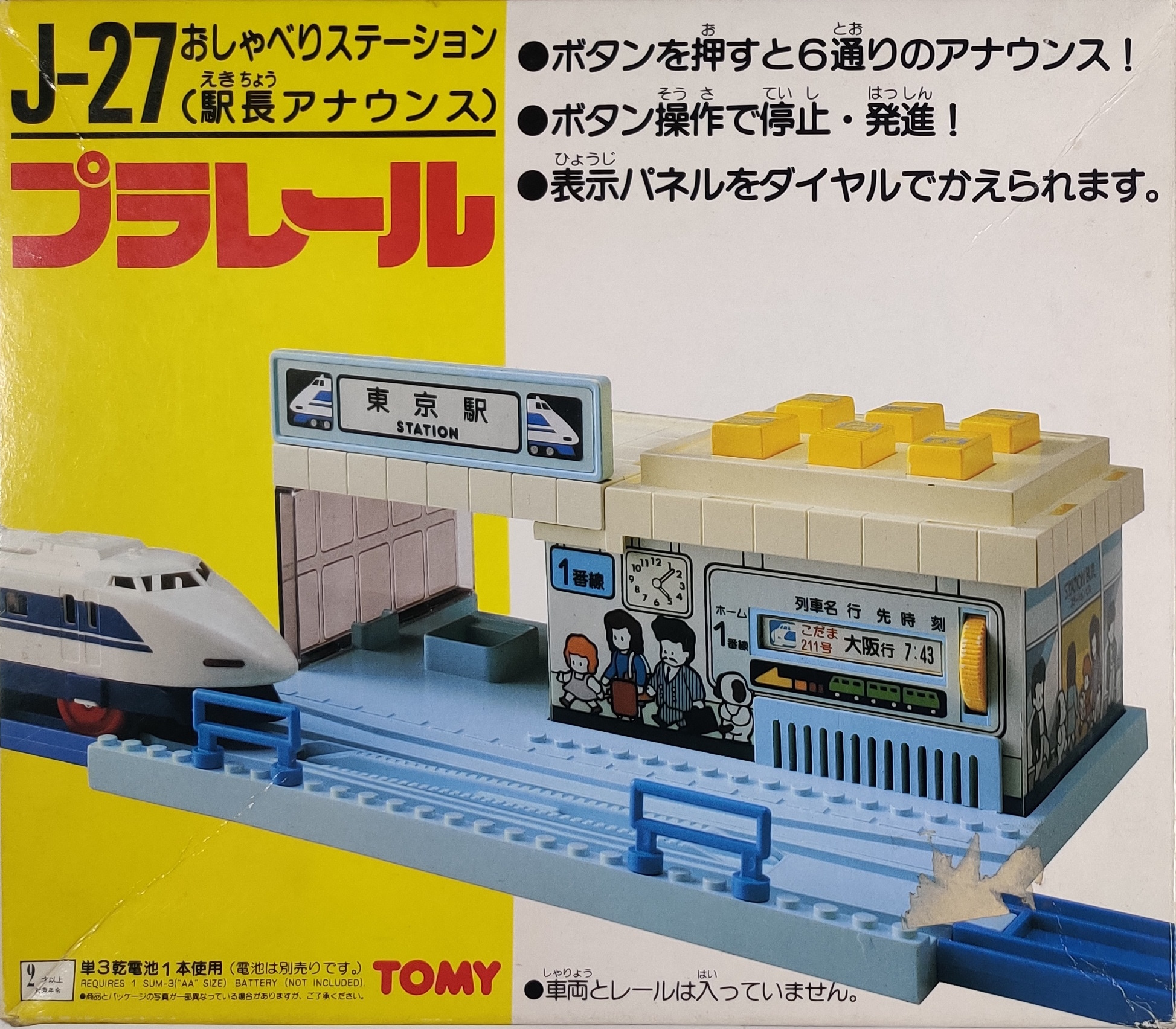
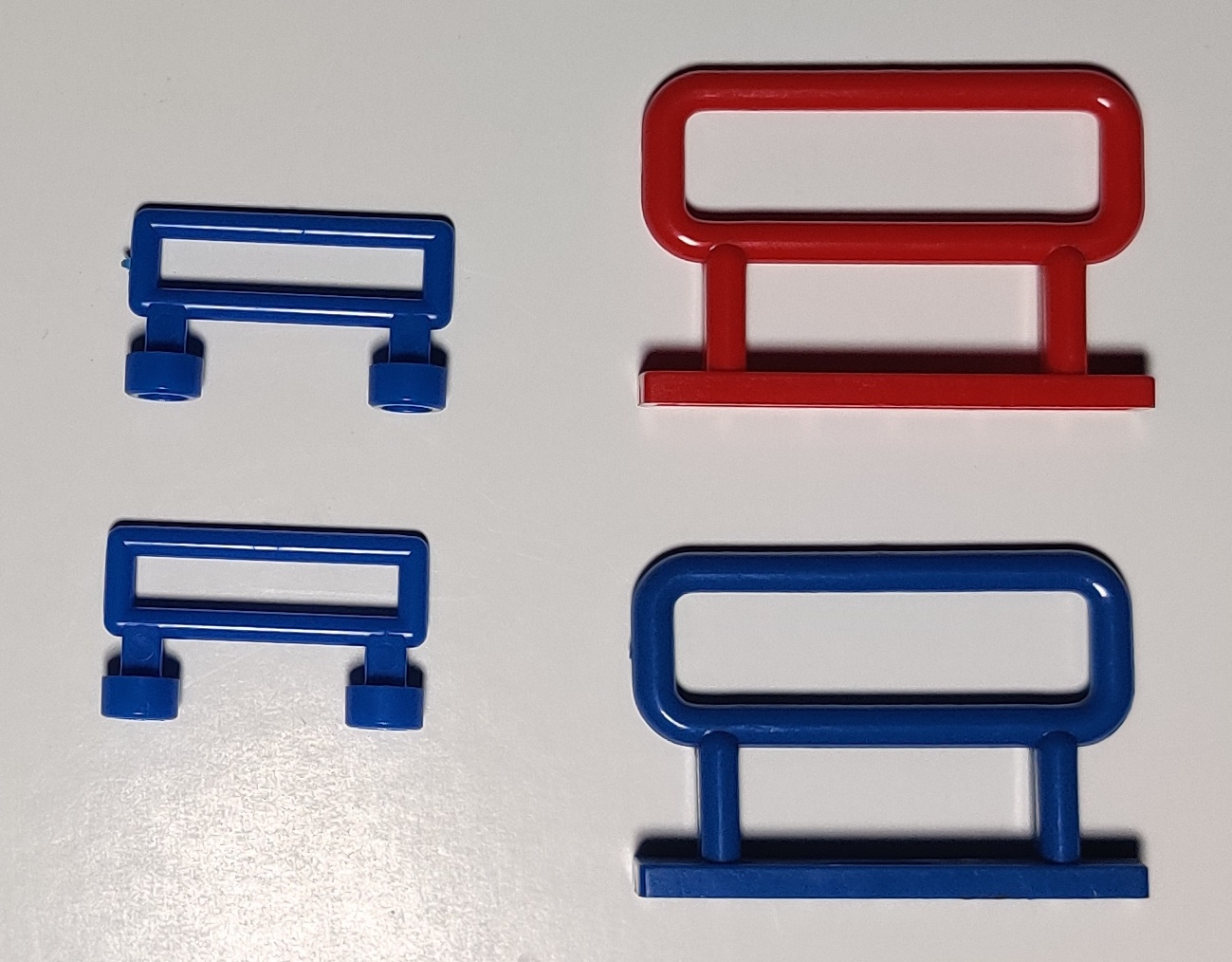
European adaptation of the Plarail J-27 Talking Station with a small acoustic phonograph and multi-track disk that plays different station sounds and announcements. The Plarail version, first sold in summer 1987, has the studded base and even similar (though clearly distinct) blue guard railings to the Tomy Train system but these were really part of the "Plarail Town" series of studded Plarail accessories started in 1987. The Tomy Train version does not seem to have come with these railings, despite similar pieces being in the standard. Some Plarail Town buildings can be seen at the bottom of this webpage. Funnily enough, in the later 1990s the Plarail station was replaced with an electronic version that included two silvery railings that used the Tomy Train railing tooling.
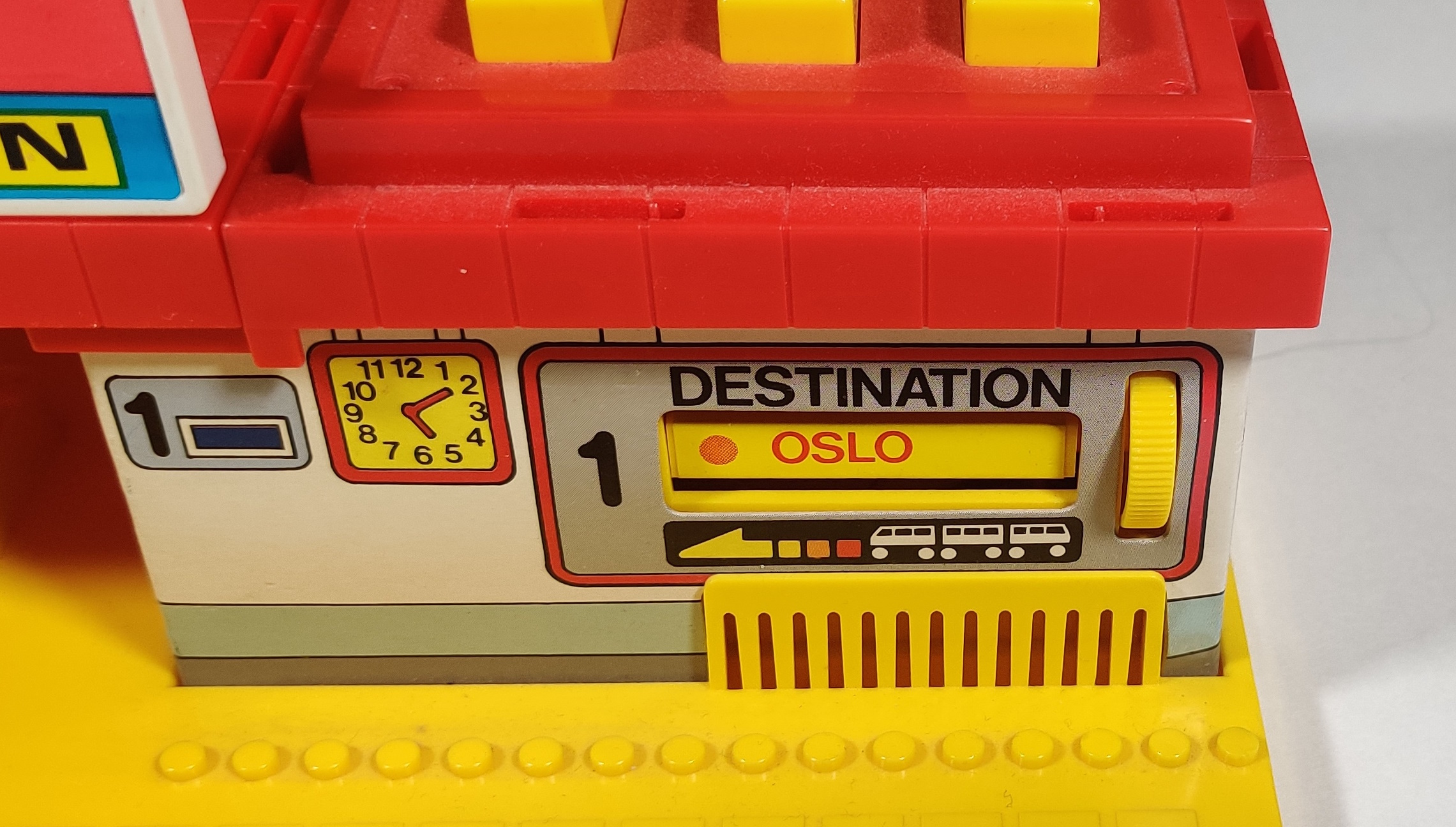
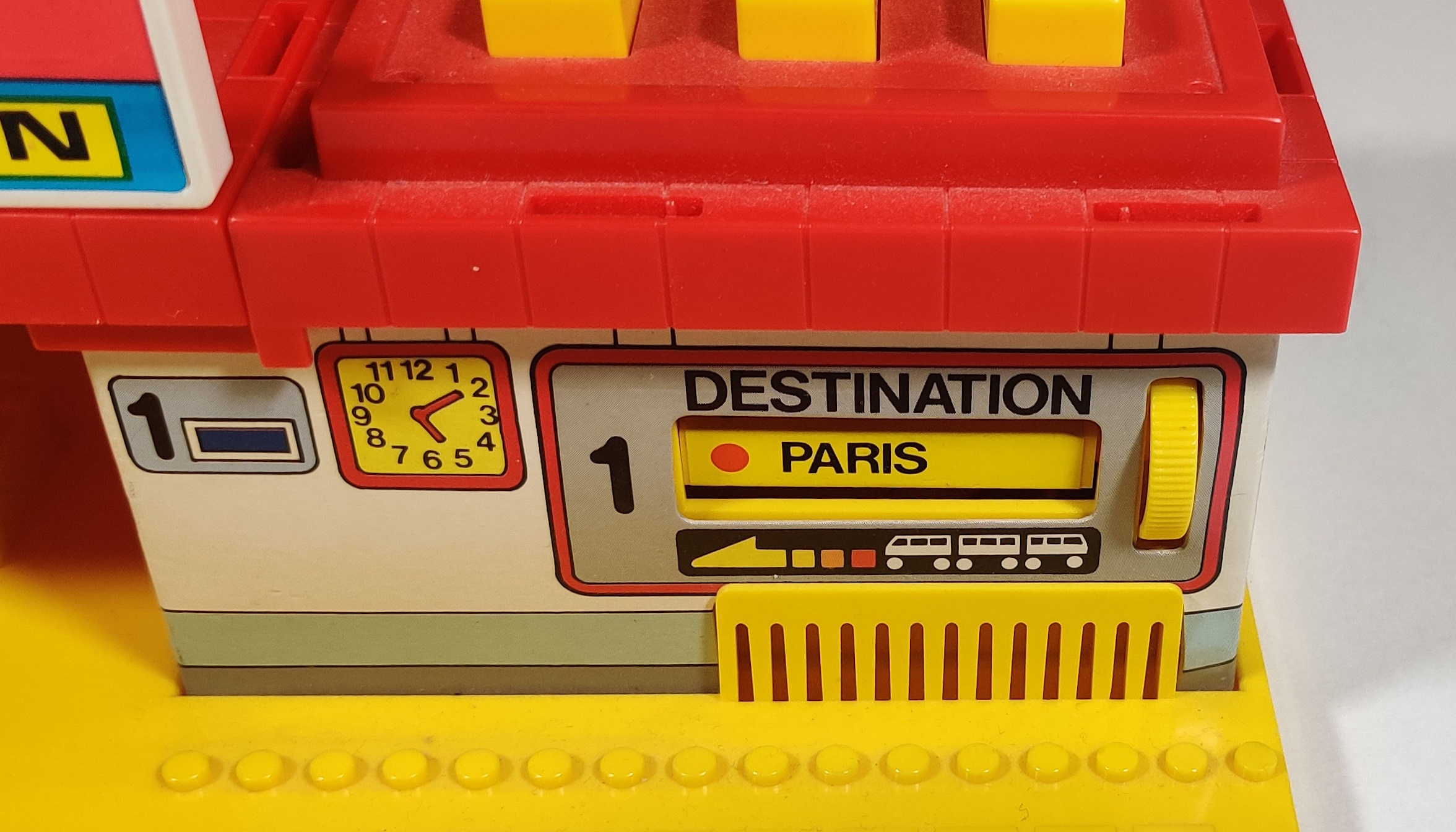
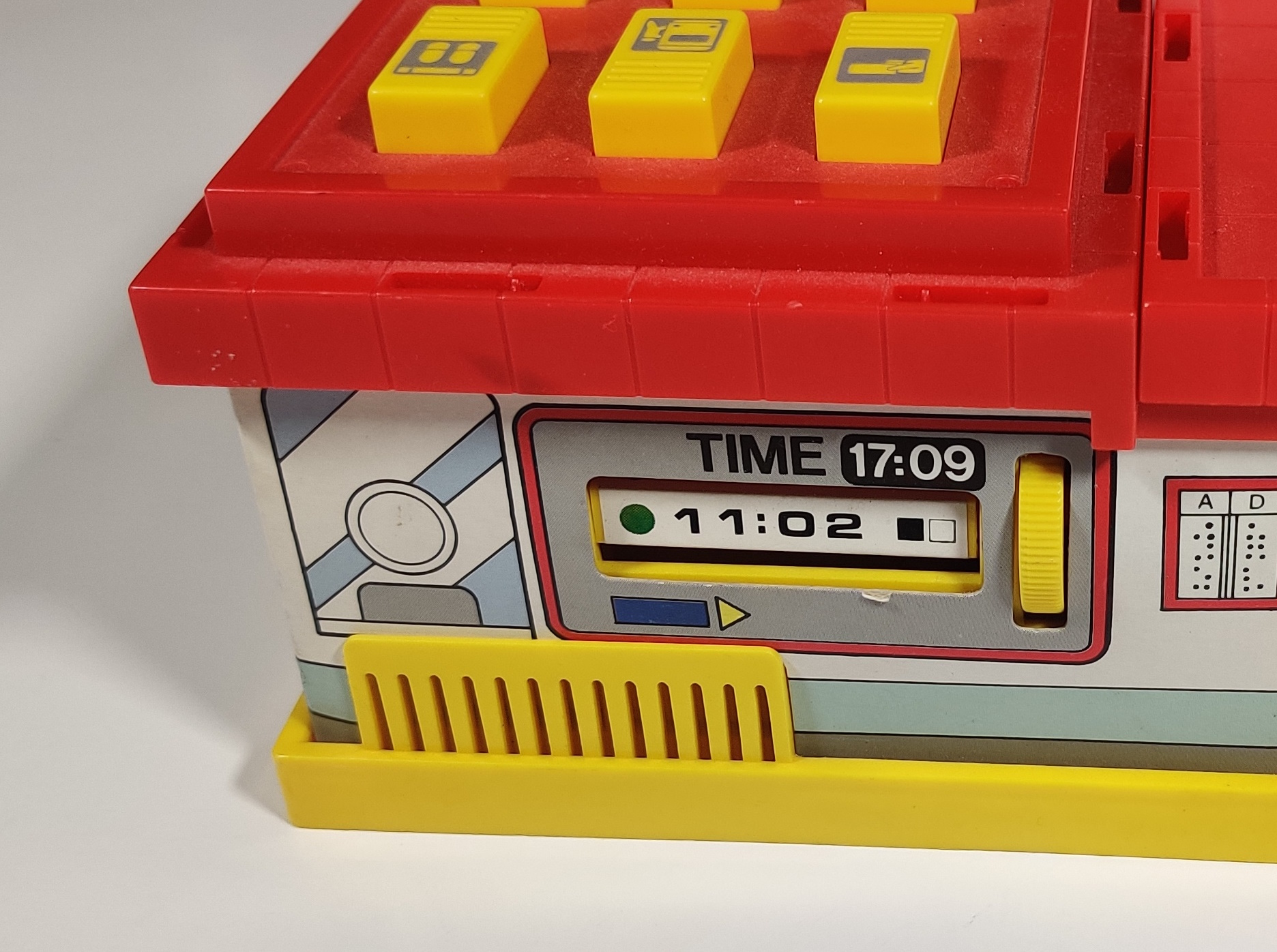
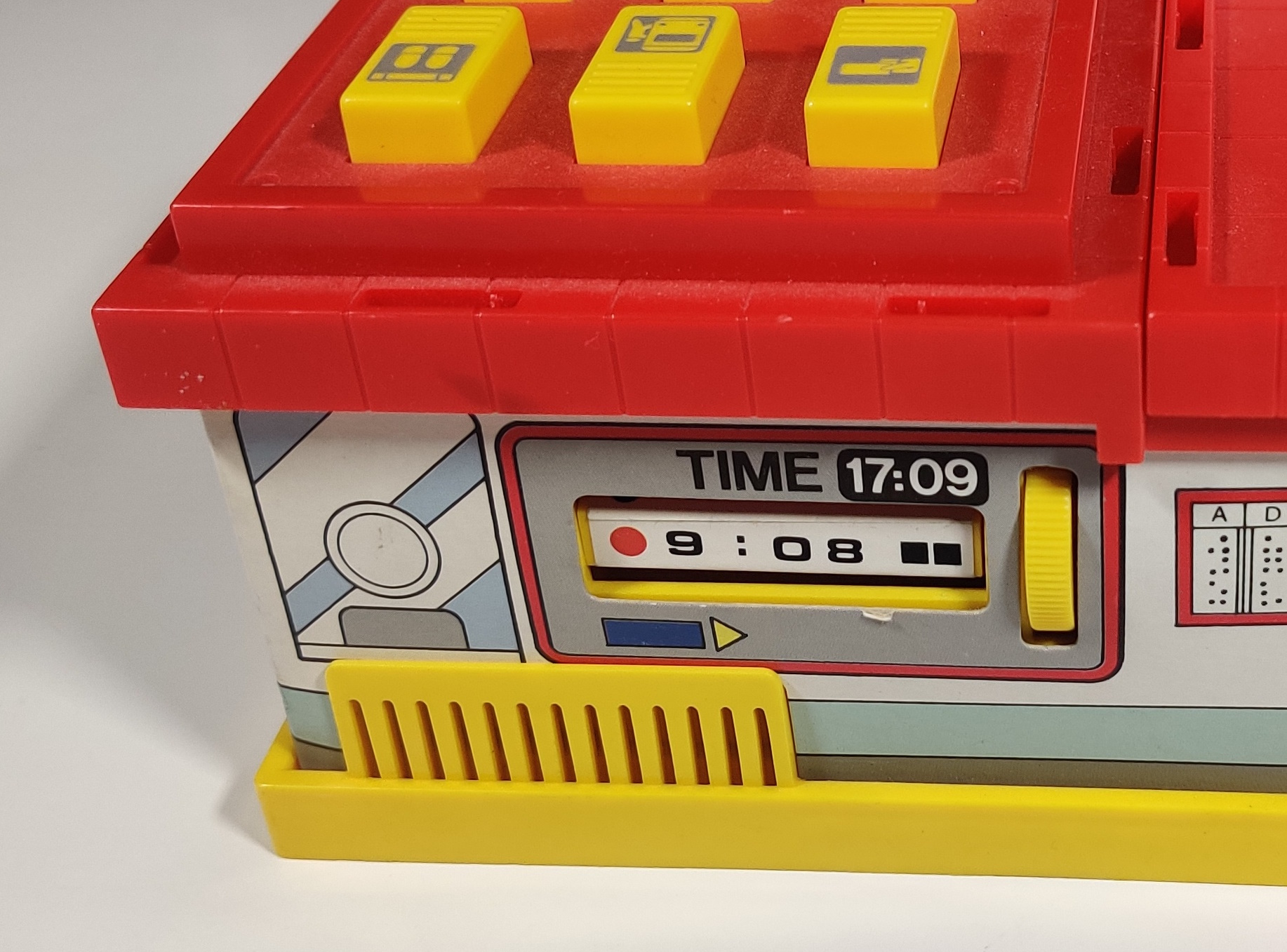
The sides of the station are nicely decorated with a printed cardboard insert. The front of the station has a destination board that can be rotated between different cities. The rear has a time board with rotating arrivals.
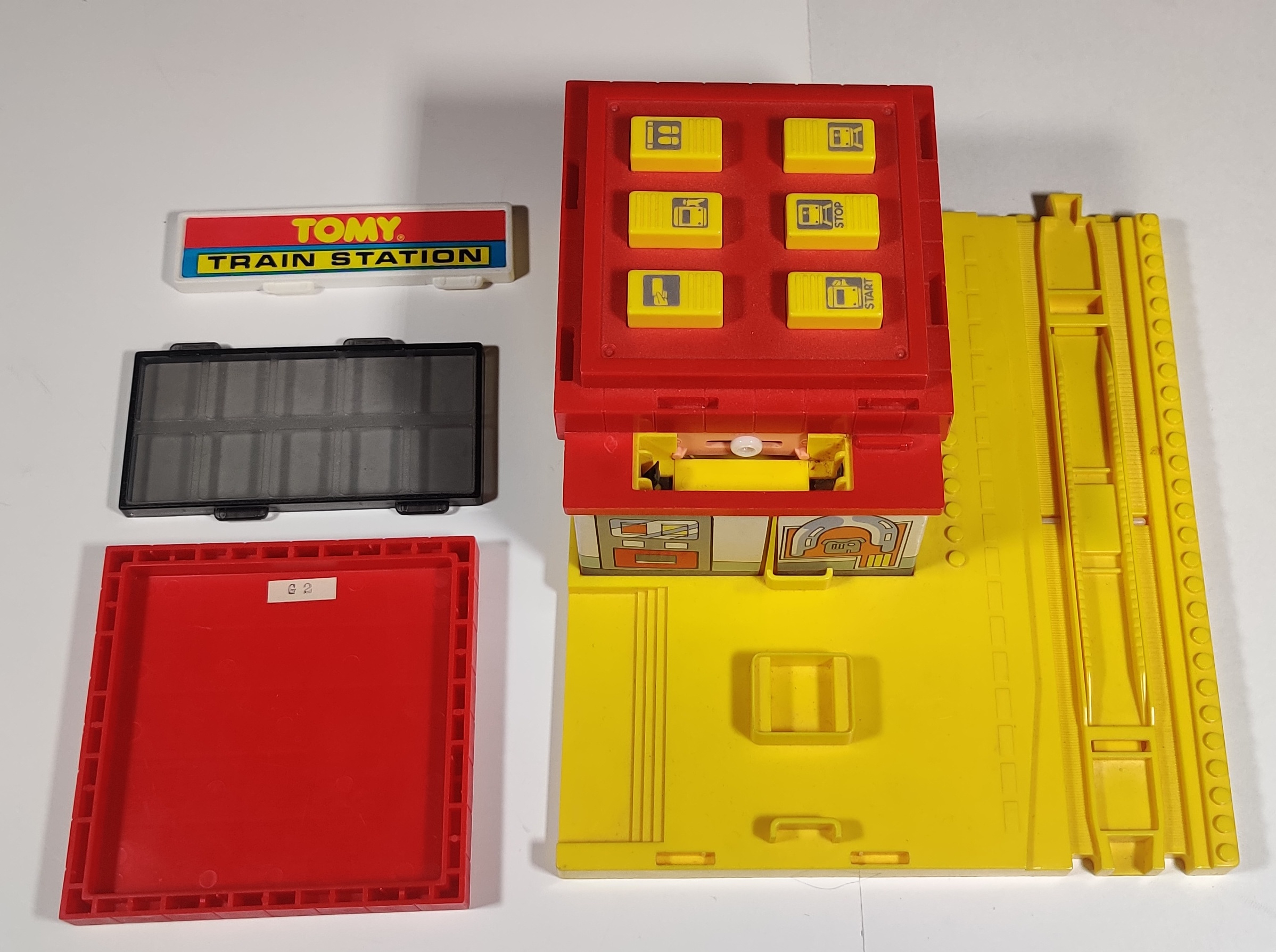
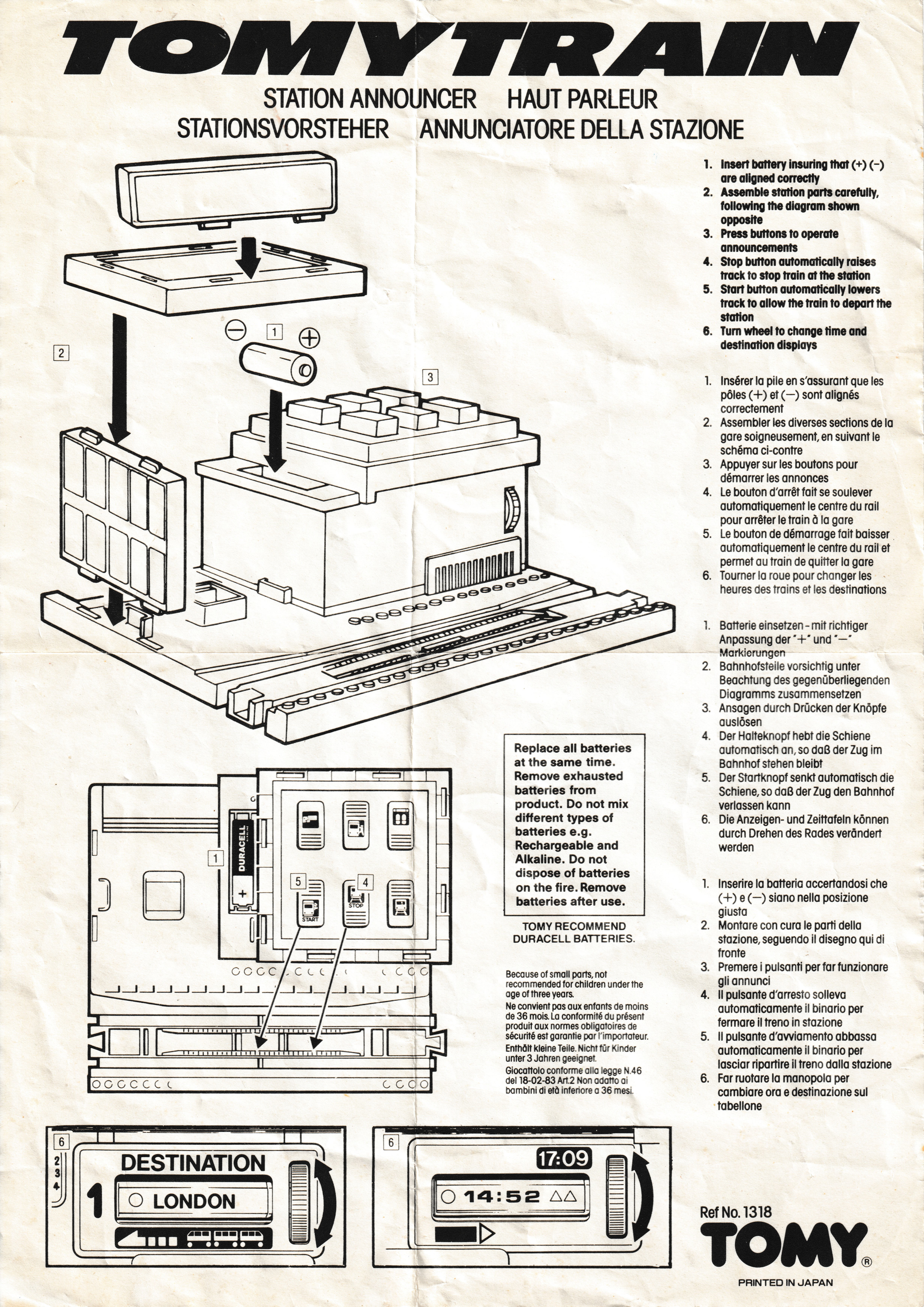
This is the only panel station system item released for Tomy Train, and one of very few panel station standard items to ever be exported. Under the roof is the battery compartment. The sliding lever in the compartment is the speed adjustment for the acoustic record player inside. The G2 mark on the bottom of the roof means this example was produced in July 1992.
The first button plays a reminder to have your tickets ready. The middle button in the top row is an all aboard call. The top right button is a reminder to stand clear of the doors. The bottom left button drops the track stopper and says the train is now leaving, and the bottom middle button raises the stopper and says the next train is arriving. The final button says fast train approaching. It is neat to have the English and Japanese versions of these stations and I really like the electromechanical nature of this station's operation versus the Sound Play Station and other electronic talking stations. You can hear the crackles of the little plastic record after the announcement has played.
1319 Automatic Stop/Start Station (1990)
Tomy Train release of the Plarail catch-and-release station with ringing bell and changing display board. Released in American white grid packaging and later in Europe in TOMYTRAIN packaging.
1330 Crossing Pack (1990)

American pack containing the 1306 Road Crossing, fir tree, and two-piece tunnel. Part of 1993 U.S. mail-in offer.
1331 Commuter Pack (1990)
1990 American white grid pattern packaging release with passenger bus, bus driver, and red open passenger car.
1332 Freight Pack (1990)

Early 90s American release with forklift, operator, two blue containers, and flatbed car.
1333 Station Pack (1990)

American accessory pack with standard train station platform, two figures, stop rail, and red passenger car. Part of 1993 U.S. mail-in offer.
1335 Bridge and Track (1990)

American bridge pack with with two yellow iron bridges, four Tomy Train girders, four straight rails, two curve rails, and a pair of slope rails. Part of 1993 U.S. mail-in offer.
1323 Freight Station and Depot Accessory Set (1991)
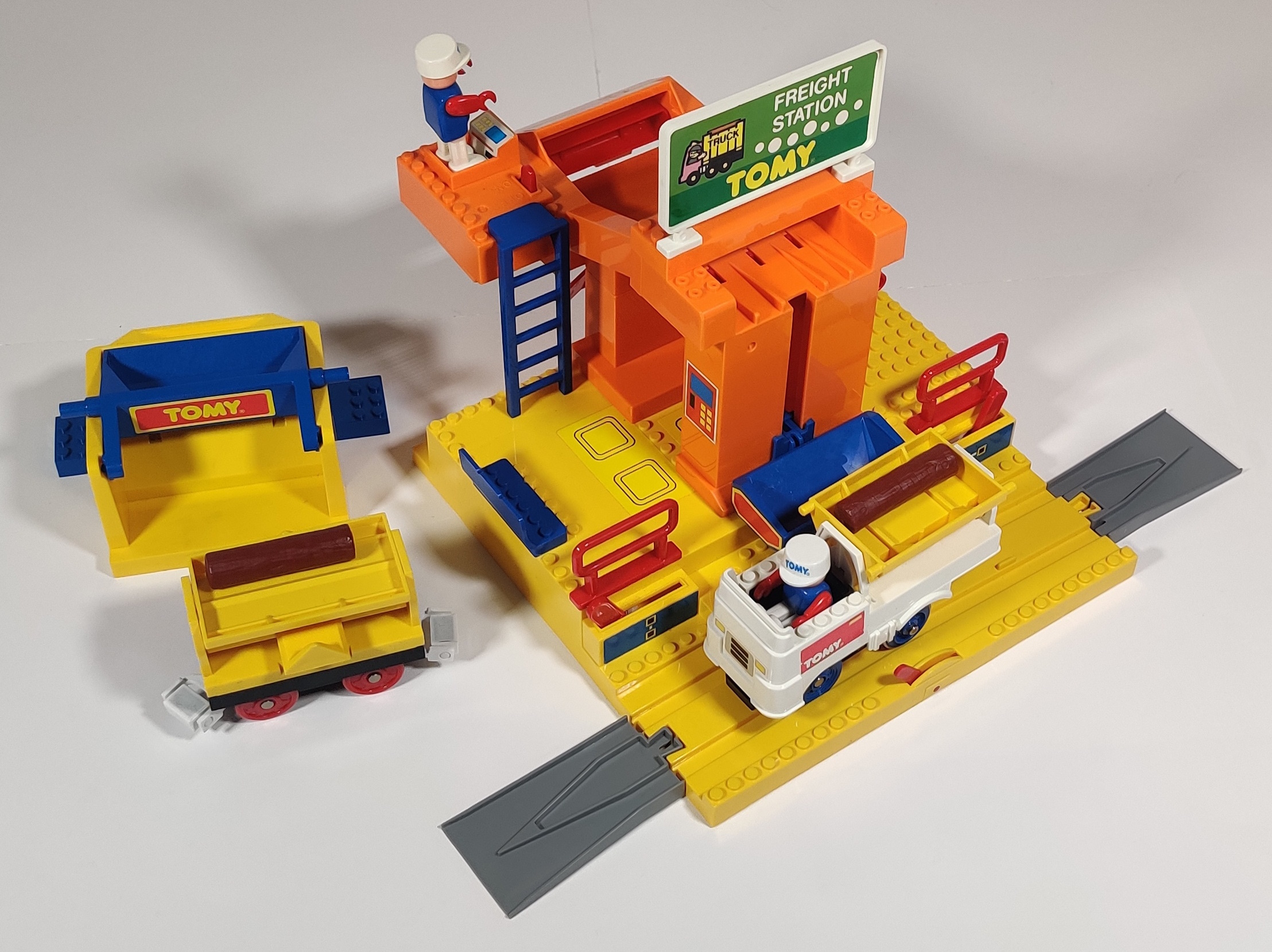

Nice accessory set sold in European TOMYTRAIN and American Tomy Train packaging with the new-for-1991 log loading station, log unloading depot, log truck, log wagon, and two operators.
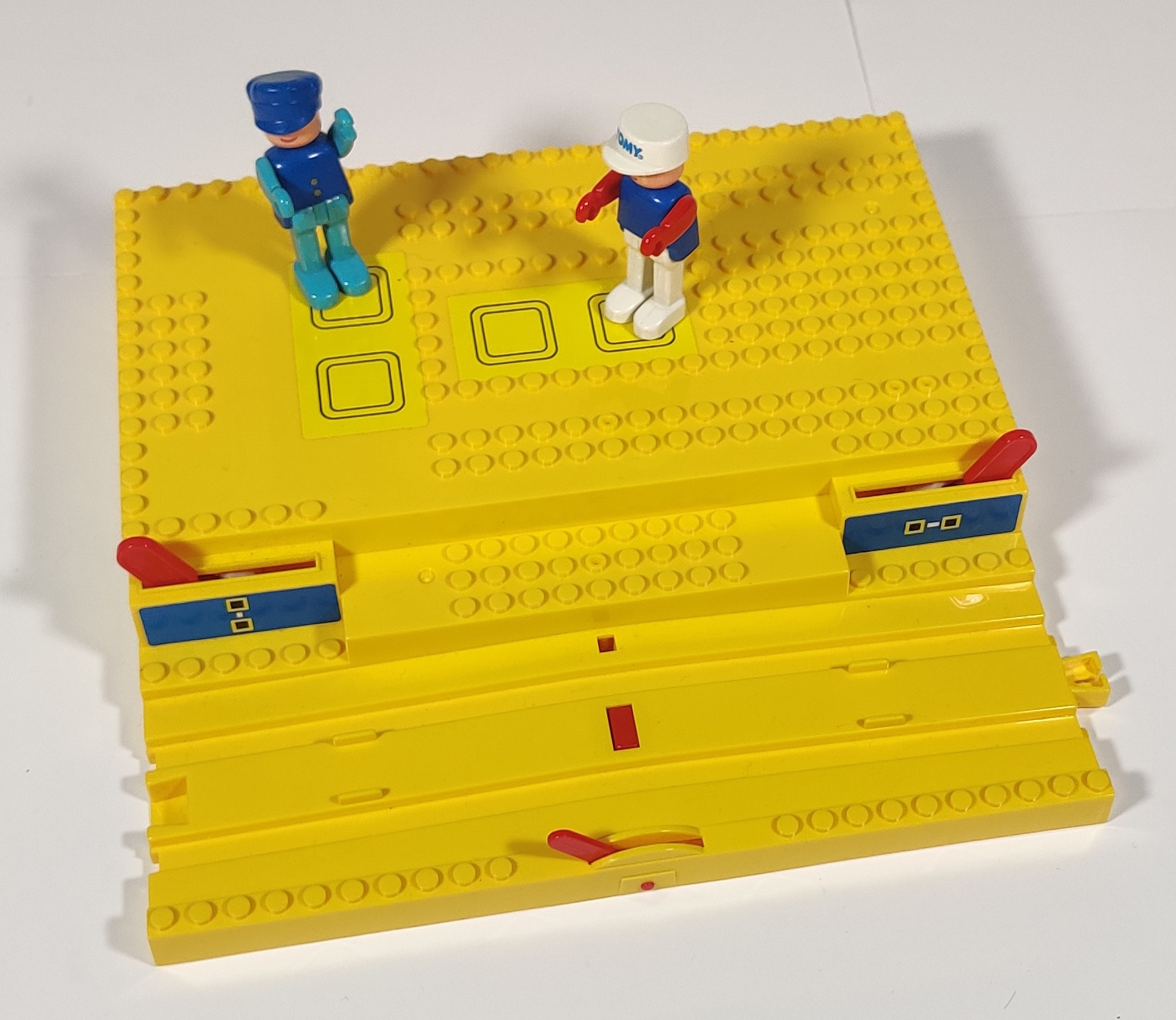
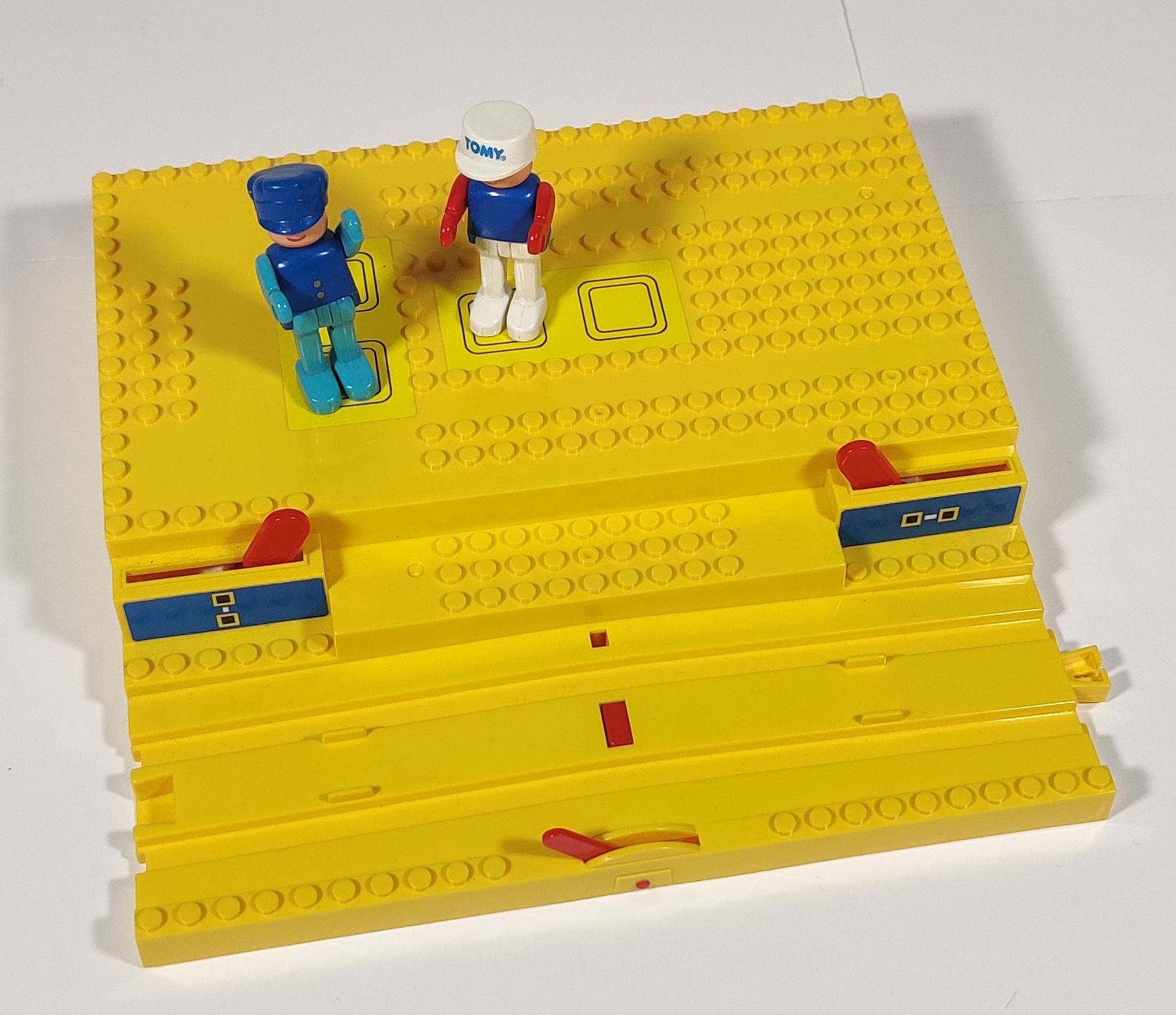
Because it uses the magnetic base, figures with magnets in the feet standing on the outlined square pads can be moved back and forth using the red levers. When the station is built, this allows the figures to approach the ladder from the road or travel under the chute.
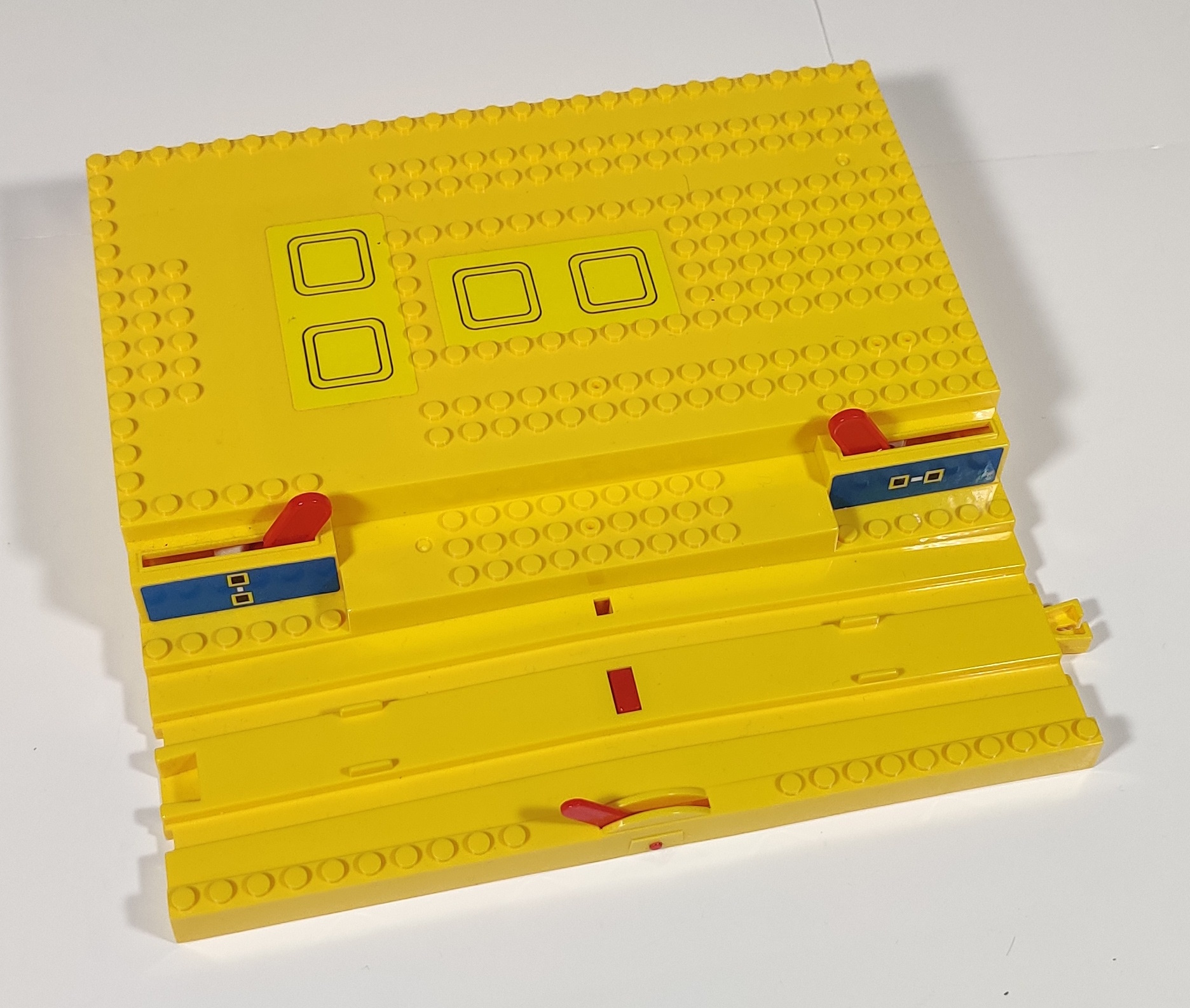
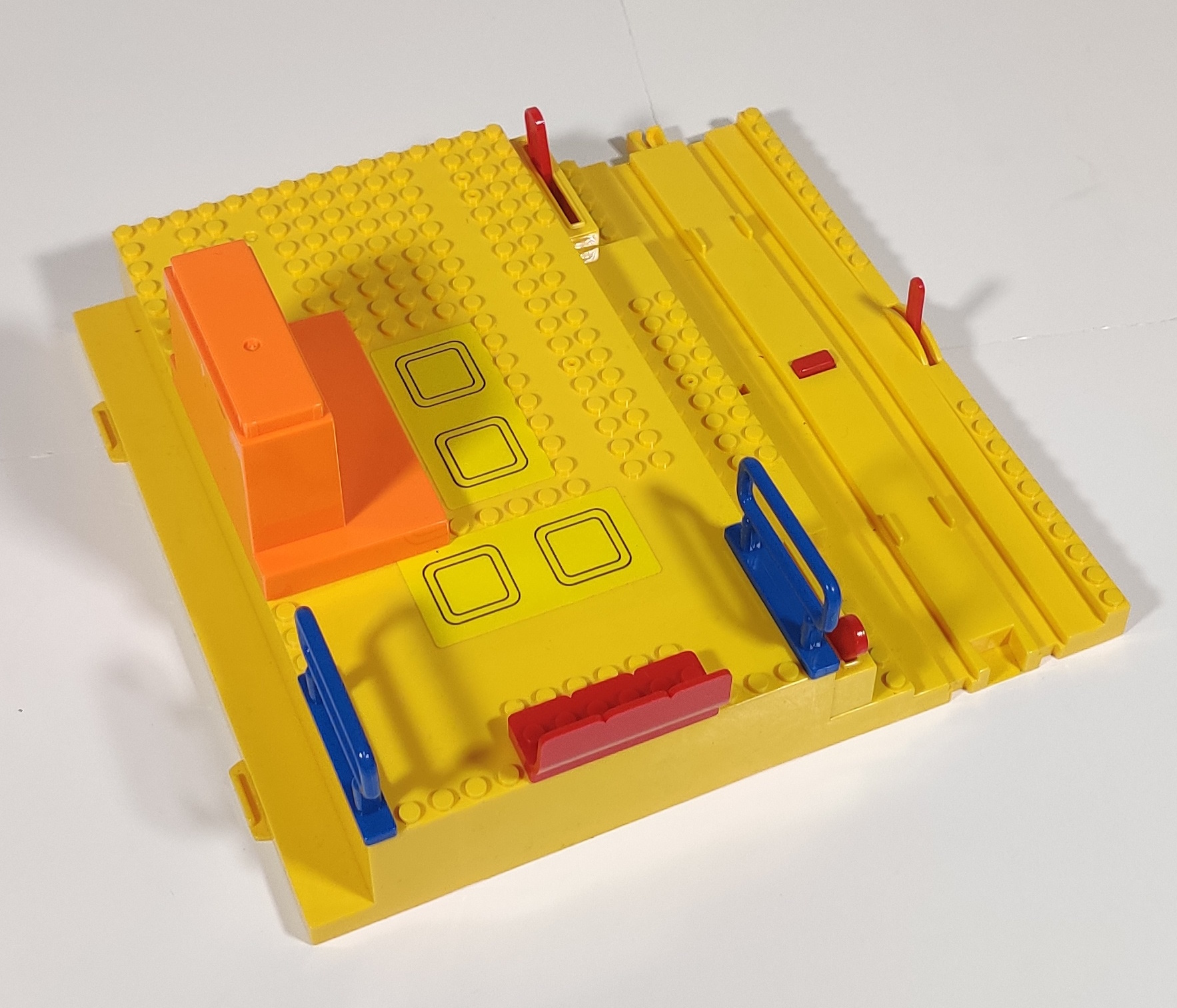
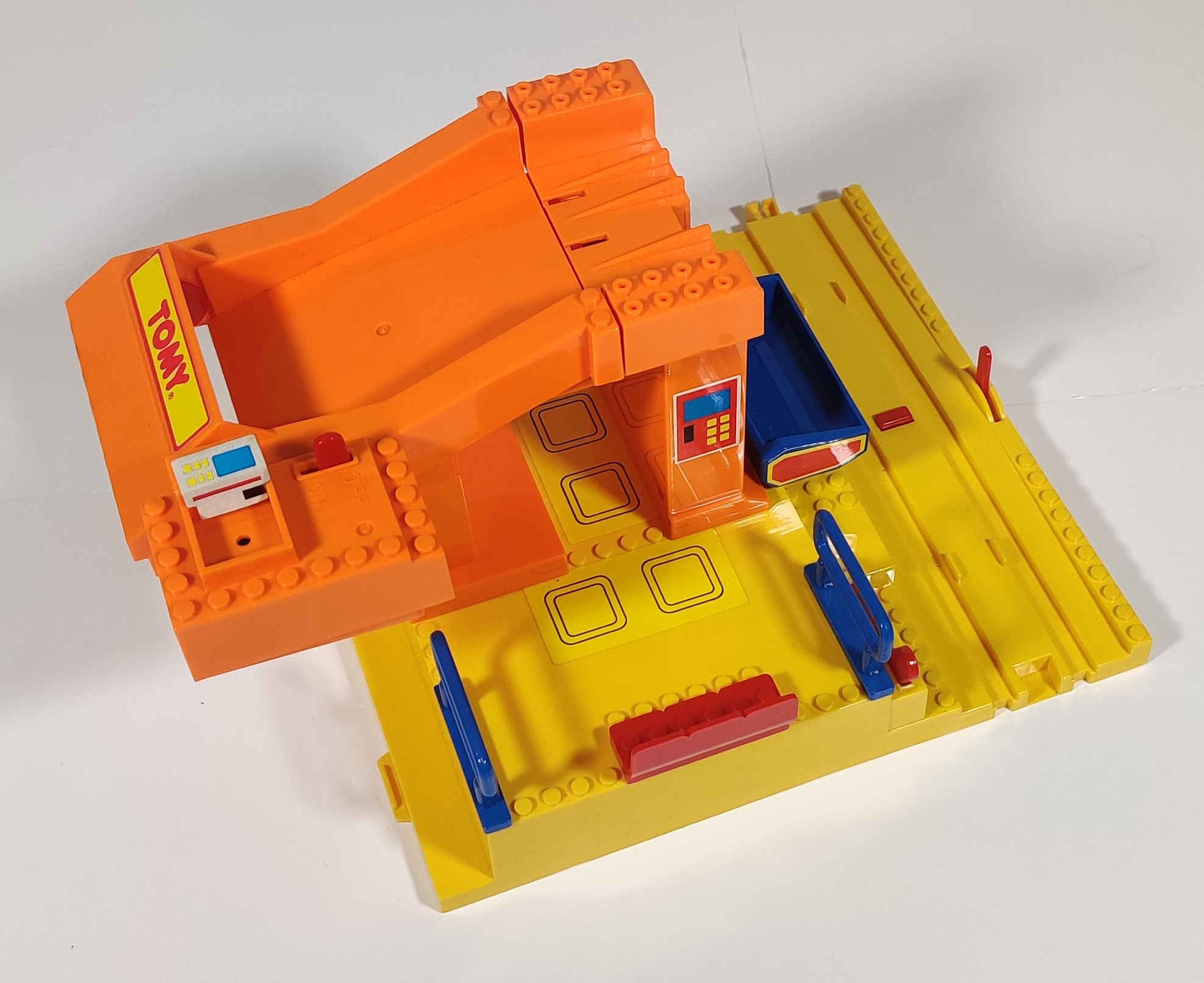
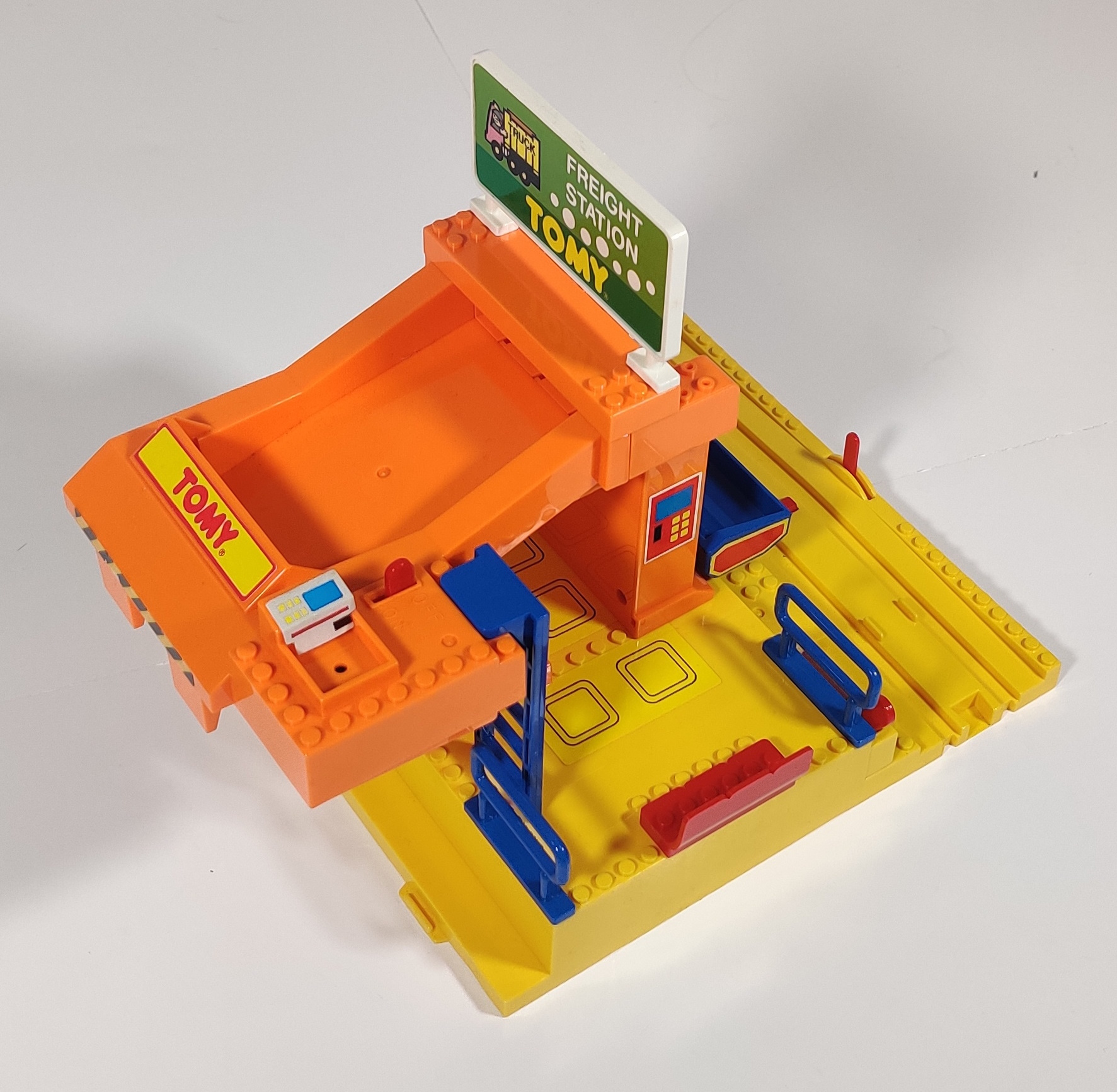
Like the earlier, smaller yellow stations, these use railing and three-wide seat pieces that fit over the studs molded into the bases which come in two variations - red and blue, with the railings always matching and the opposite color of the seat. The revised European Tomy Train 3 version comes with red rails and blue seats, while the American Log 'n Load Set appears to come with either variation, and the boxed individual releases are hard to pin down. For what it is worth, the European box shows red rails and blue seats and the American box the opposite. The station itself is made up from a series of interlocking orange components. A support block holds up the chute which the lift fits under. Then add the three-wide support beam across the gap at the top to hold it together, and add other accessory pieces like the ladder and sign.

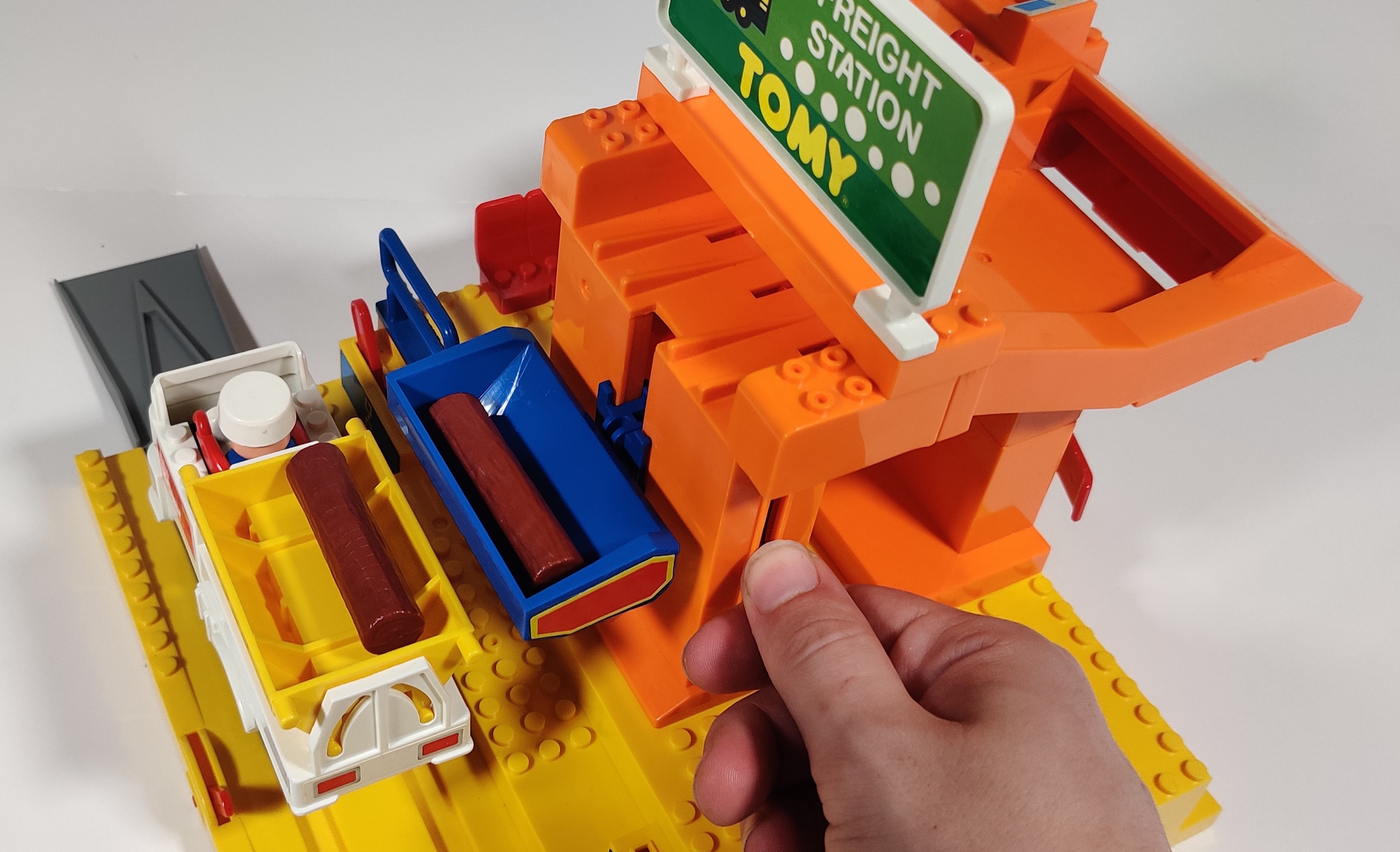
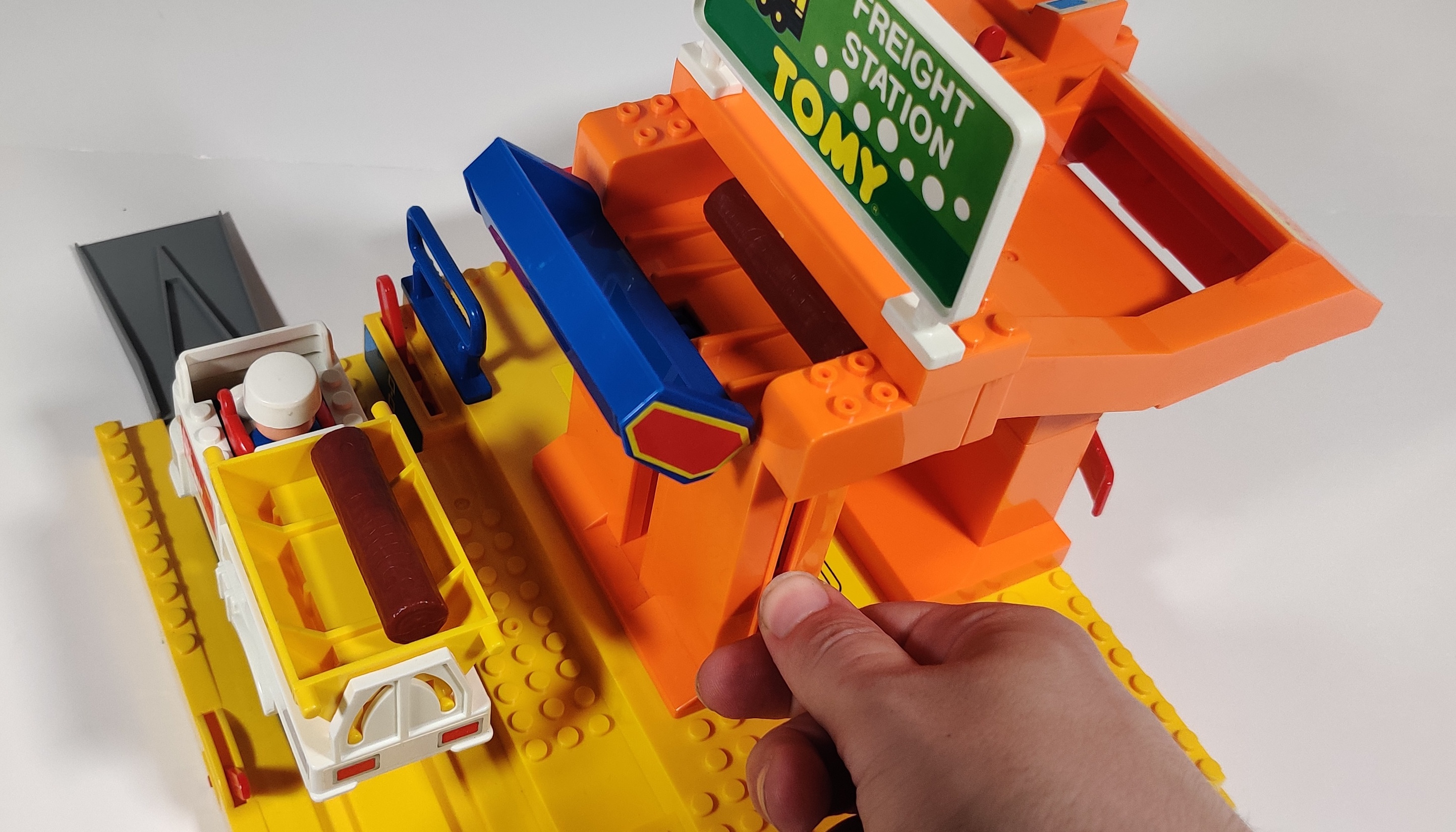
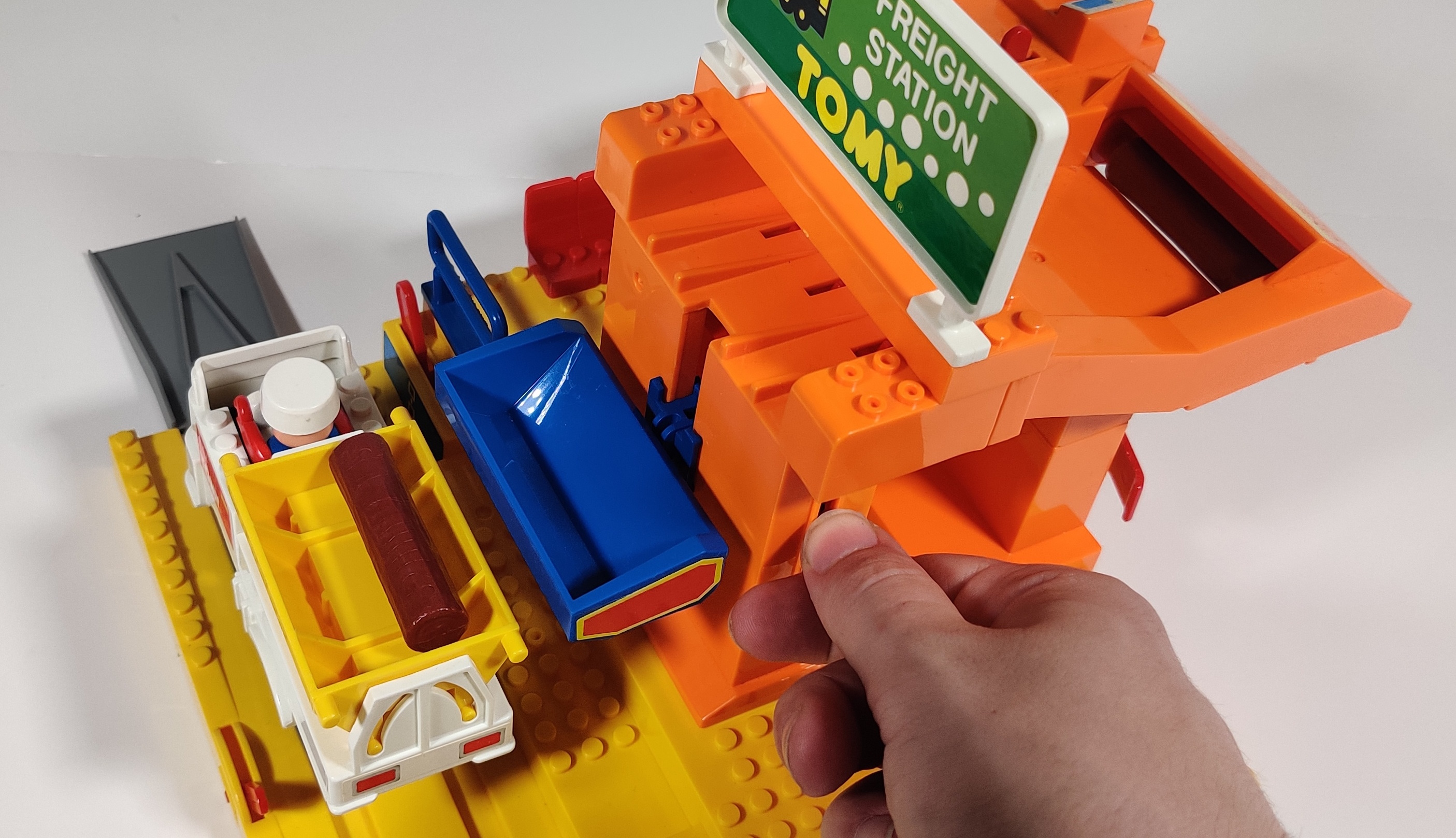
The log truck can drive up the ramps to the lift. The red stopper engages with a hanging catch in the truck's chassis which will stop it in the right position. The truck bed can then be tipped into the blue scoop. The red lever on the side of the loader lifts the lift up, and an interlock stops the log at the top of the chute until the lift starts to drop, at which point it rolls down to the loader. Additional logs pile in behind the first.
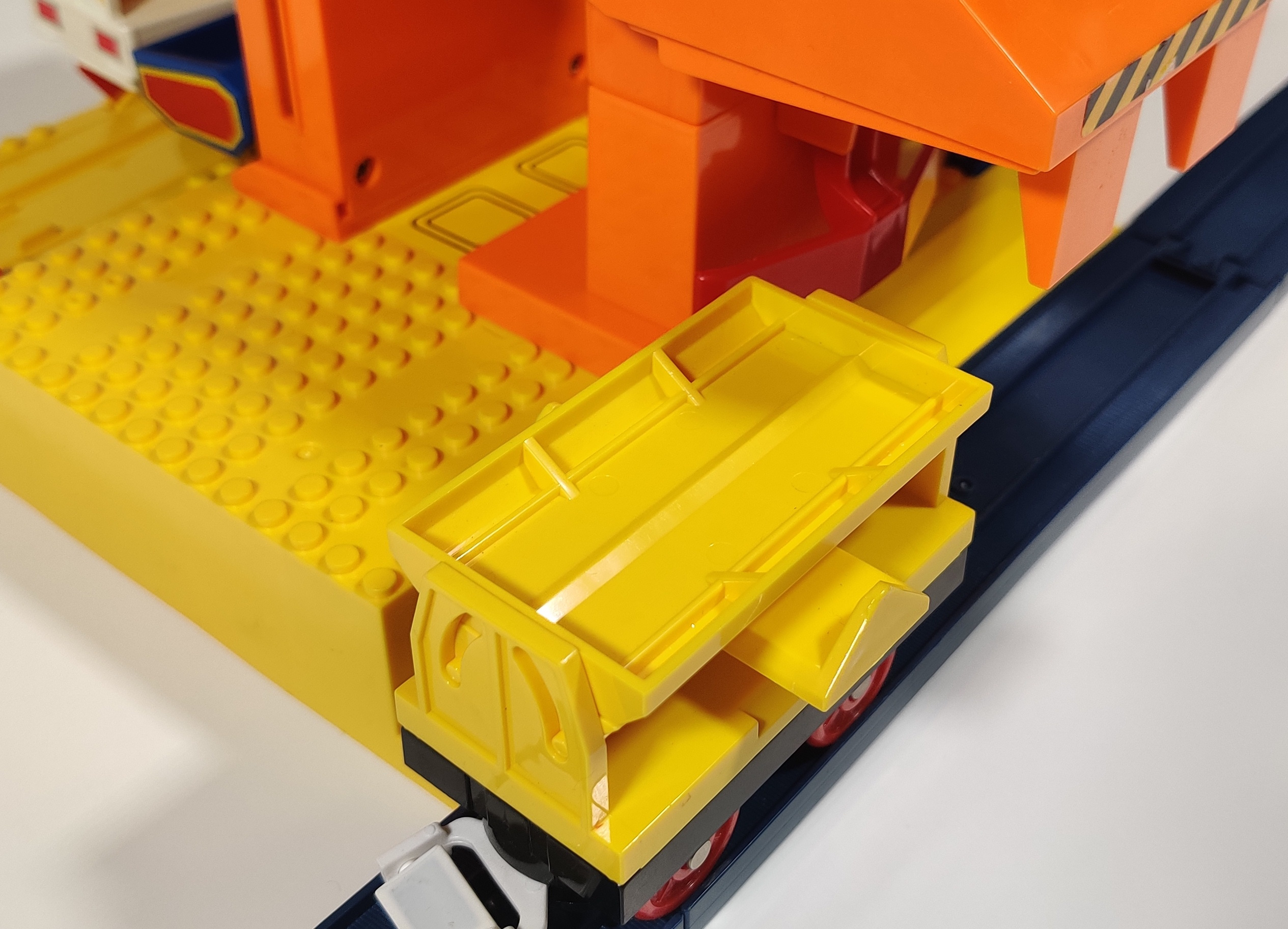
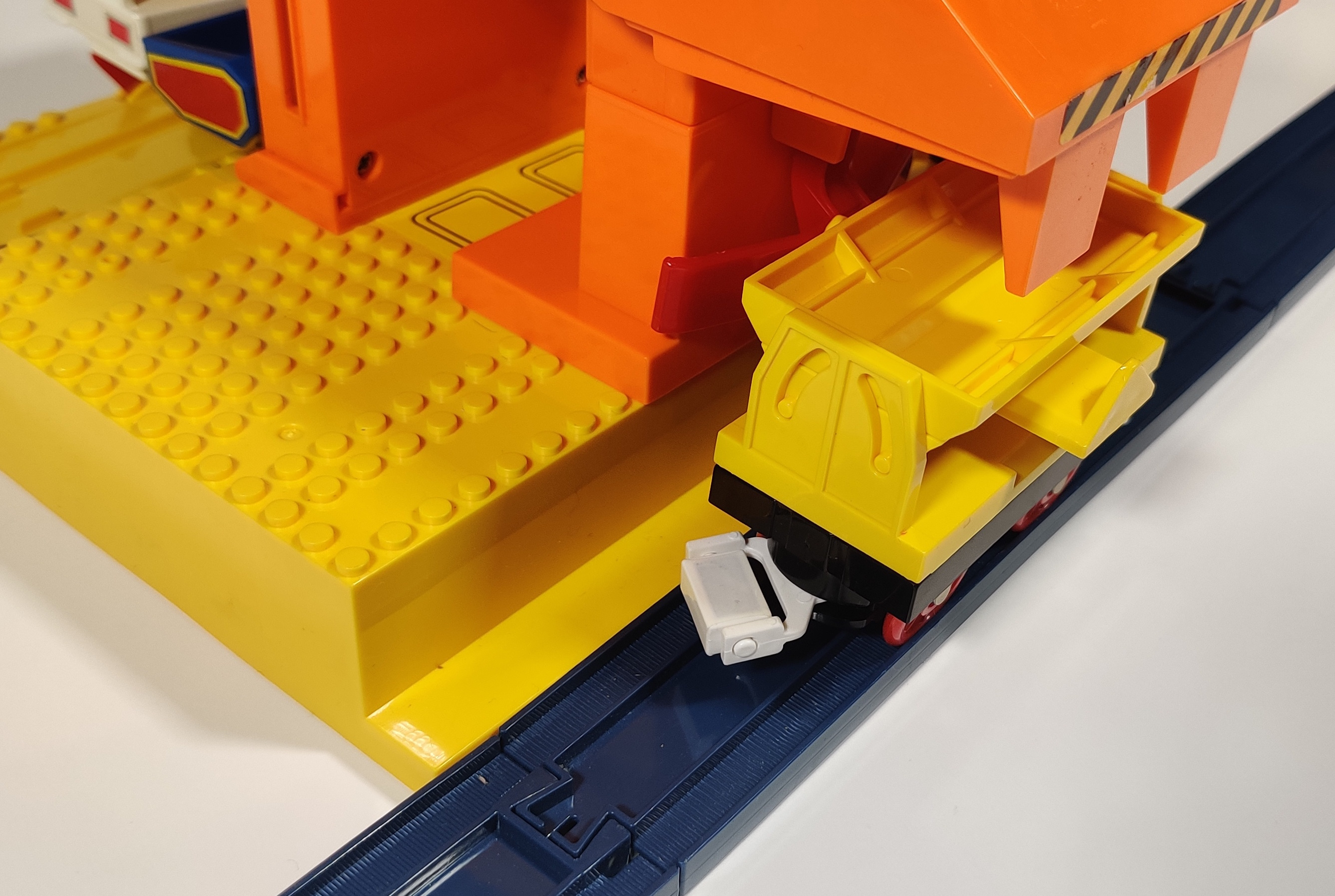
The yellow tipper wagon has protrusions on each side, one purpose of which is to hit the red trigger under the loader to drop a log. Clips on this side of the yellow base hold it up against the track.
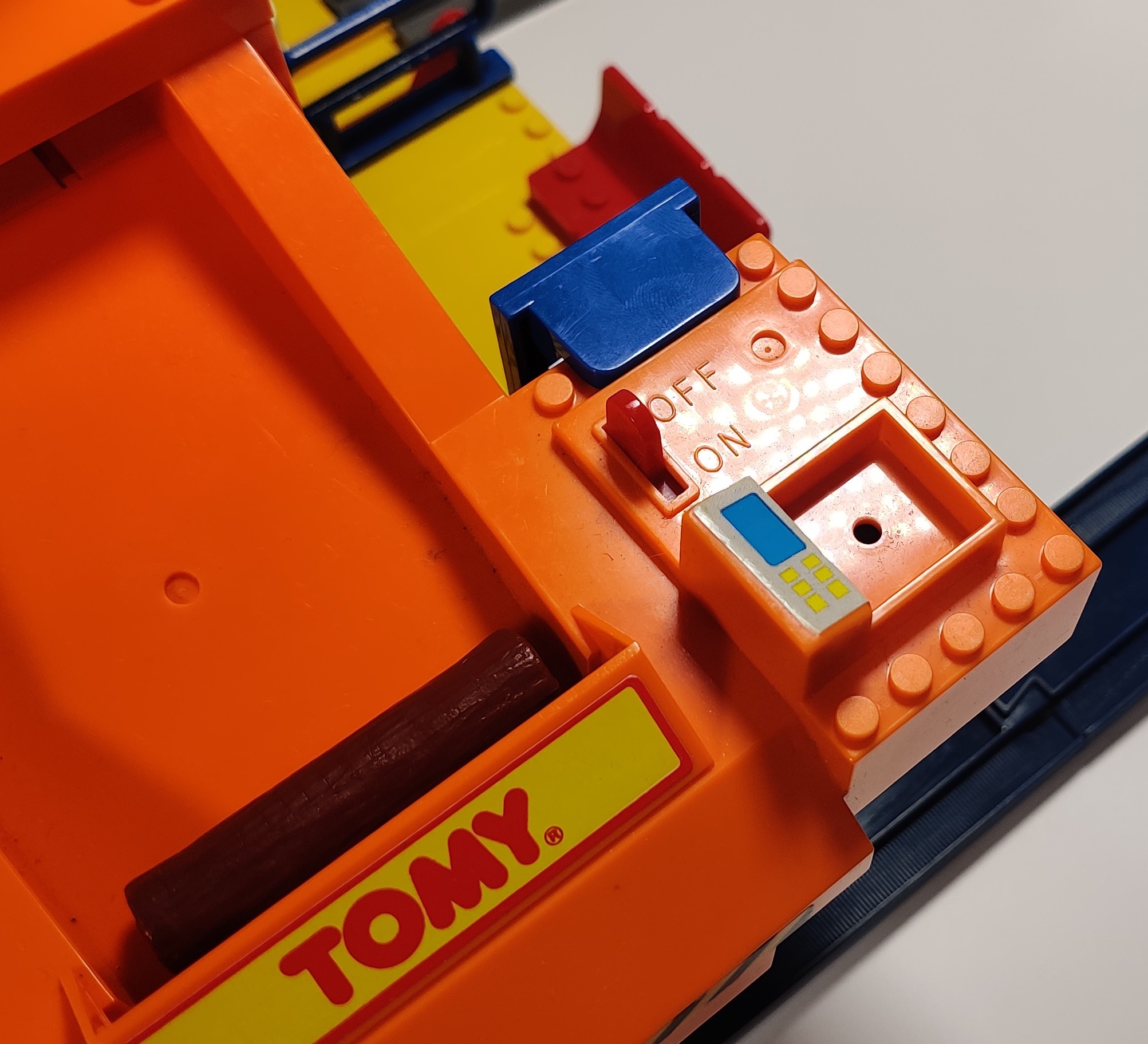
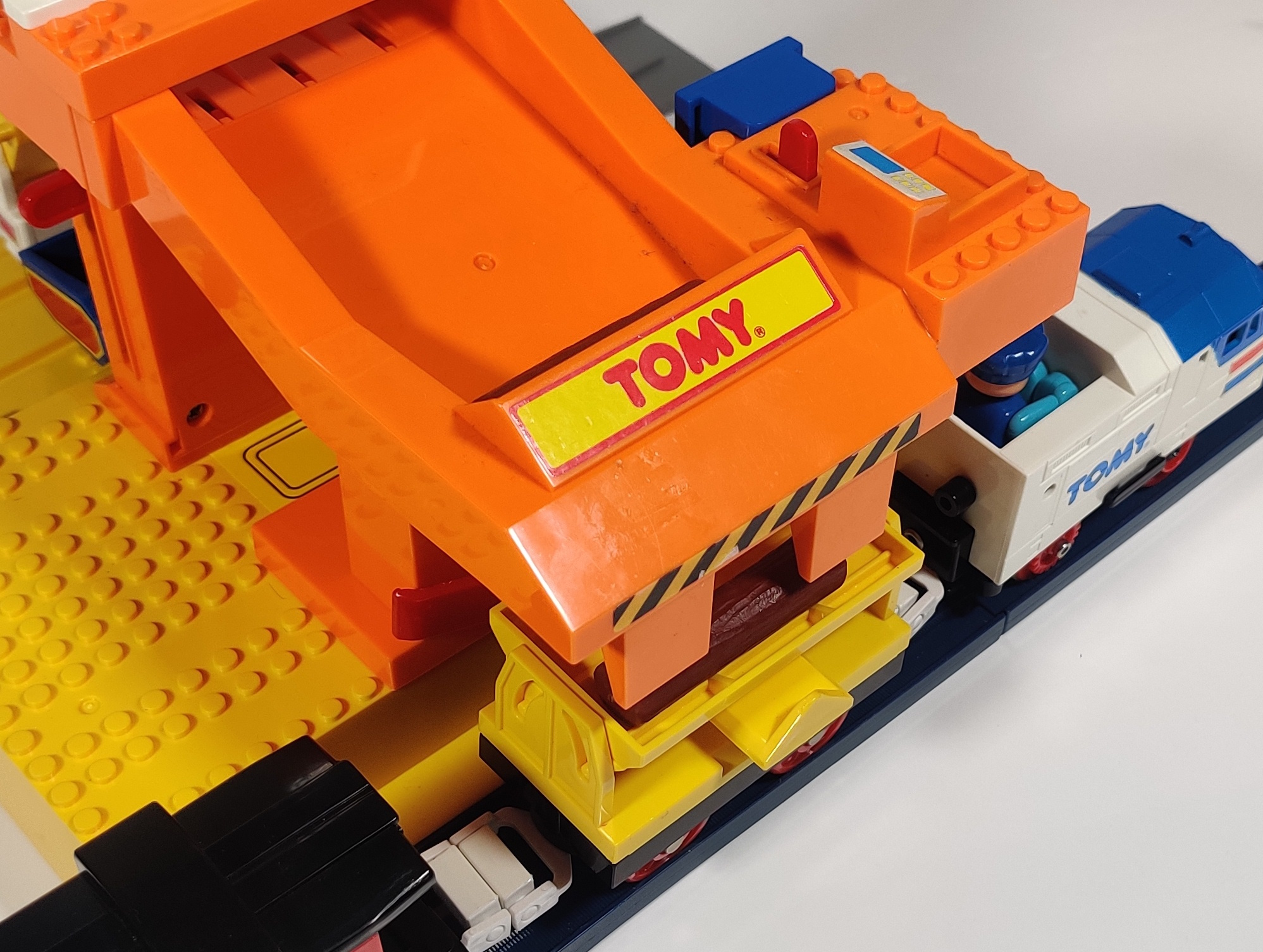
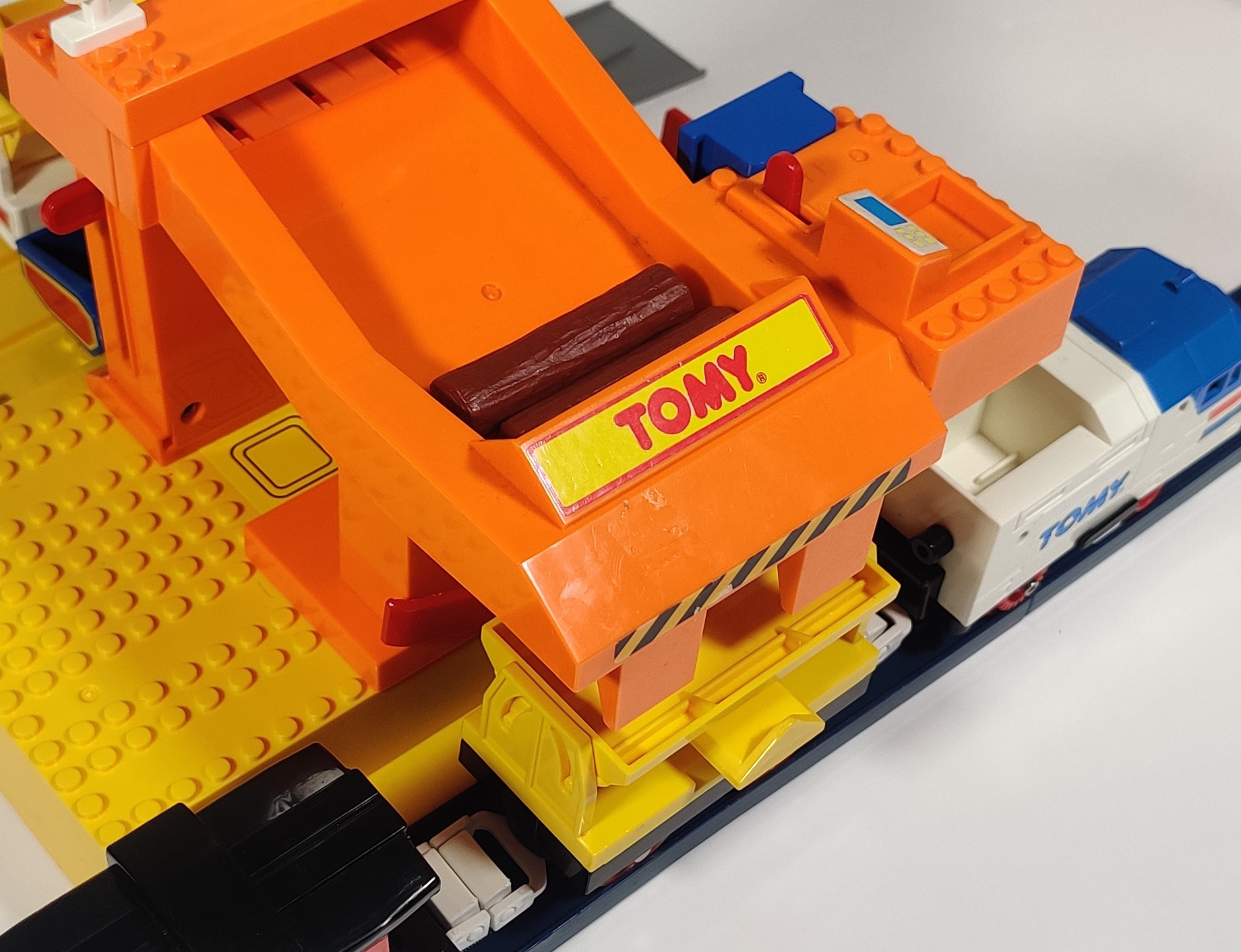
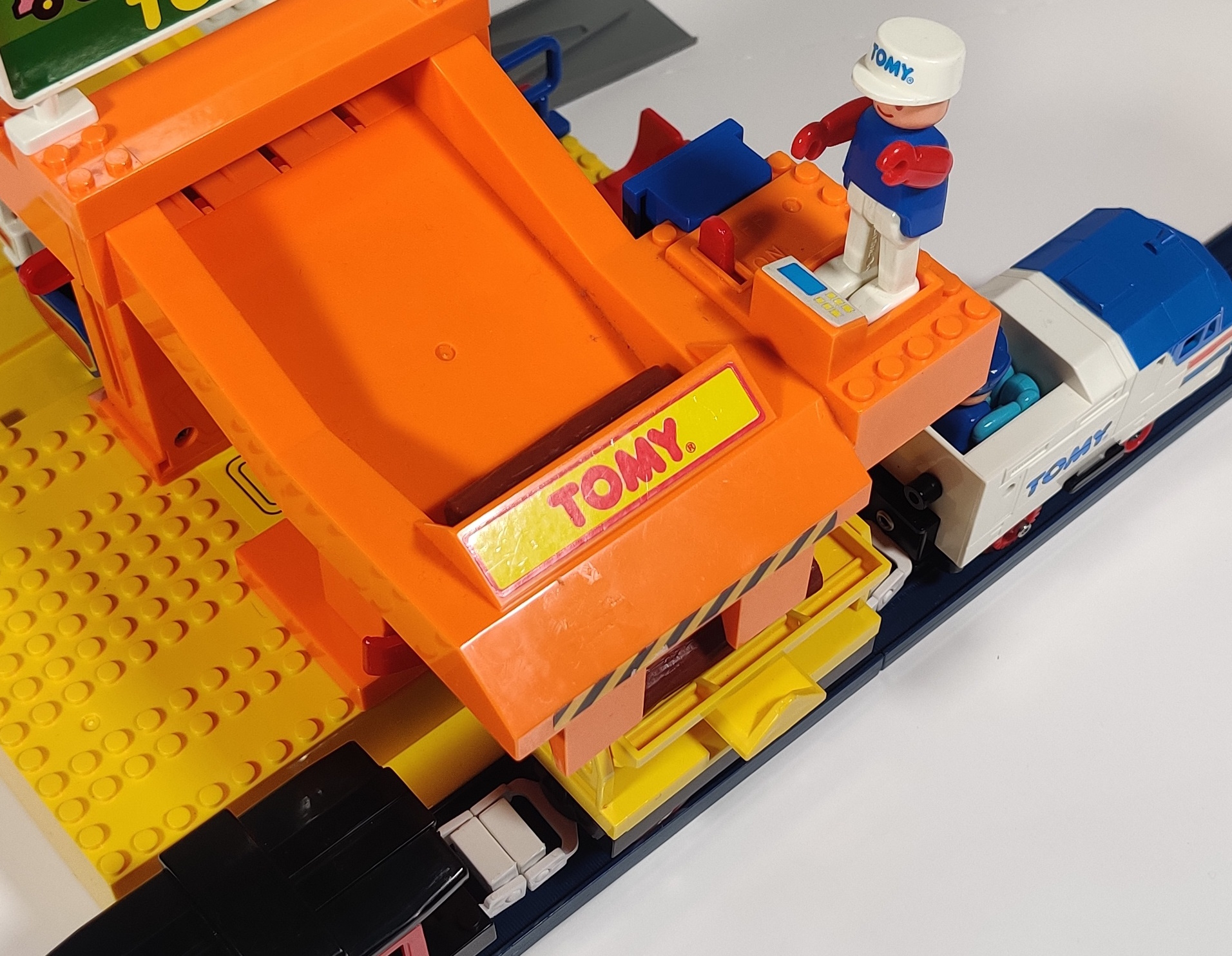
The log chute has an ON/OFF control with an additional magnetic feature with the nearby operator console. If the chute is set to on, it will dispense a log when the train passes, but if it is set to off it will not drop a log unless a figure (with magnets in its feet) is standing at the operator's console which overrides the mechanism to allow a log to drop.

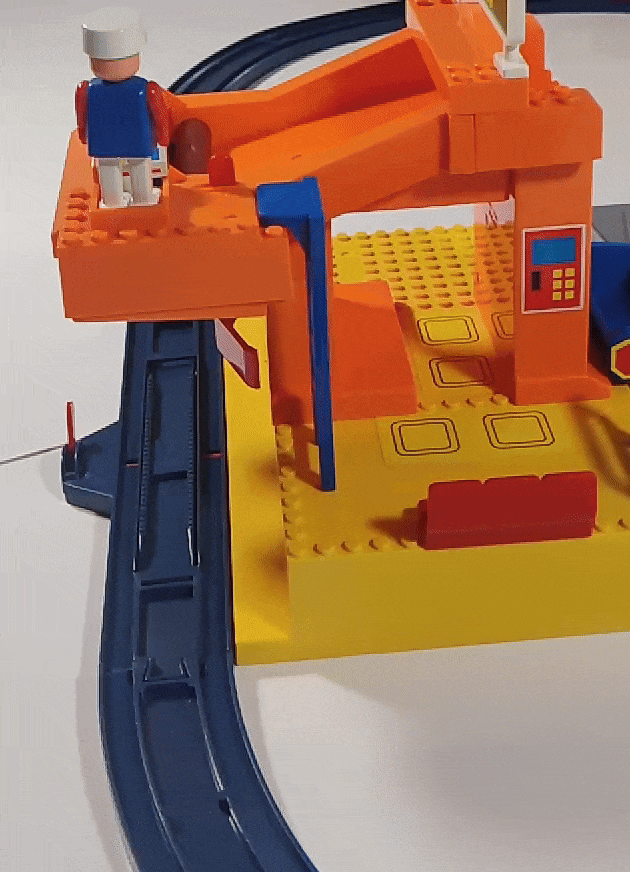
The action of the log loader is "chunky" in the way that Tomy Train kind of is and it is fun to use. All of the stickers are done in the earlier style of the series and I think they look very nice.

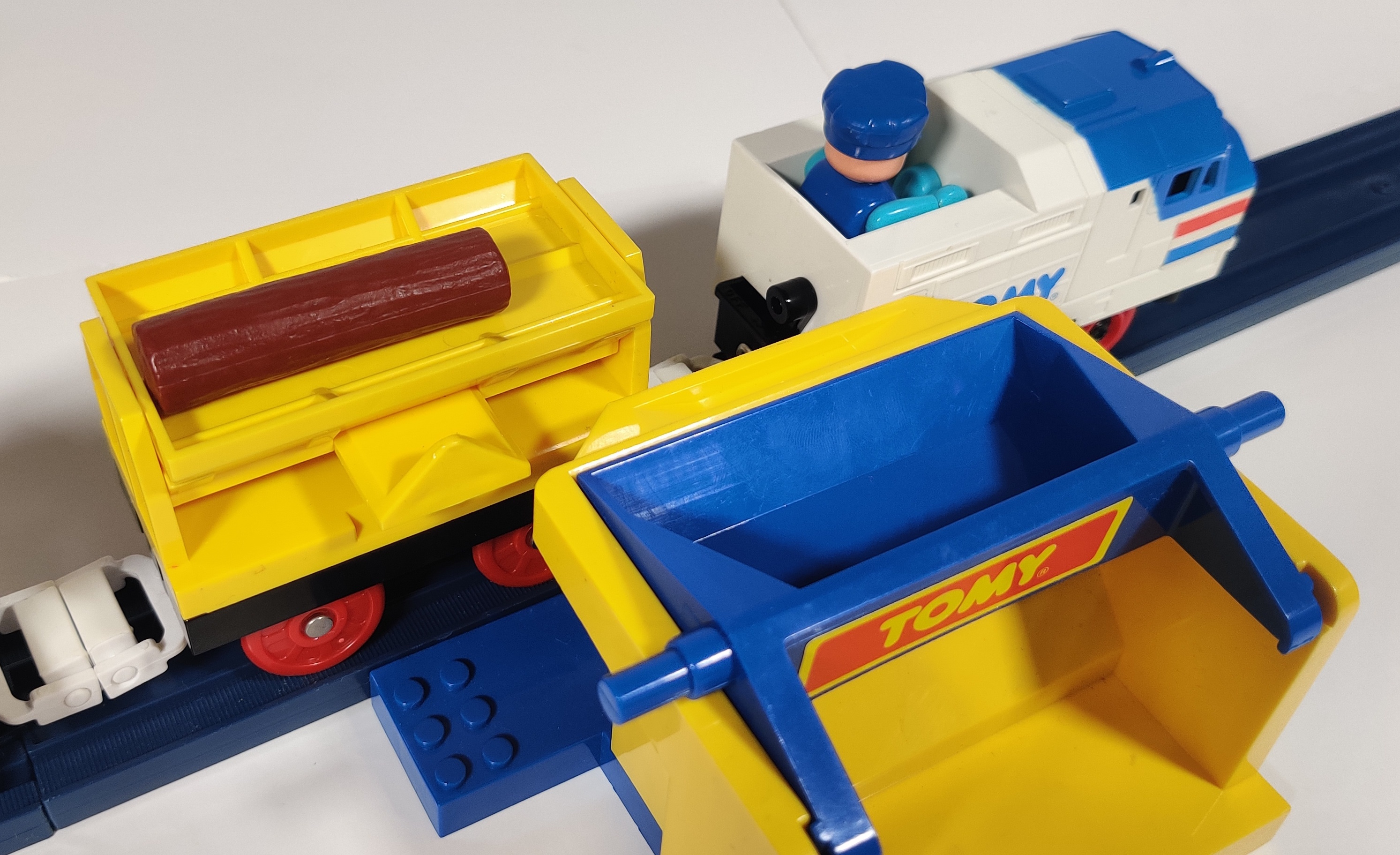

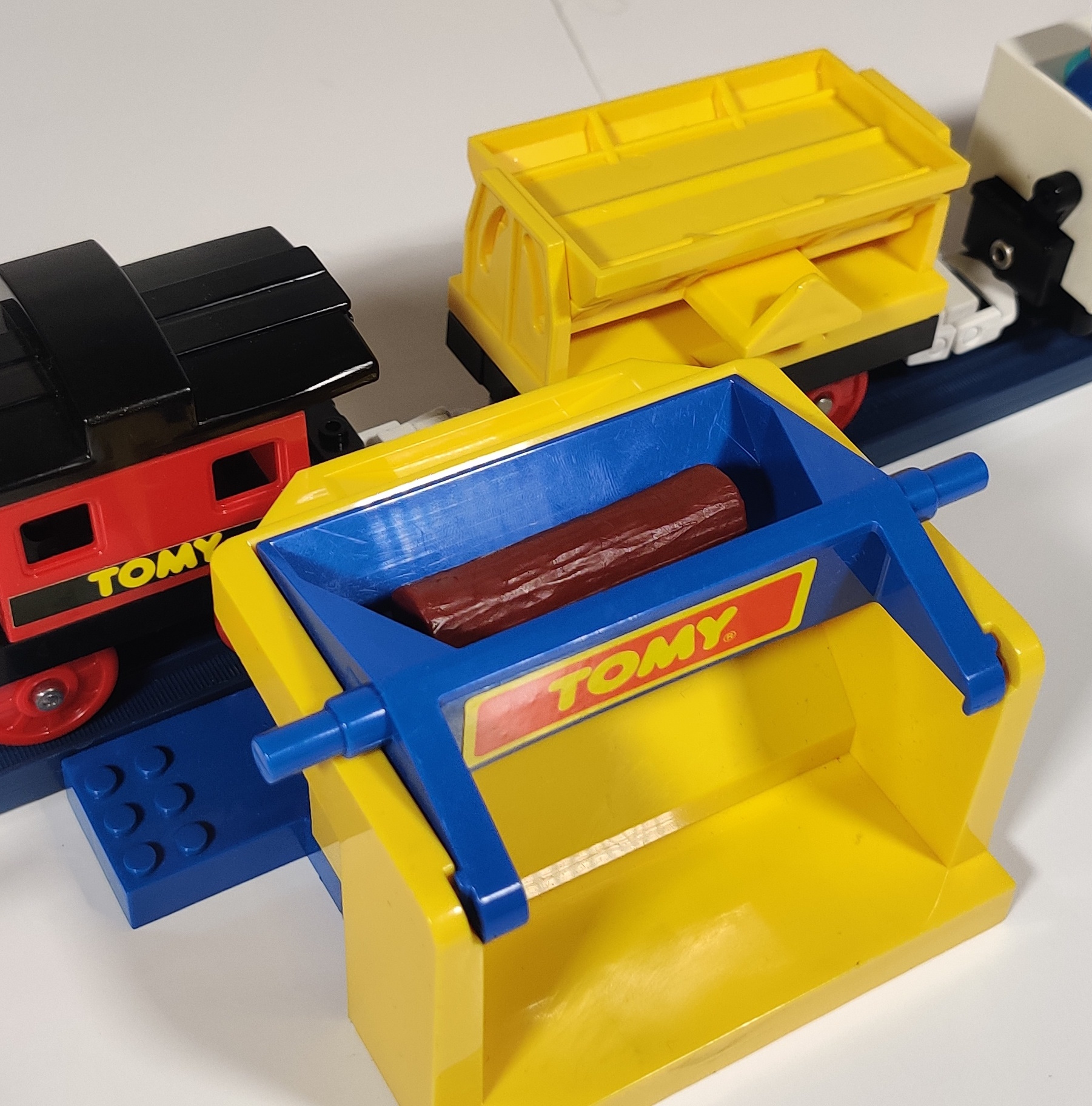
The dumping depot automatically collects any logs in a tipper car when the train passes. A lip catches on the protrusions on the side of the tipper car and tips it to dump any logs inside.
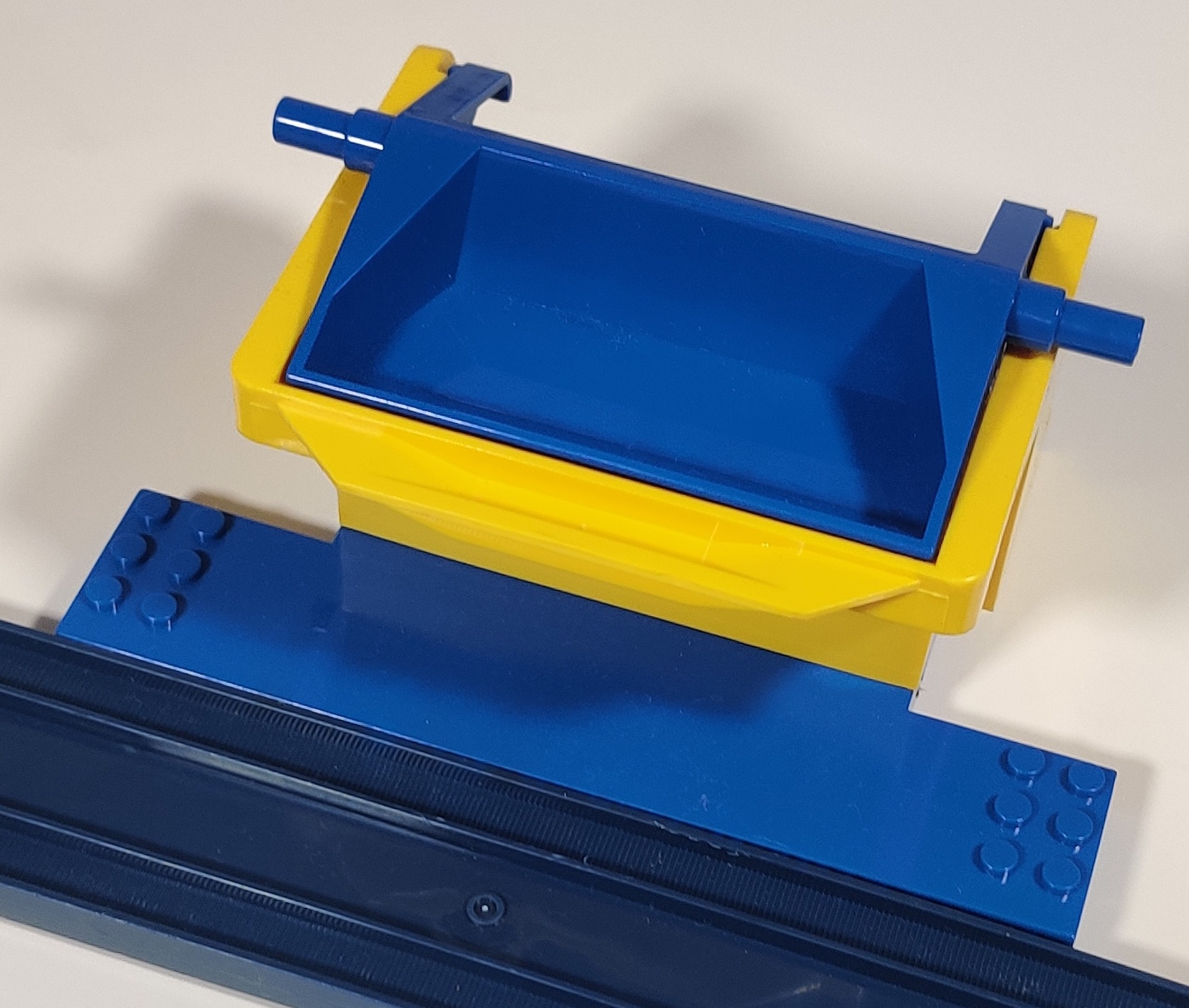
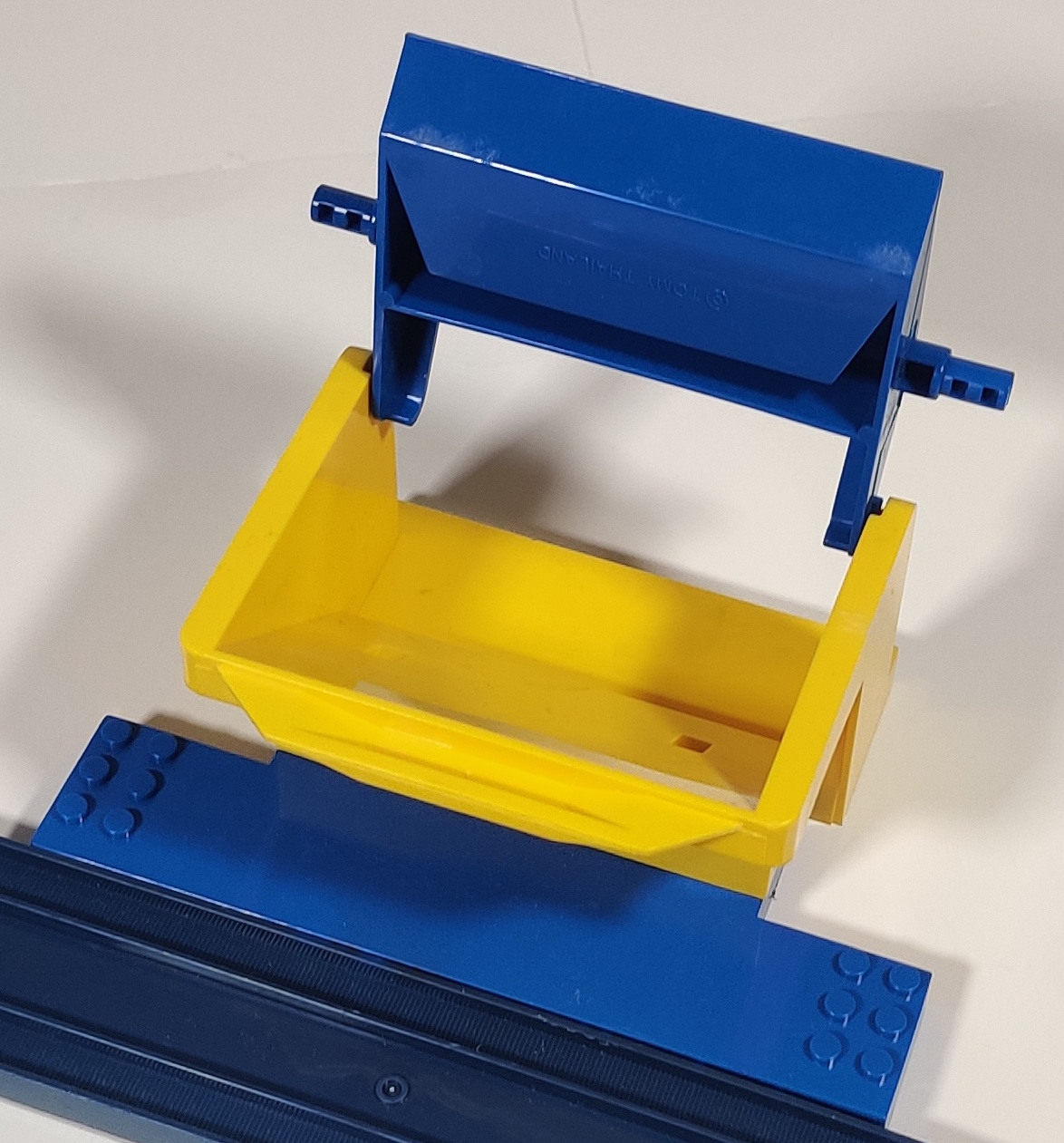

The depot itself can be tipped up to drop logs into a log truck that is lined up against it.

The log truck has a push-down friction-drive mechanism inside that means when you push the driver figure down the truck goes jetting off. This is usually pretty quick and a little uncontrollable and/or a little underwhelming, depending on how much energy the mechanism absorbed and how good the truck's traction is when you release it.
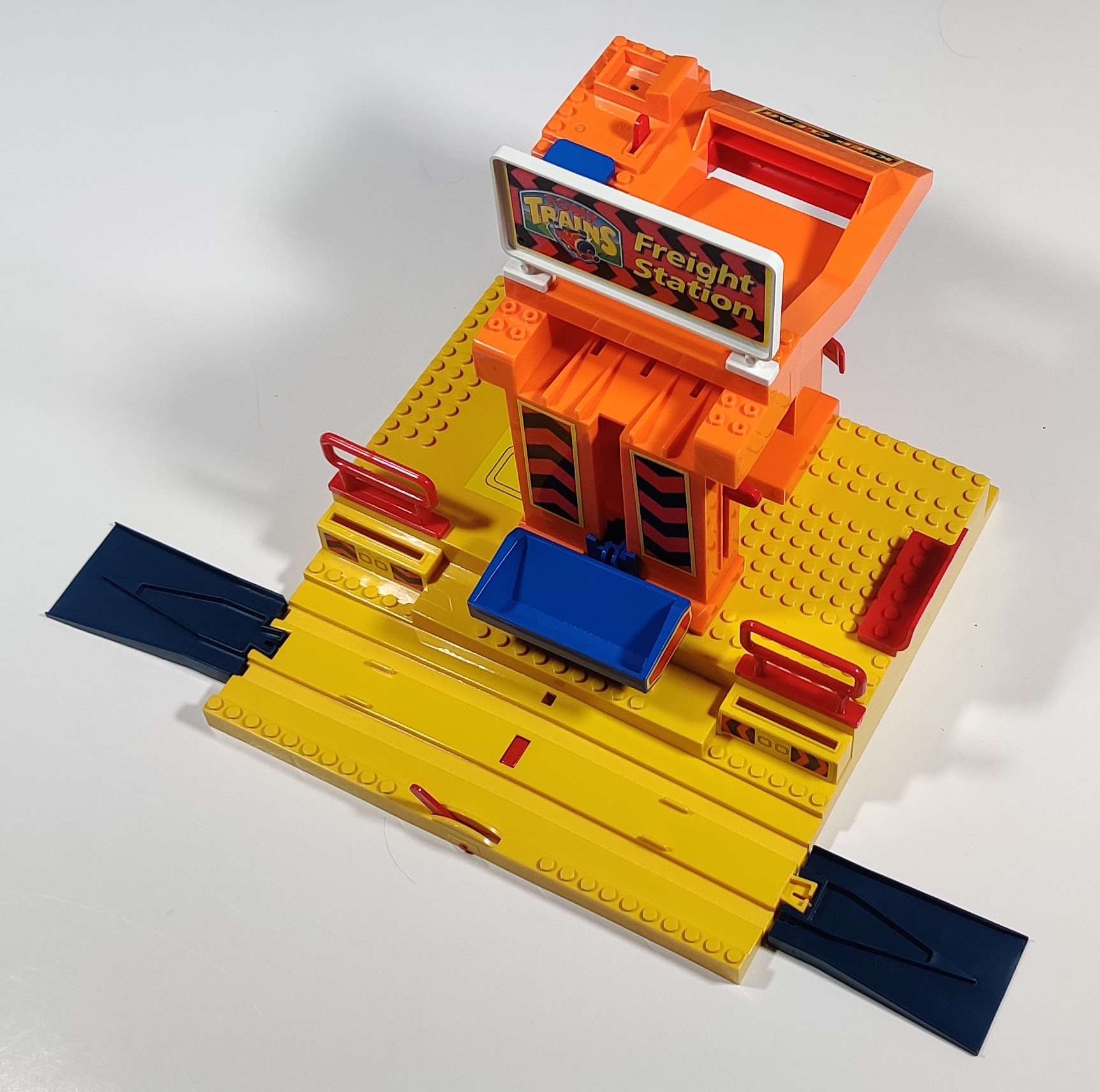
One of the coolest Tomy Train accessories. Also released with different stickers in the Busy Freight Train Set.
1325 Turntable and Engine Shed Accessory Set (1991)

Accessory pack featuring the small Plarail turntable refit for Tomy Train locomotives, an engine shed with integrated stop and return rail, straight rail, half straight rail, return rail, stop rail, and two buffers. Easiest place to get the "engine shed" outside of sets.
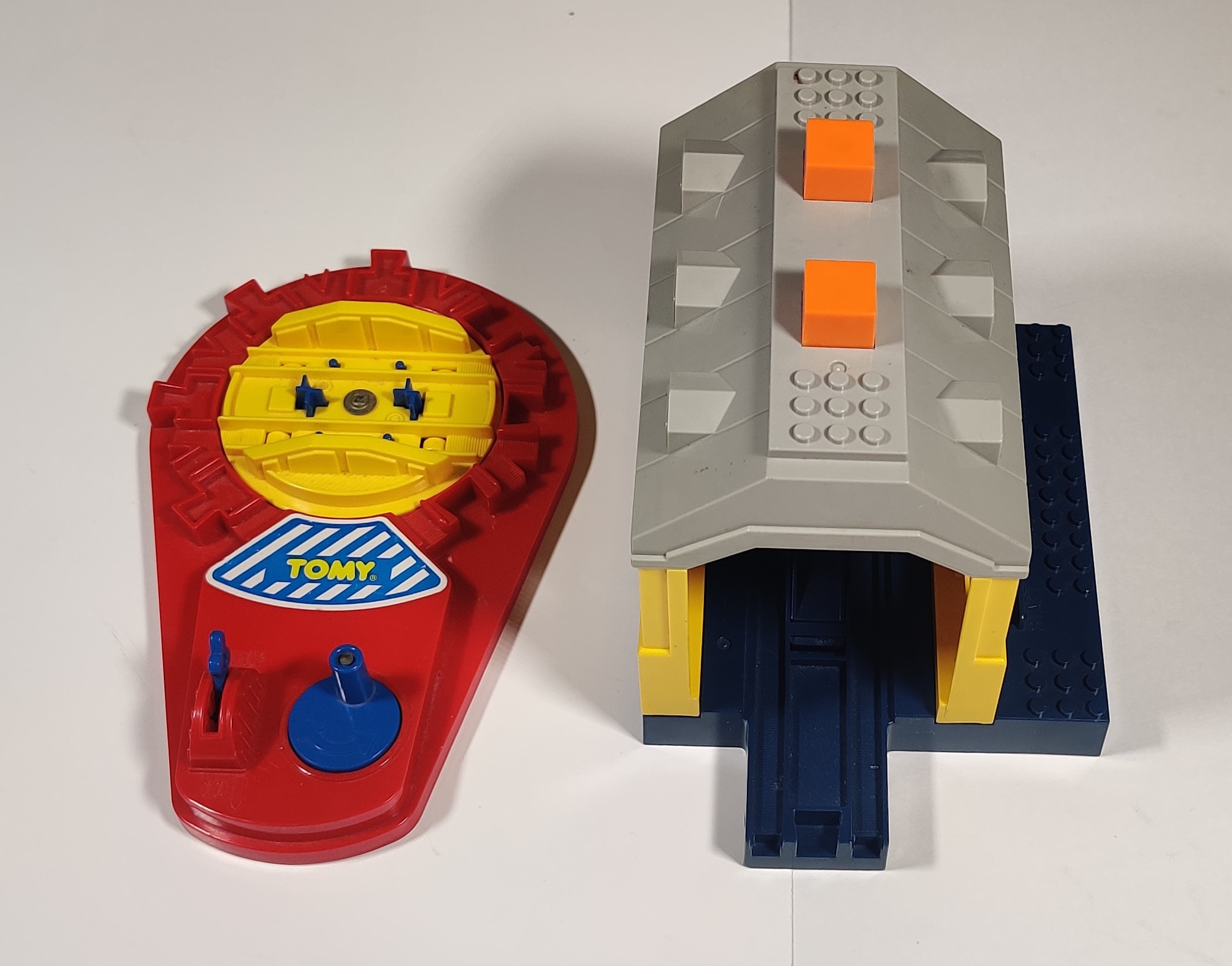
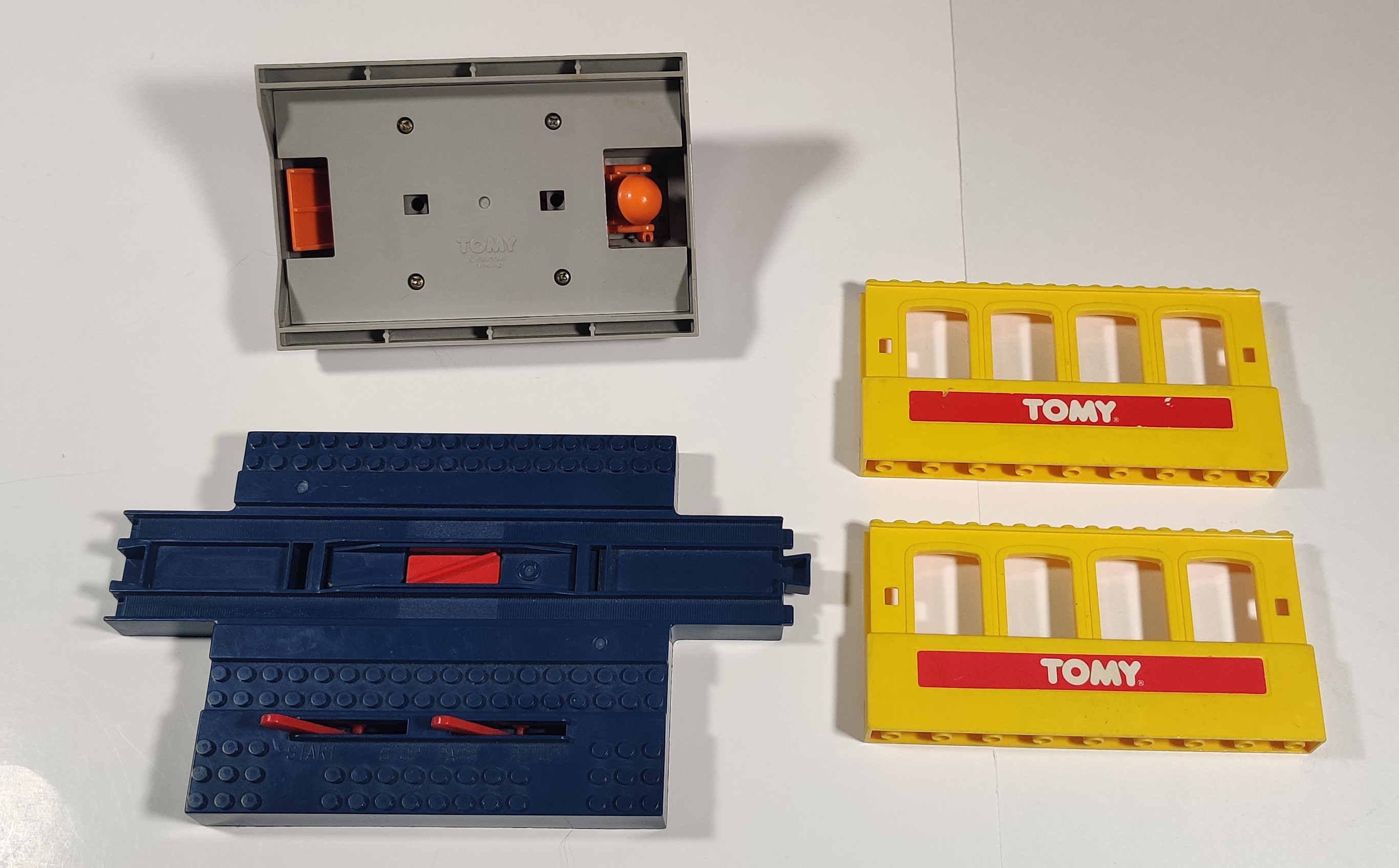
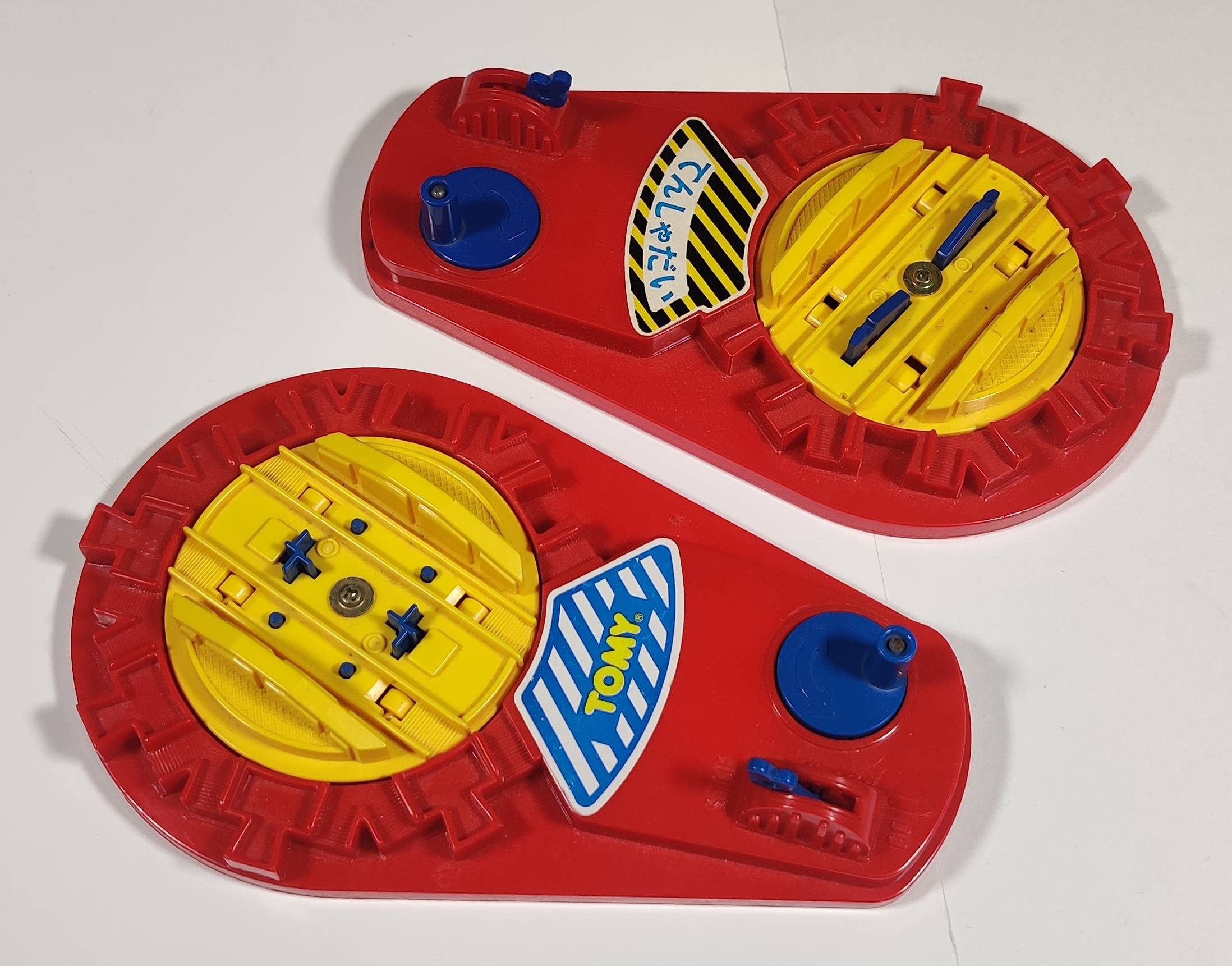
The shed is made up of two walls, a roof, and a base piece with integrated stopper/reverser. The table of the Plarail J-08 New Turntable it is based on had to be adapted to properly catch a Tomy Train engine - the little bumps sticking up cause the first catch an engine encounters when entering the turntable backwards to drop out of the way so that its reverser pin properly locates in the second catch, correctly lining its wheels up with the rollers. Sold in Tomytrain, Tomy Train, and Tomy Trains packaging - do you see why this range is a little annoying to collect?
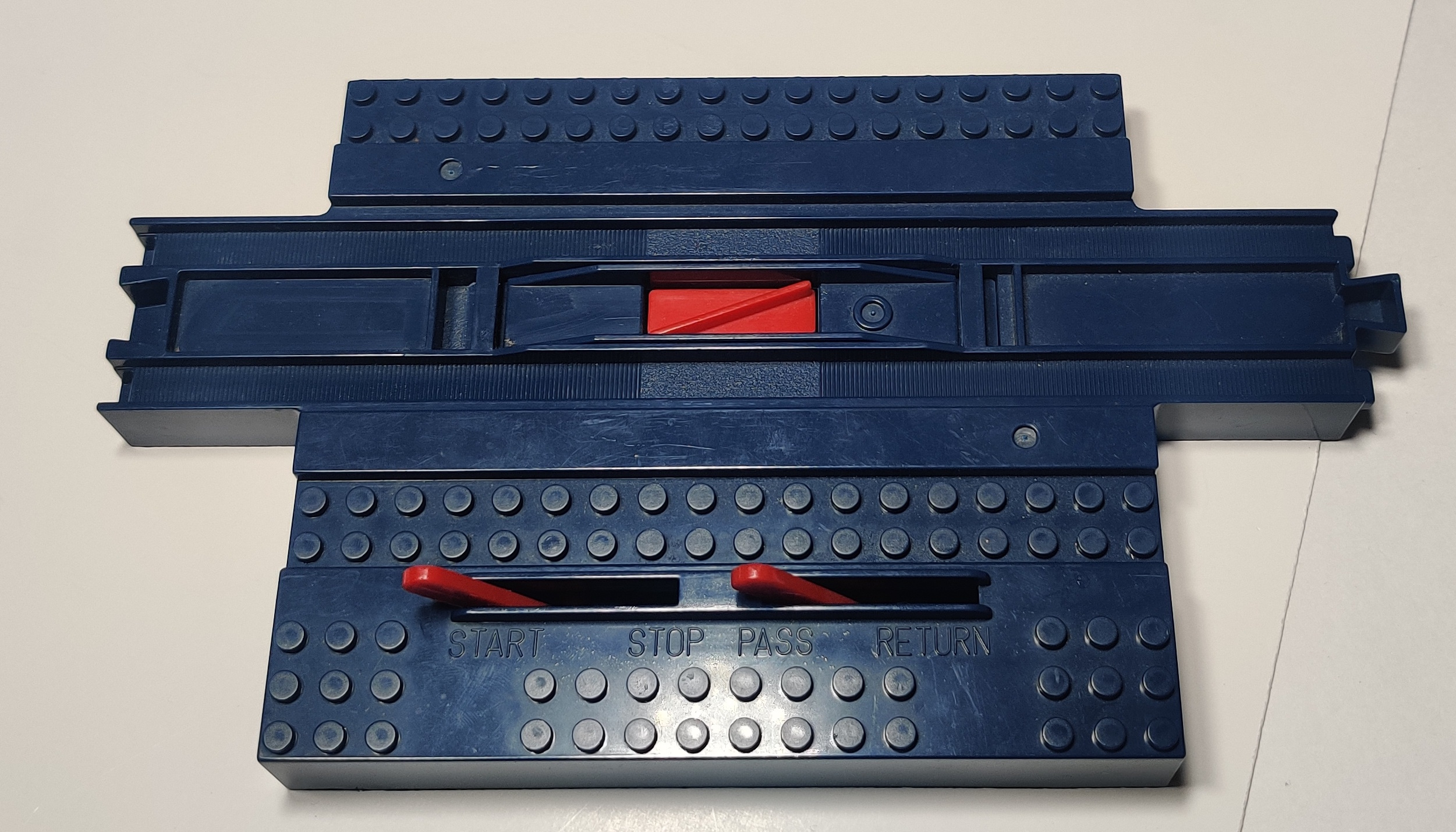

The shed base has two controls for START/STOP and PASS/RETURN. Using a combination of these levers you can reverse or stop any incoming train. You can stop a train and then decide whether to reverse it or let it pass.
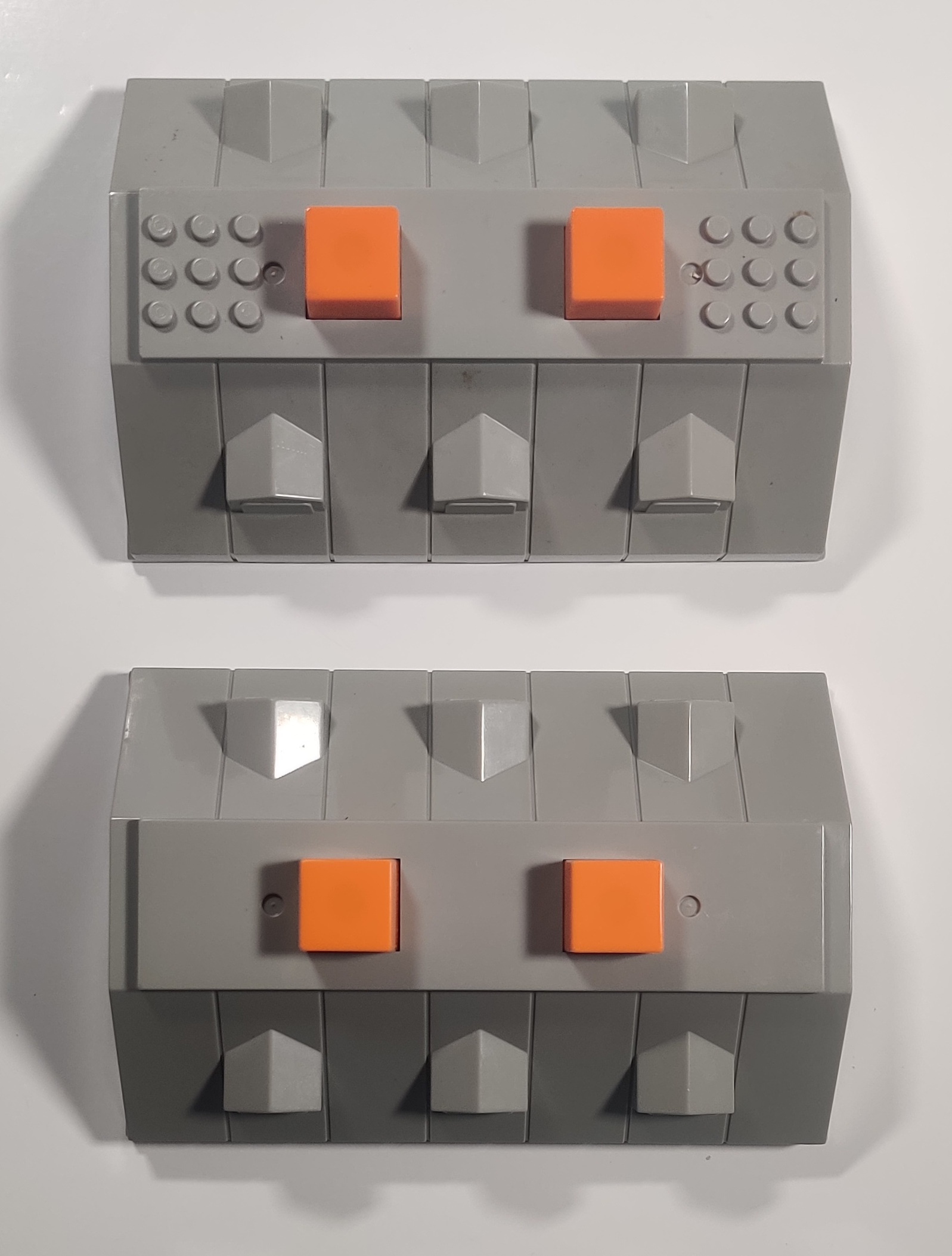
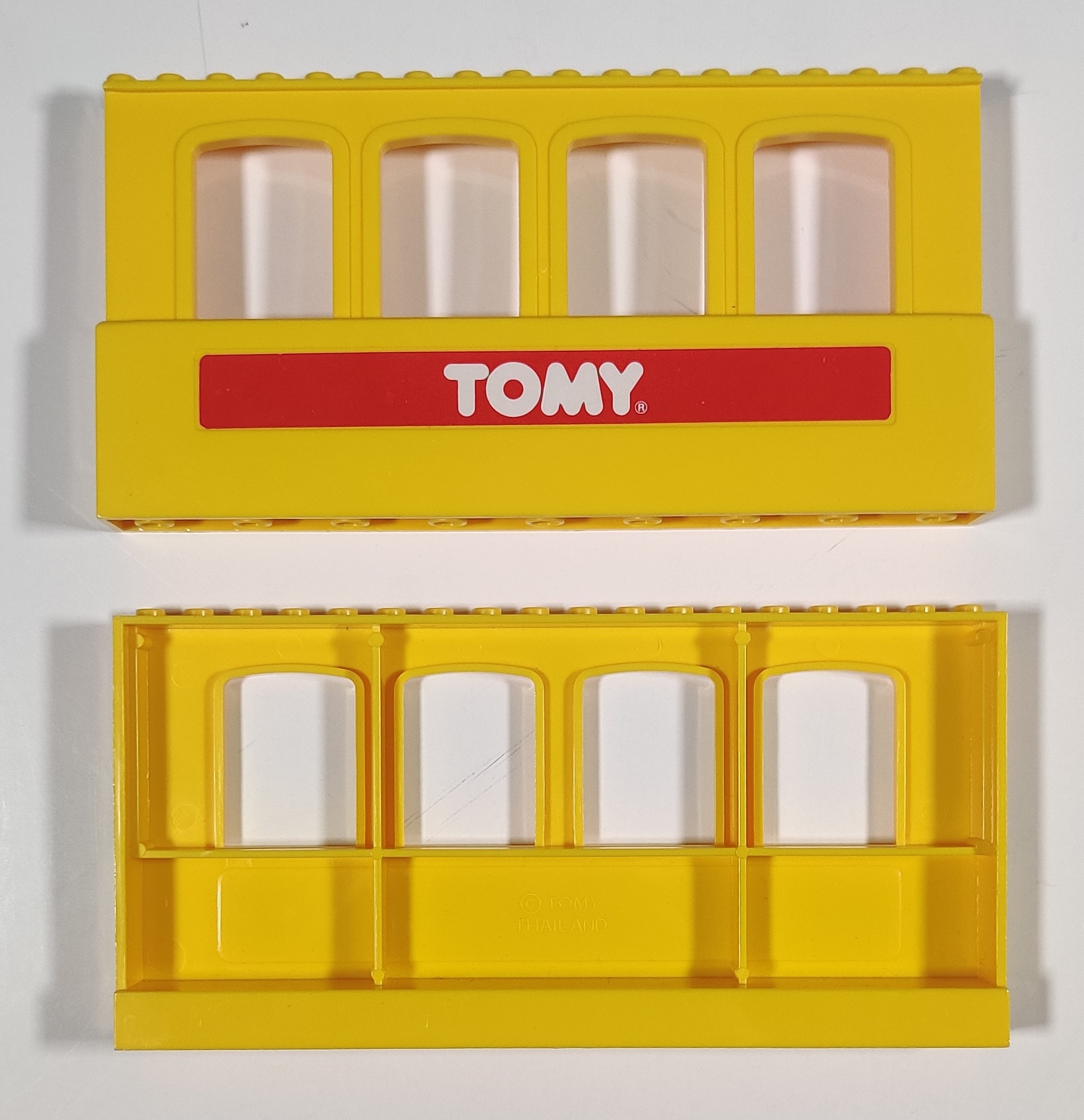
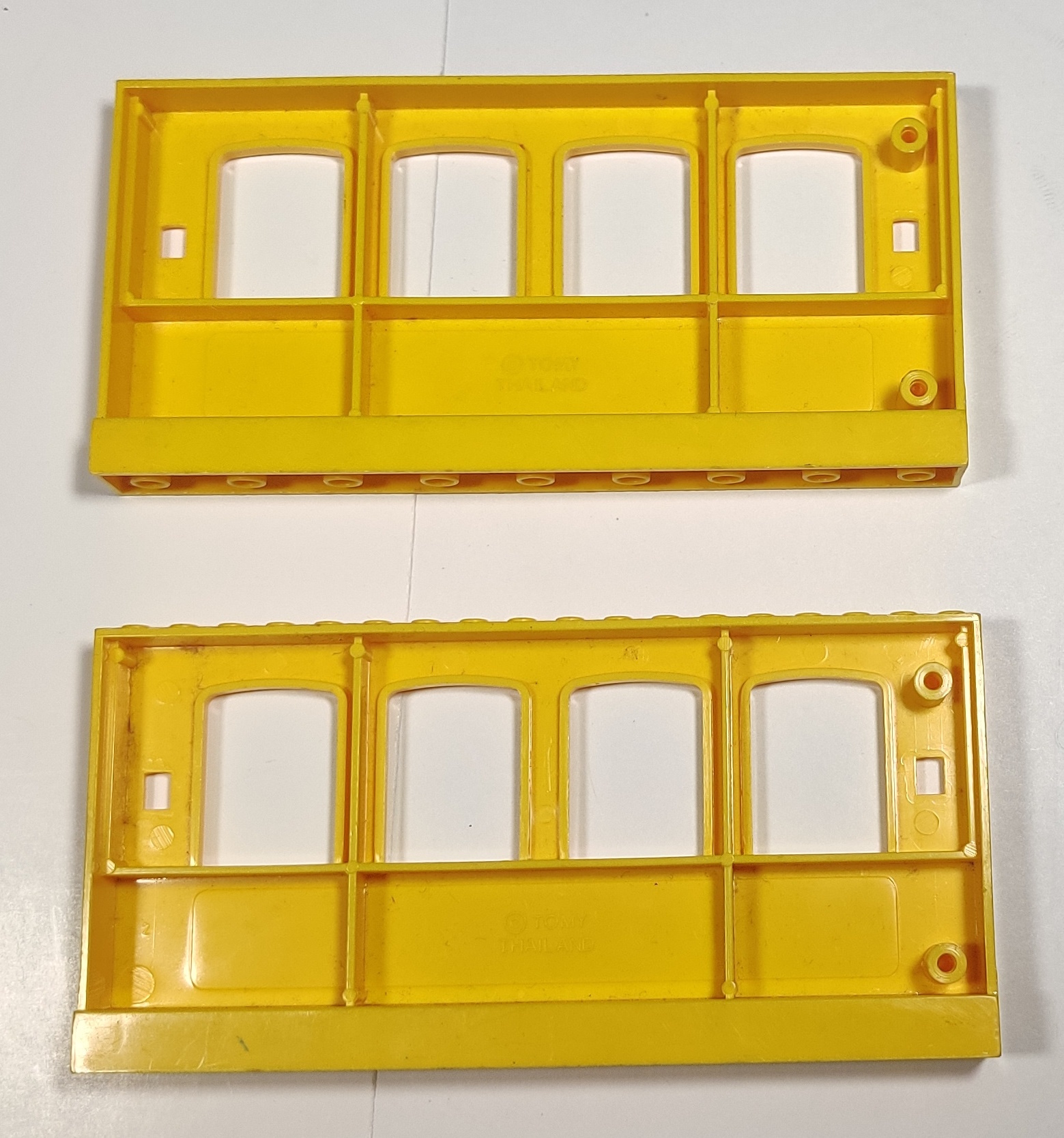
Circa 1993 there was a variant with no studs, but it seems most if not all European versions as well as the later Thomas-series sheds all seem to have studs. A version of the roof used in the Thomas and Percy's Big Adventure set do not have the worker or sign dropdowns, and the inside of later wall sections have molding remnants from, I believe, the funhouse variant from the Euro Park set.

The turntable will stop any incoming train and has a crank to turn the table (the table moves in the opposite direction to the crank) and a lever that will drop the stoppers and release the train on its way. Together, they can be used to turn and release a train, let a train pass through, or other similar operations.
1326 Suspension Bridge (1991)

Pack that incorporated the mini block pier system into Tomy Train with eight red mini block piers, four yellow suspension bridge sides, four straight rails, two of each sloping curve rail, and one of each joint rail. More common in Tomy Train packaging than original Tomytrain.
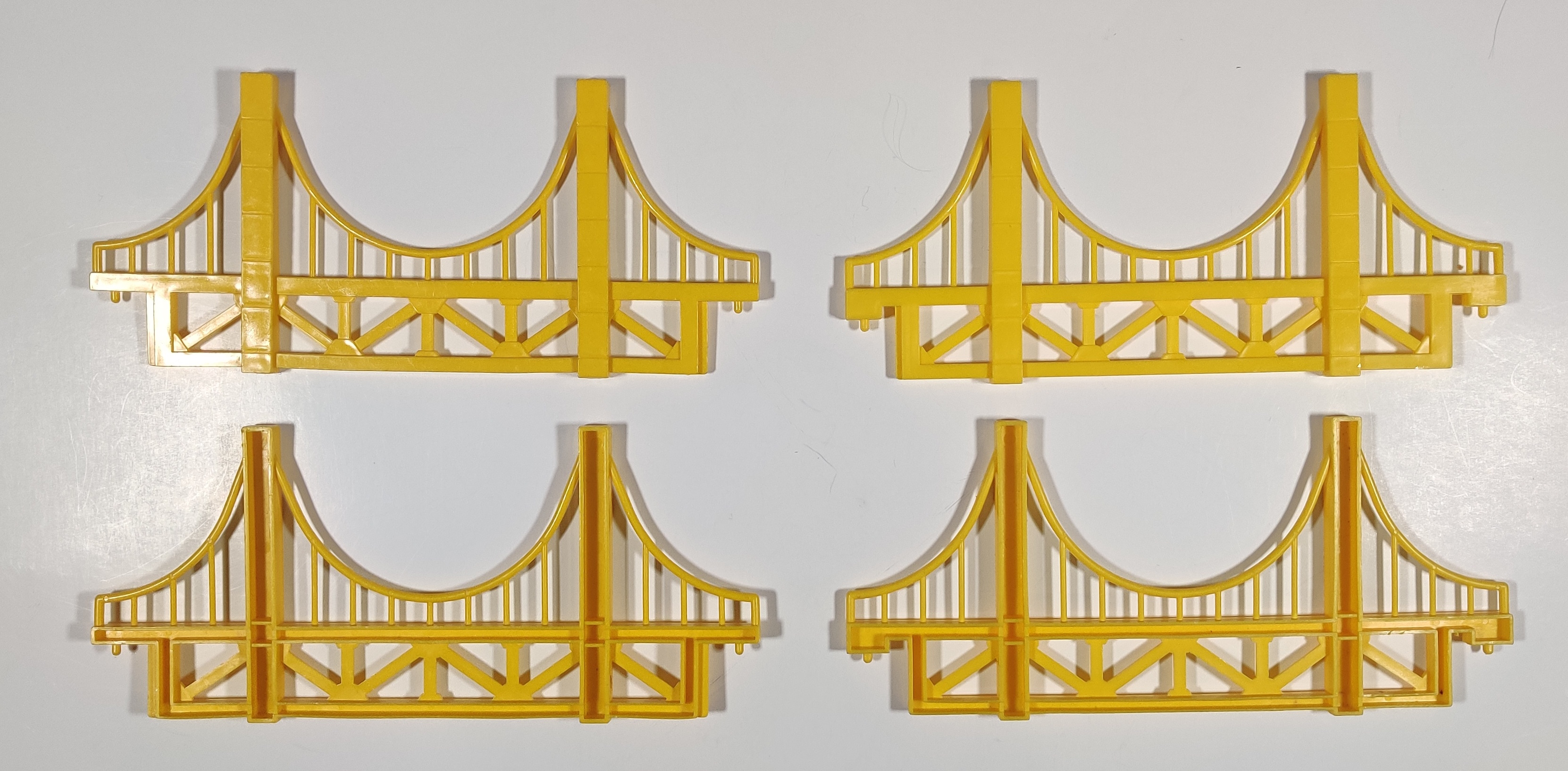
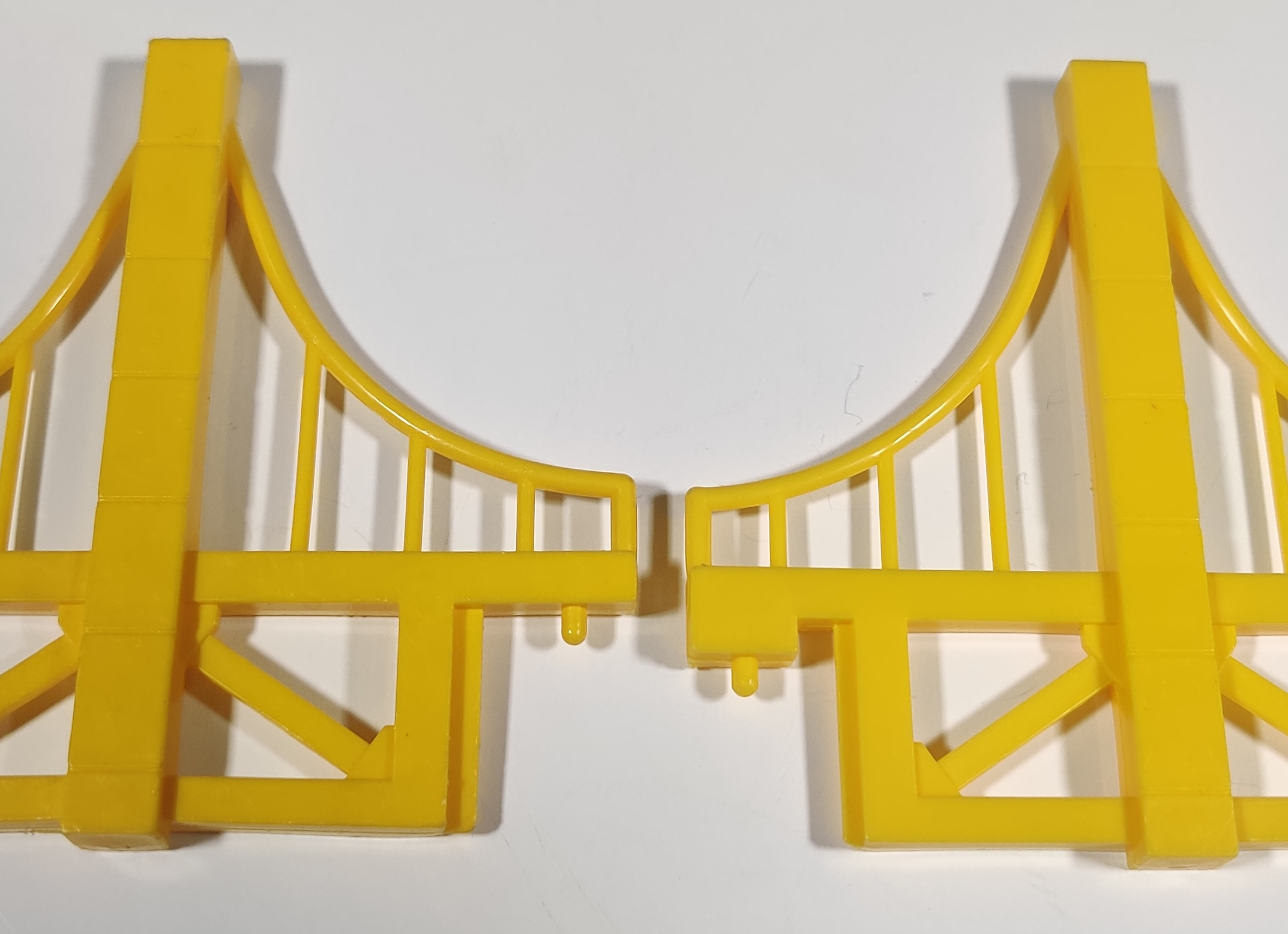
Early types have a shorter connection peg support - this tooling was used for Plarail starting around 1988 and the tooling was updated during Tomy Train production. The newer type sits a little taller on the block piers anyways.

This bridge looks even cooler when its longer. These bridges were used in the Deluxe Thomas-series set, so it is fairly common. Unfortunately, the Plarail mini bridge pier system is in no way compatible with the Tomy Train girder system and the suspension bridge can not be used on Tomy Train girders and the Tomy Train bridge cannot be used on the suspension bridge mini block piers.
1332 Sound Play Station (1991)

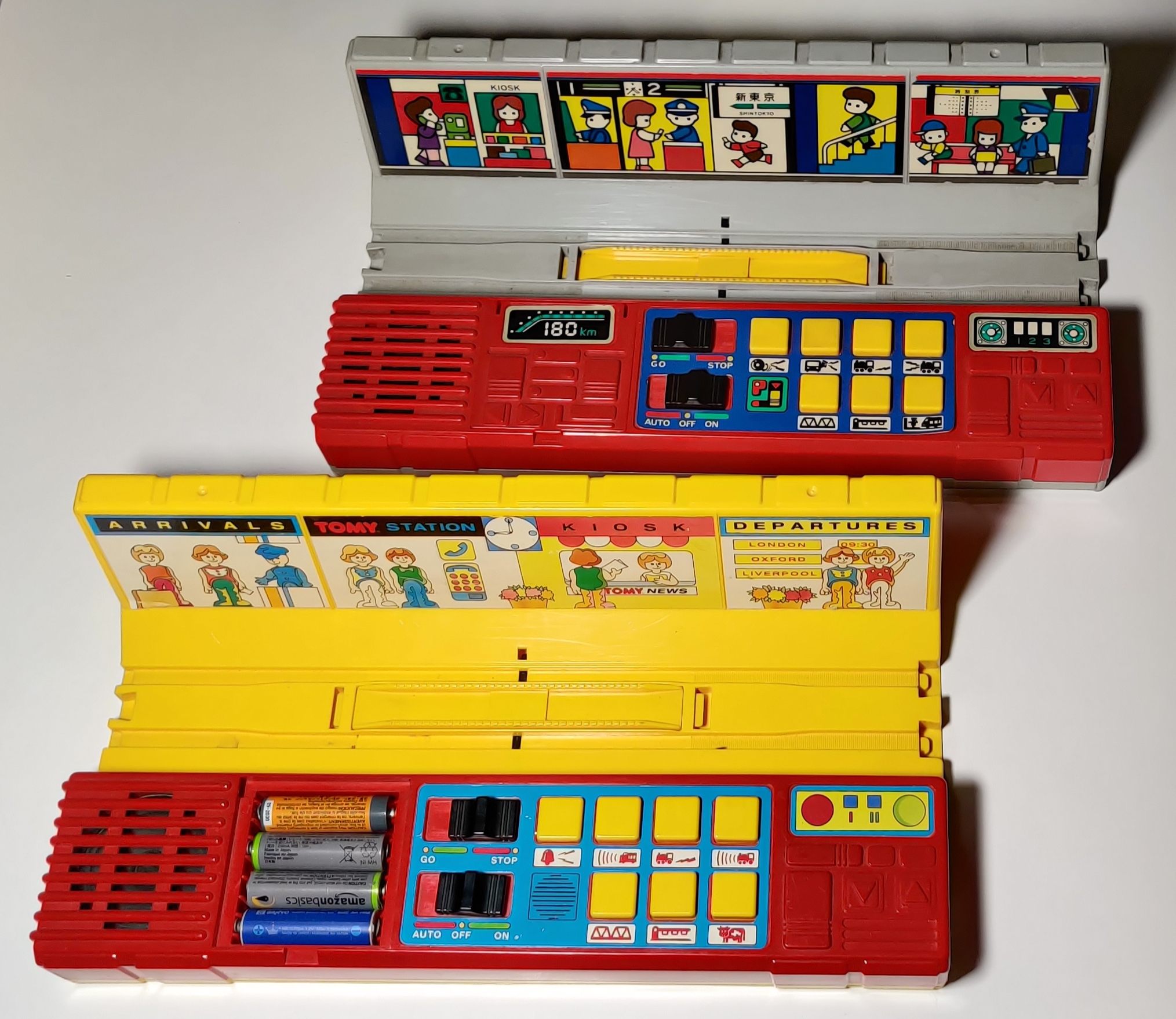
TomyTrain version of the Plarail Sound Play Station.

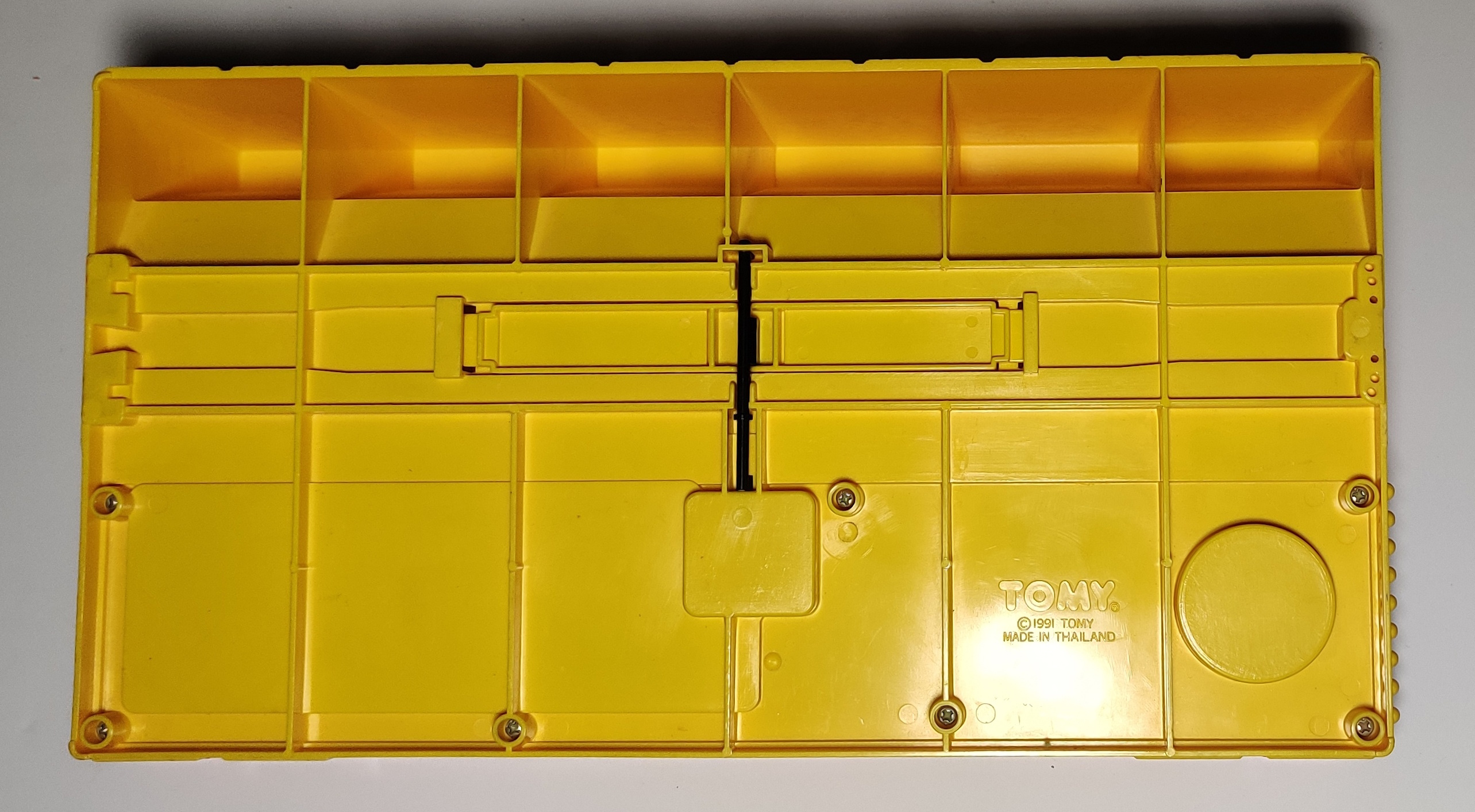
The back wall of the station is nicely decorated as is the "control panel" section. Unfortunately, my example is missing the battery cover. The back and underside are plain. The control panel has an integrated stopper and seven buttons that play different sounds. The top left button plays a ringing bell. The second button plays a diesel train horn. The third button is a steam engine chuffing, and the fourth is a steam engine whistle. On the bottom row is the clacking of going over an iron bridge, the dinging of a railroad crossing, and the mooing of a cow. Although several sounds are similar to or share the same concept to the Plarail station, it does not seem that any sounds were directly reused.
1334 Train Wash (1993)

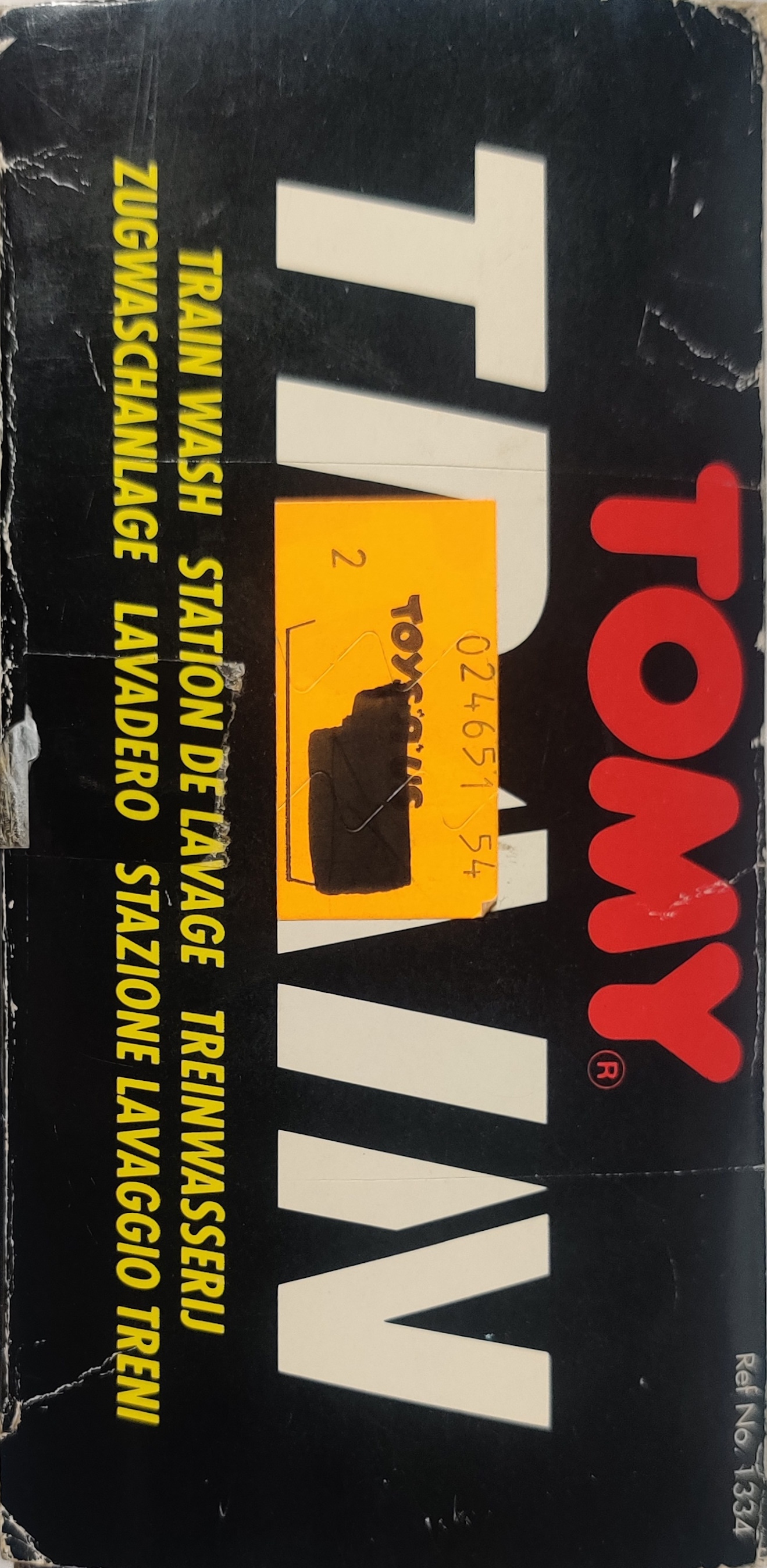

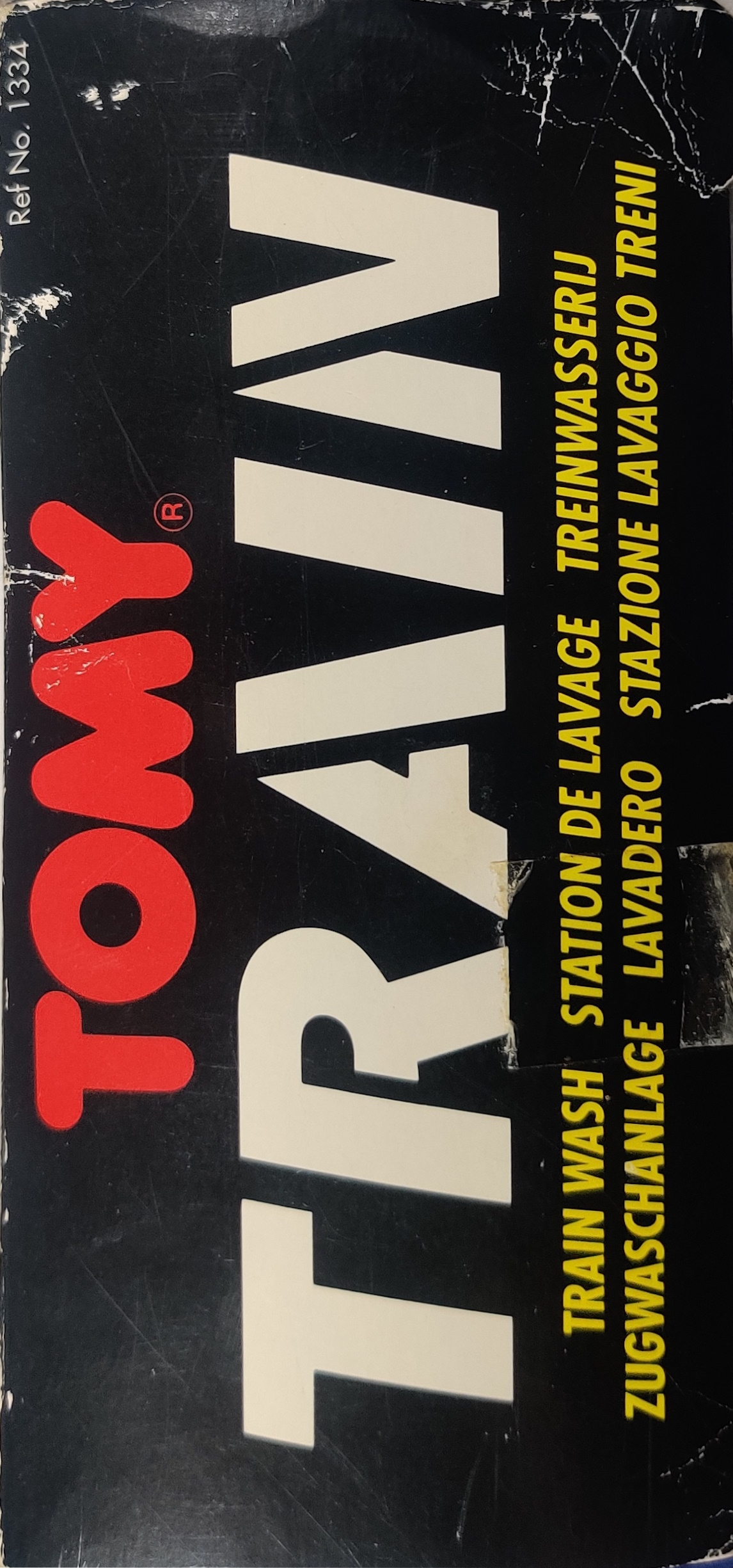

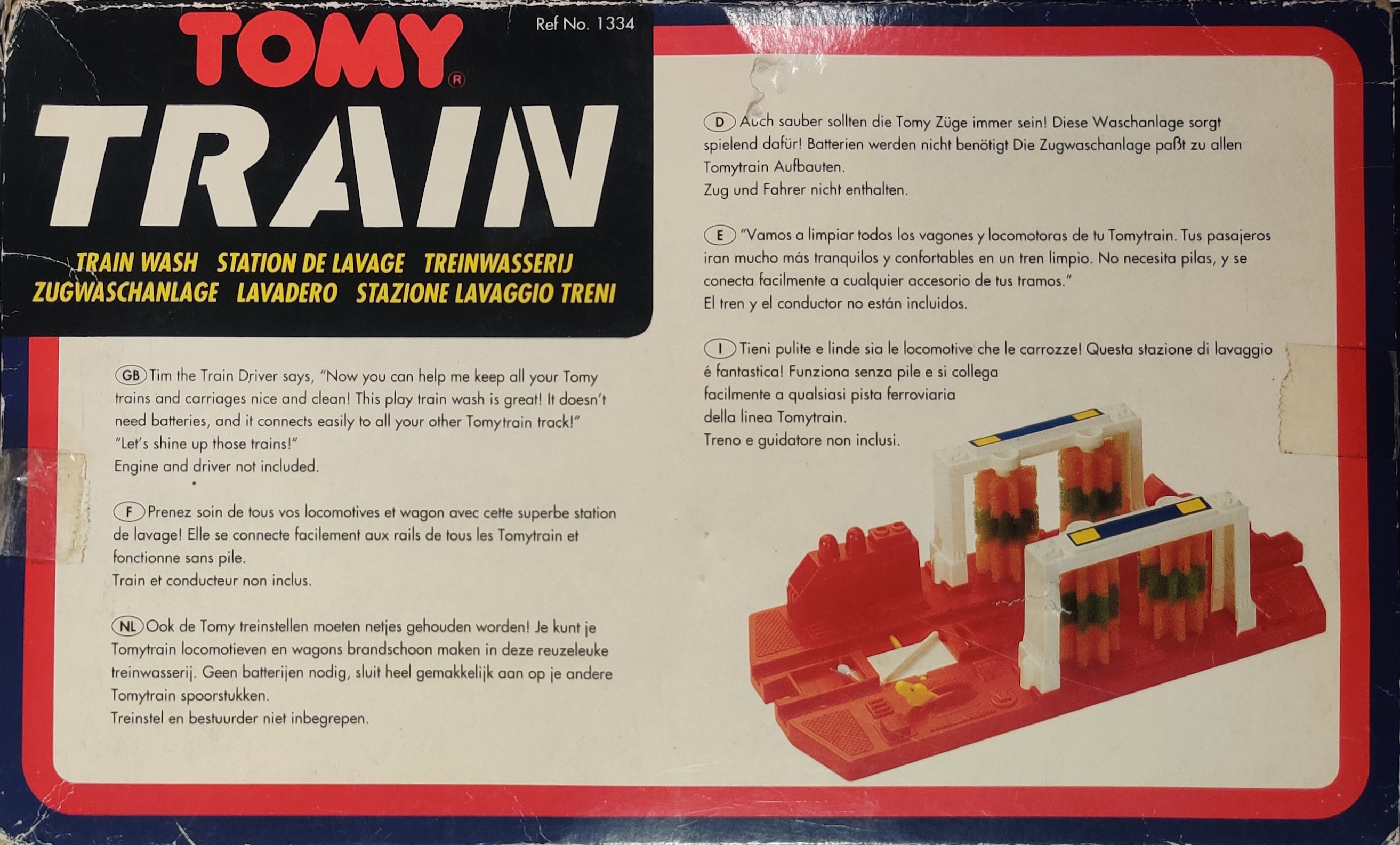
The Tomy Train Engine wash was based on the existing Plarail Round-Trip engine wash but in a new color.
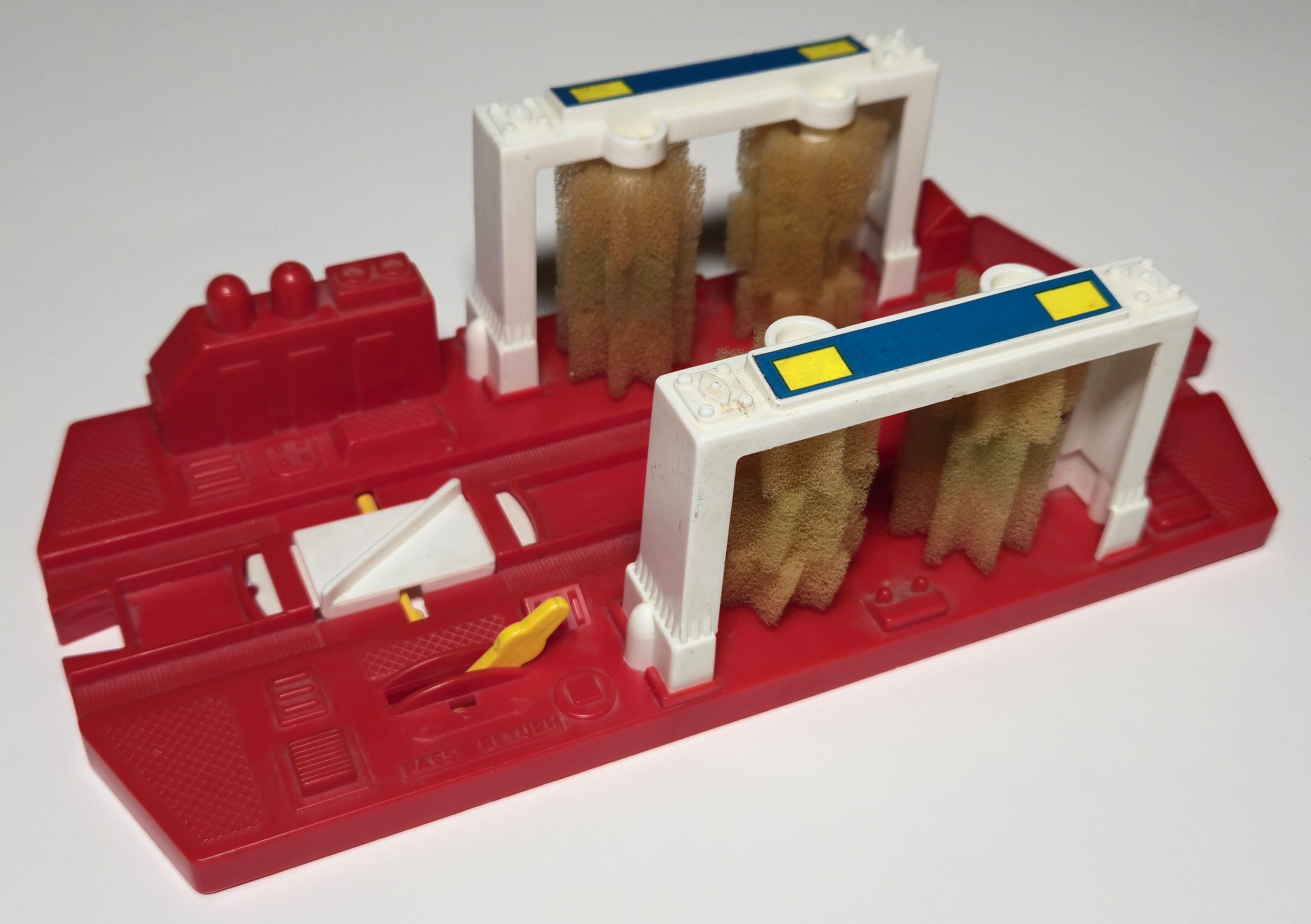
The reverser feature from its Round-Trip Plarail origins is of course still included and fits very well with the Tomy Train reversing system.
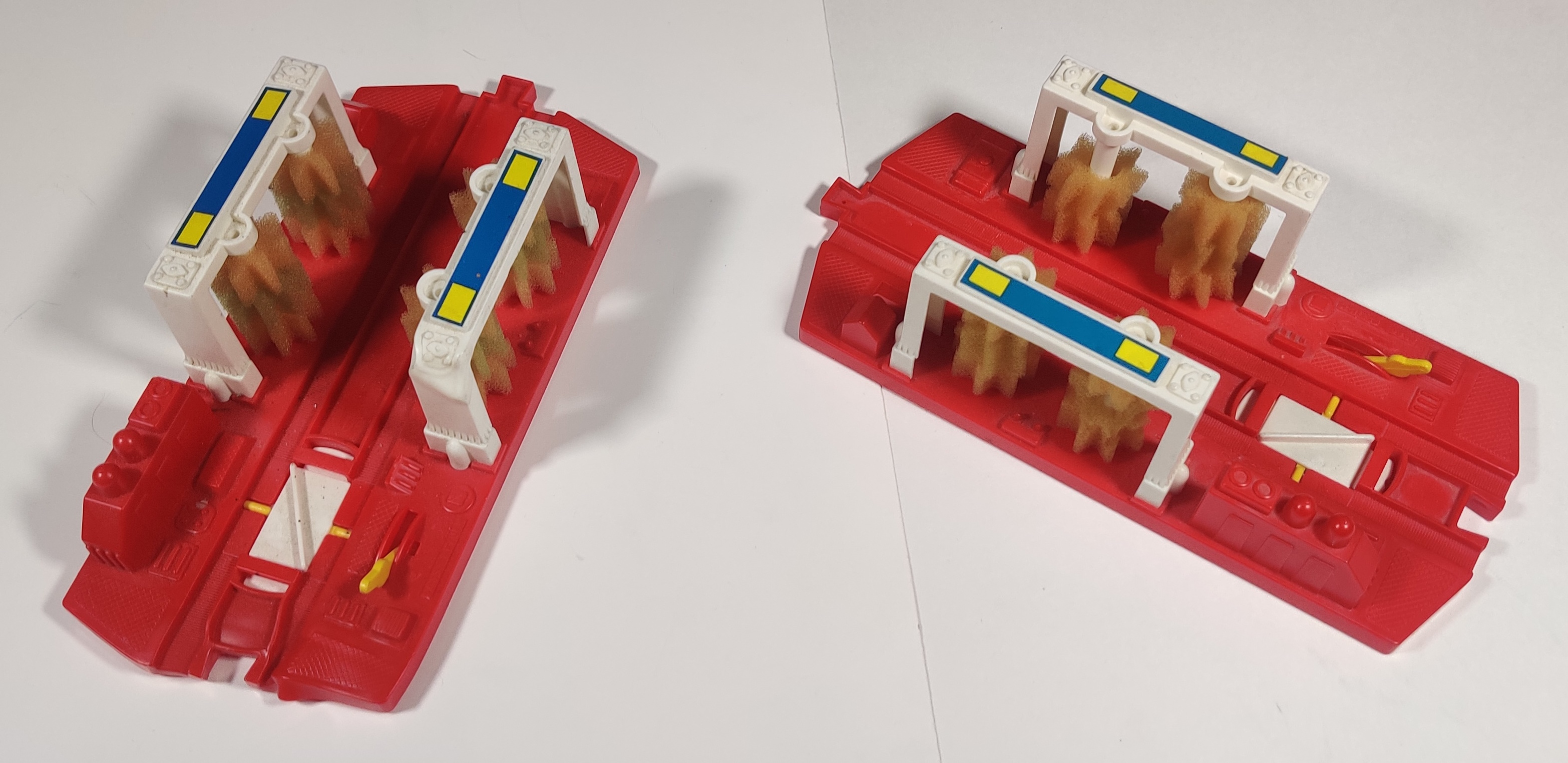
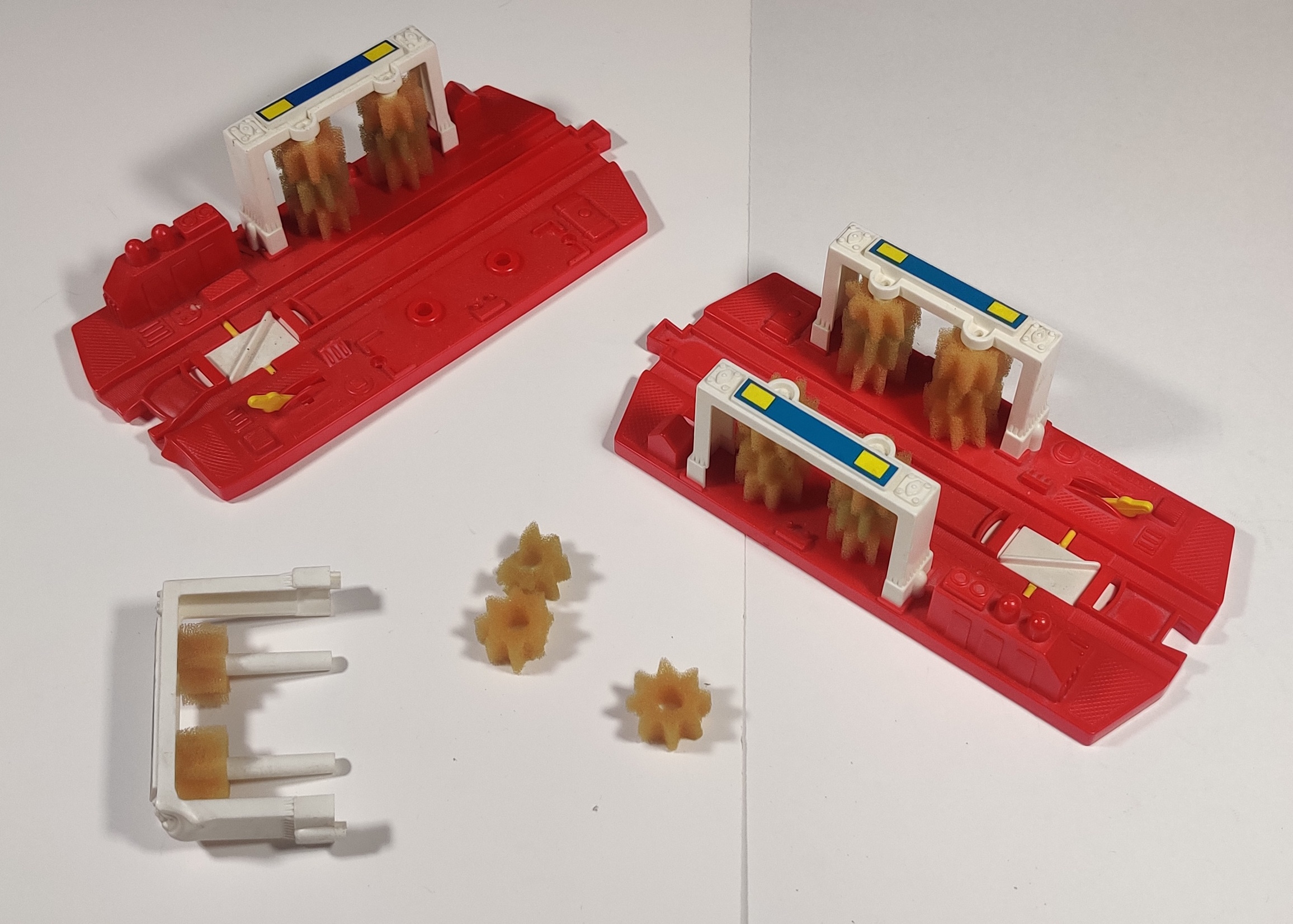
I actually have three or four Tomy Train train washes, but one has warped plastic on the roller housing and near one of the track connectors. I ended up taking this one apart and using some of its foam rollers to restore another used example that had intact plastic but missing or degraded foam rollers.
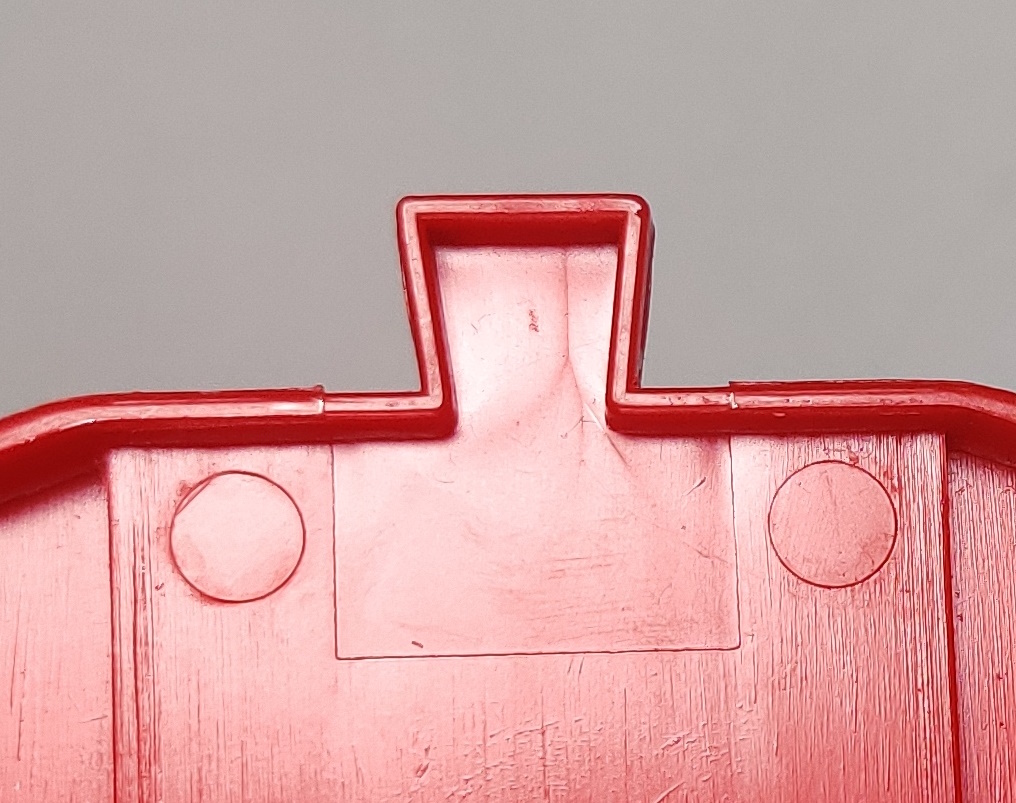
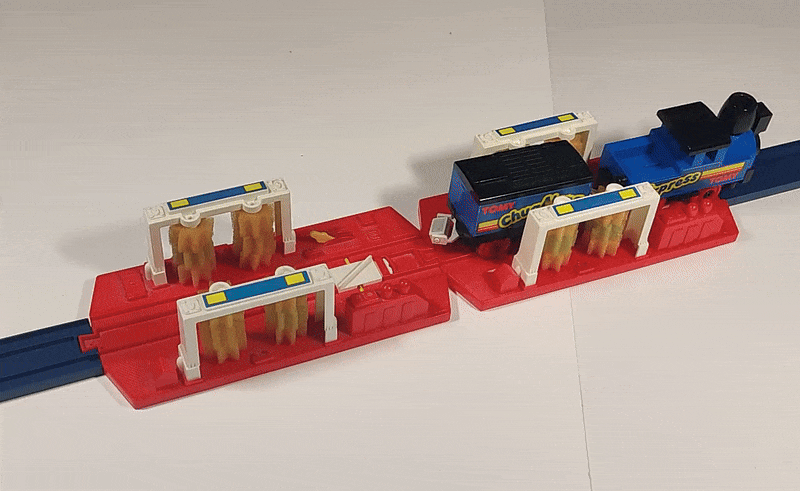
The original made-in-Japan Plarail engine washes had concave connectors on both ends and included "beans", but when this version was produced in the Thailand factory the tooling was changed to make the track straight-through. This change was present in later Thailand-made Plarail engine washes, and the reversing feature remained in the tooling until it was revised and rereleased in new colors in 2003.
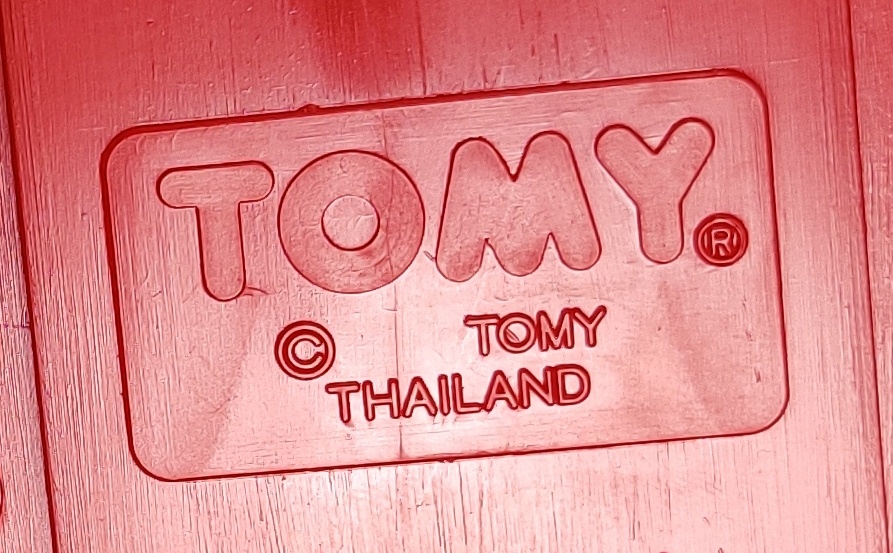
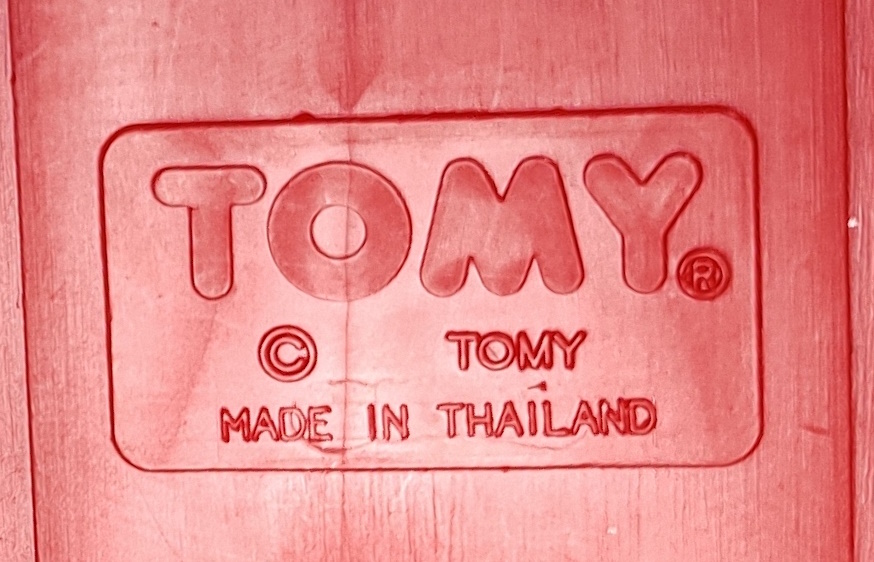
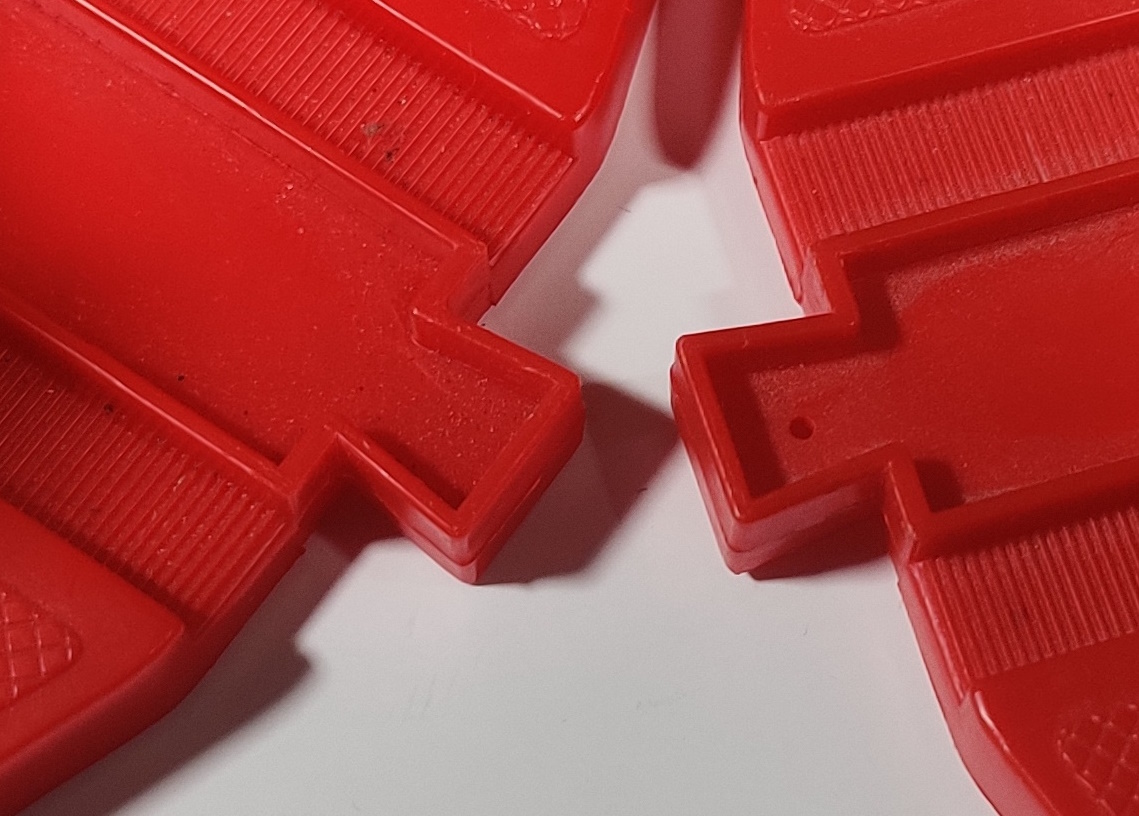
Very early train washes predate the change from "THAILAND" to "MADE IN THAILAND". For whatever reason, a hole is present in the convex connector of the later "made in" type.
1339 Signal Station (1993)
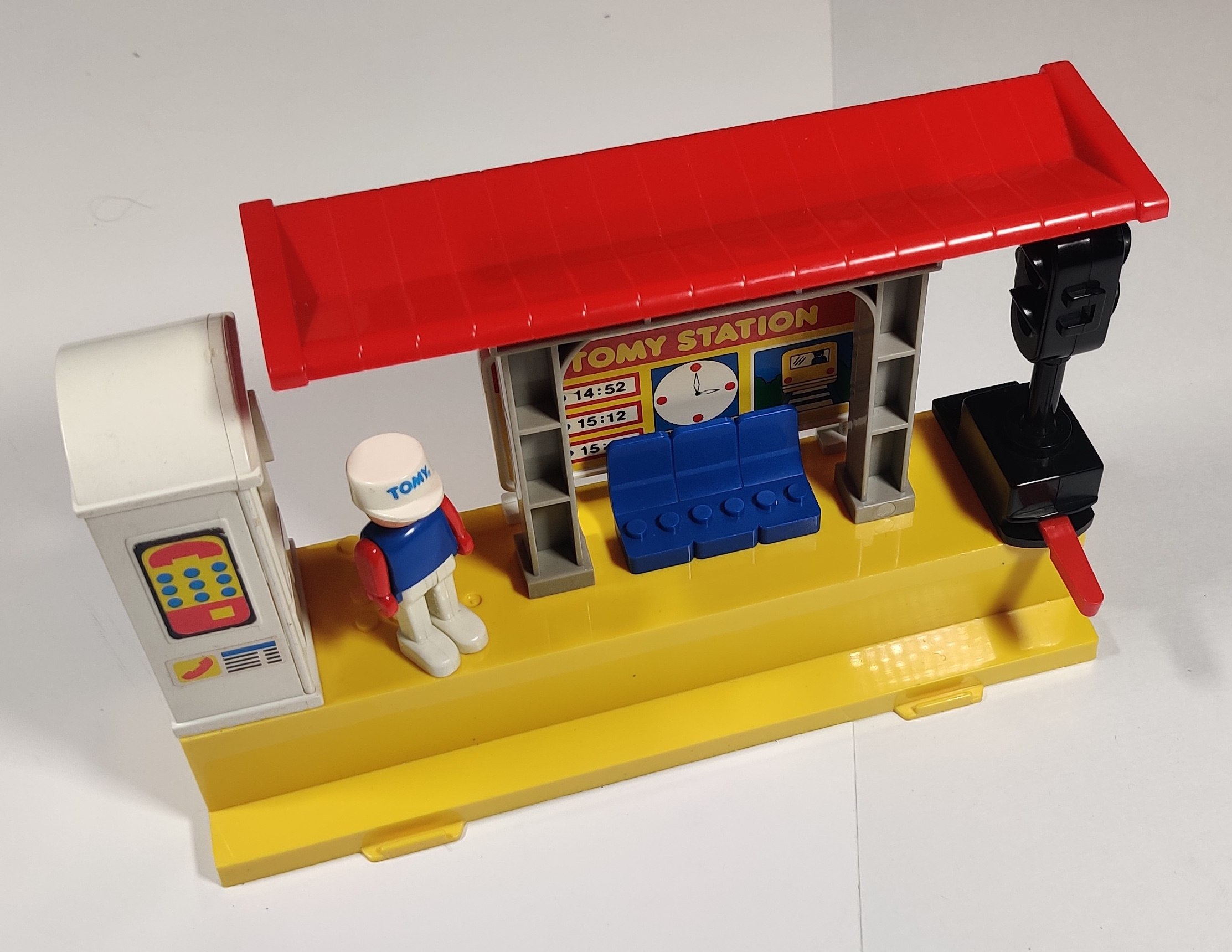
Updated station based on the original standard Tomy Trains station with new red roof, phone booth, and signal that changes as a train passes.
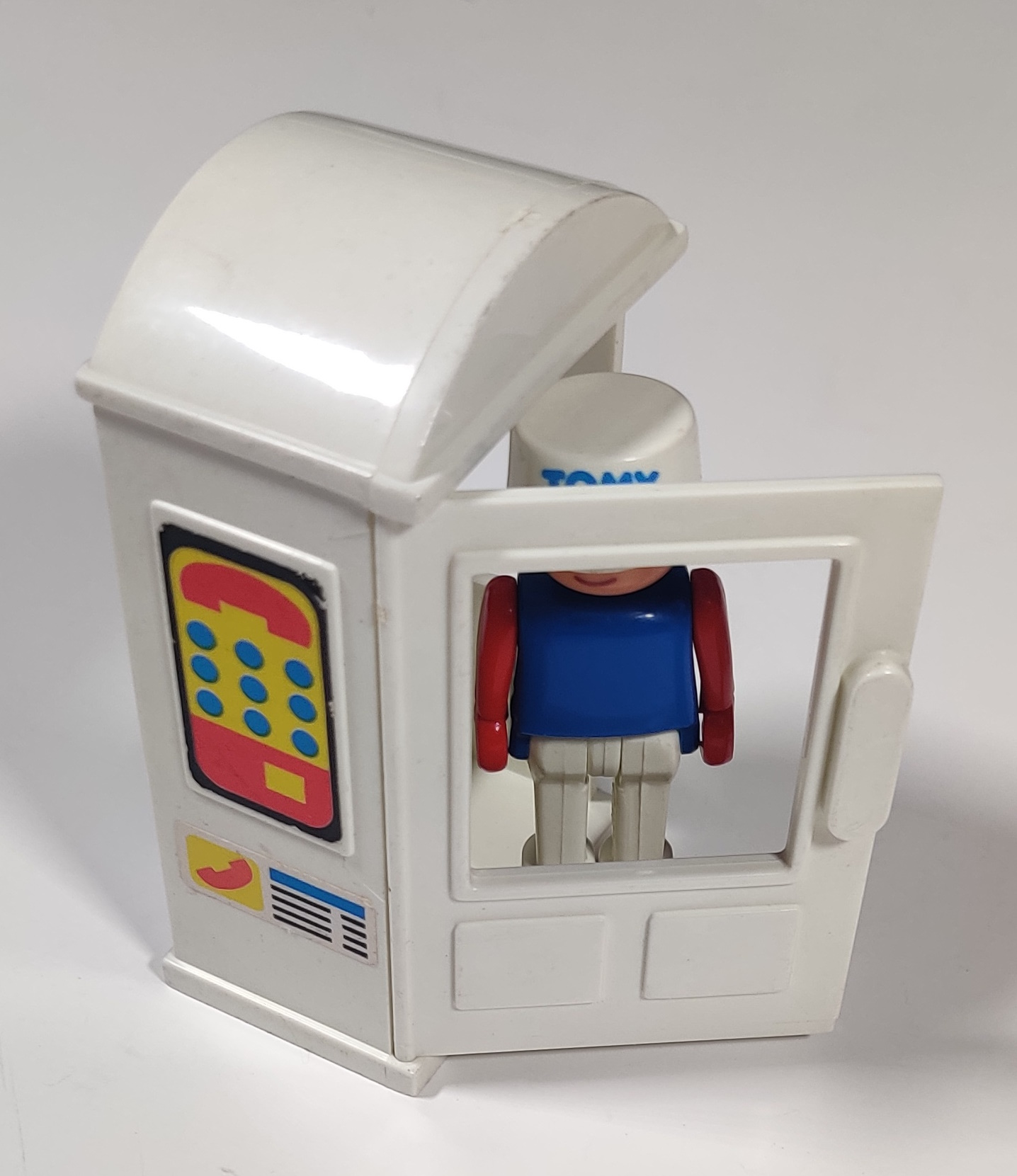
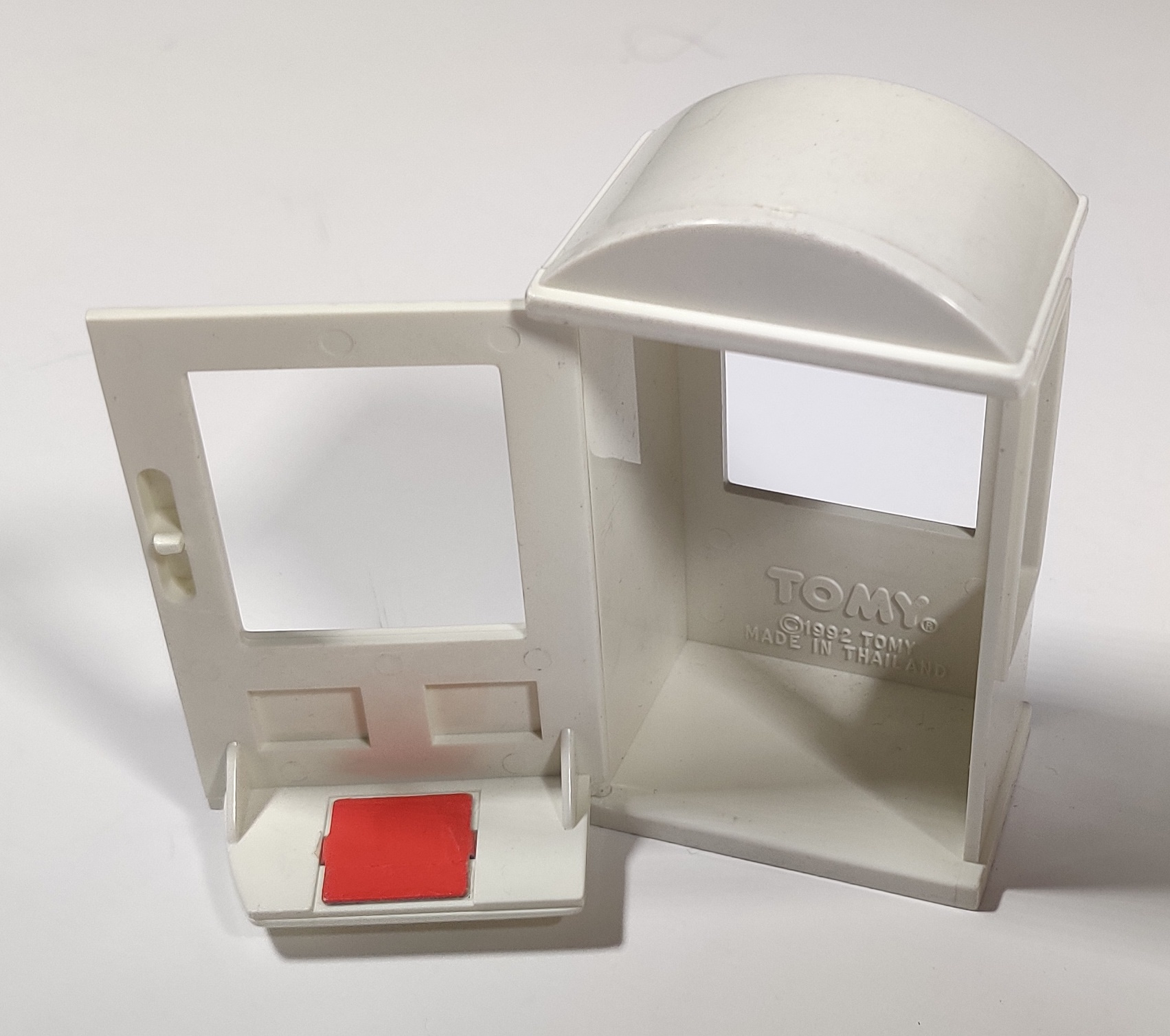
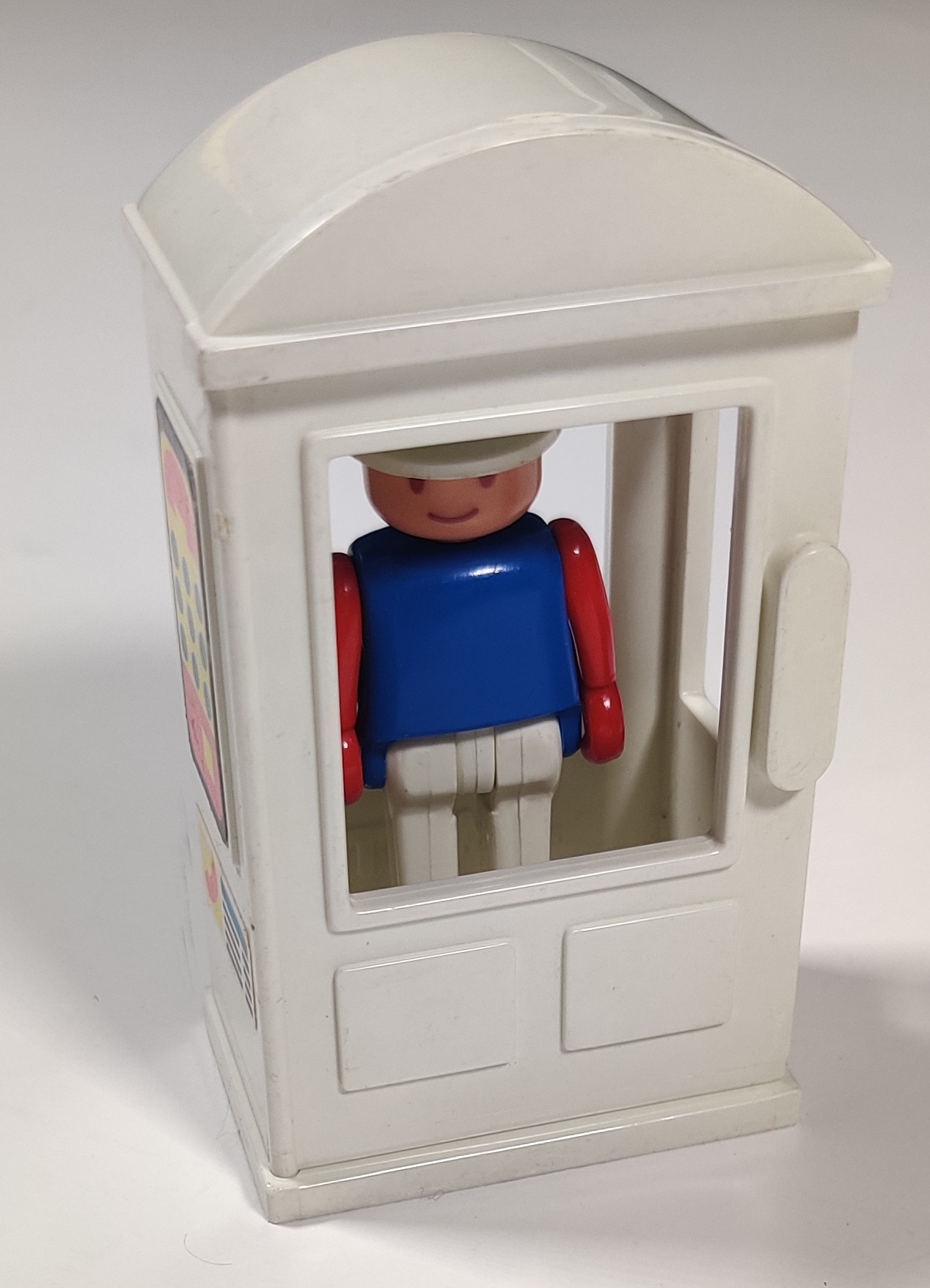
One of the catalogue descriptions calls this little white structure a ticket-taking kiosk, and I suppose it could be that, but to me it really looks like a phone booth. The stickers sort of imply there is just a payphone hanging outside the kiosk, I suppose. There is a magnet in the opening door so that a figure can "walk" in and out when it is opened.
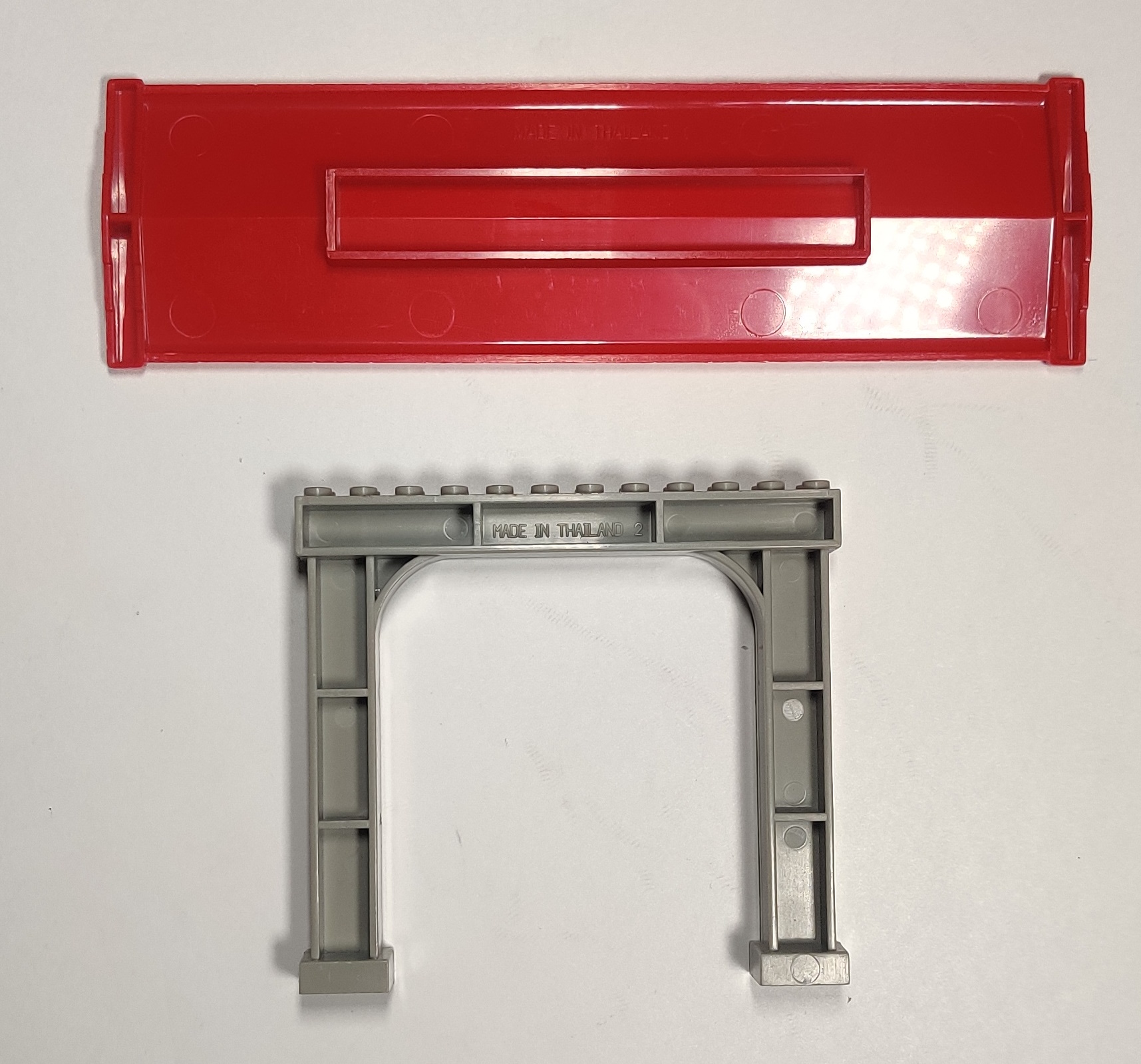
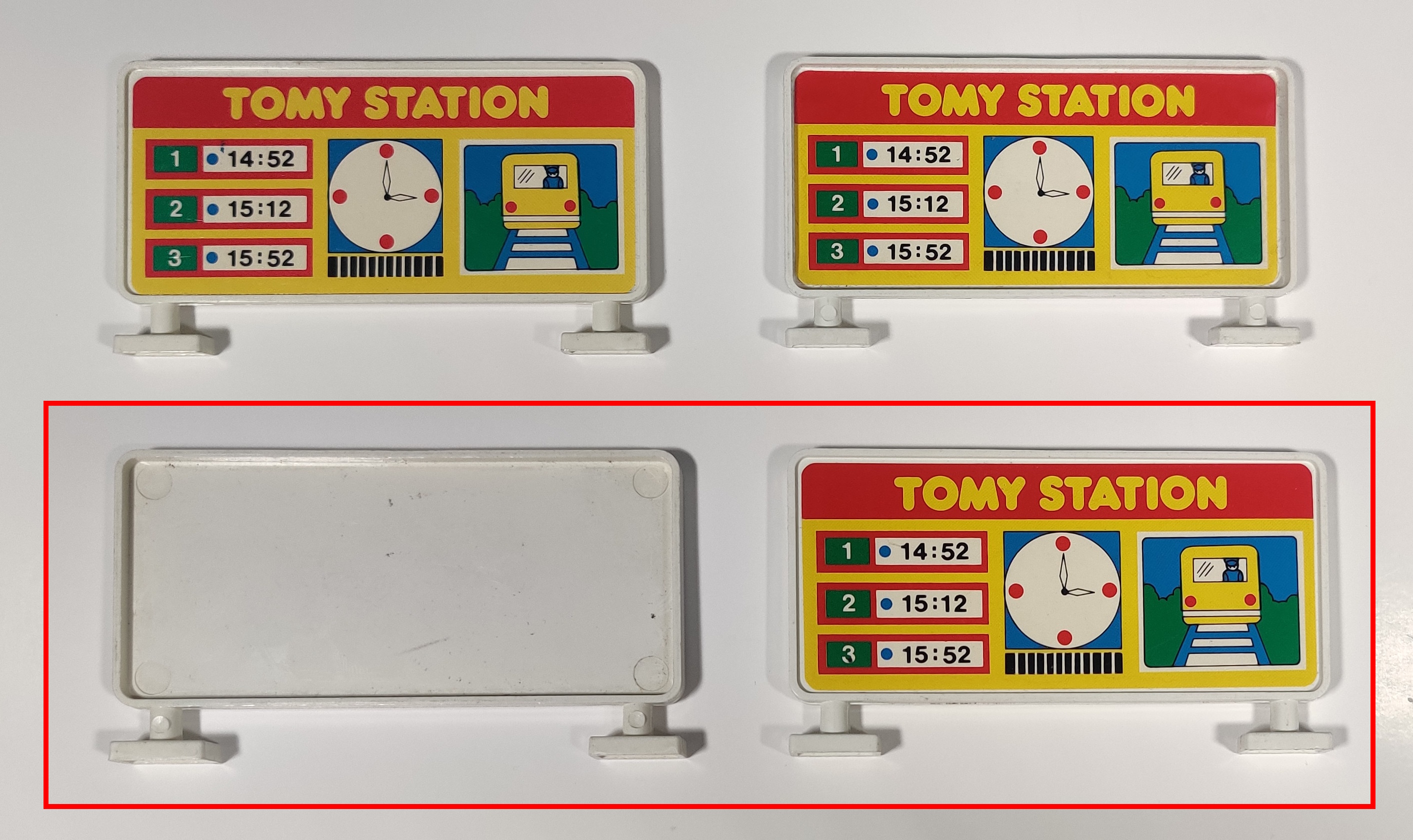
The grey support structure and red roof were nice additions to the otherwise fairly flat original station. I have seen this rather neat Tomy Station sign in single and double sided versions, and really like the graphic of the little train. Its a pity Tomy did not produce more different types of Tomy Train engines.
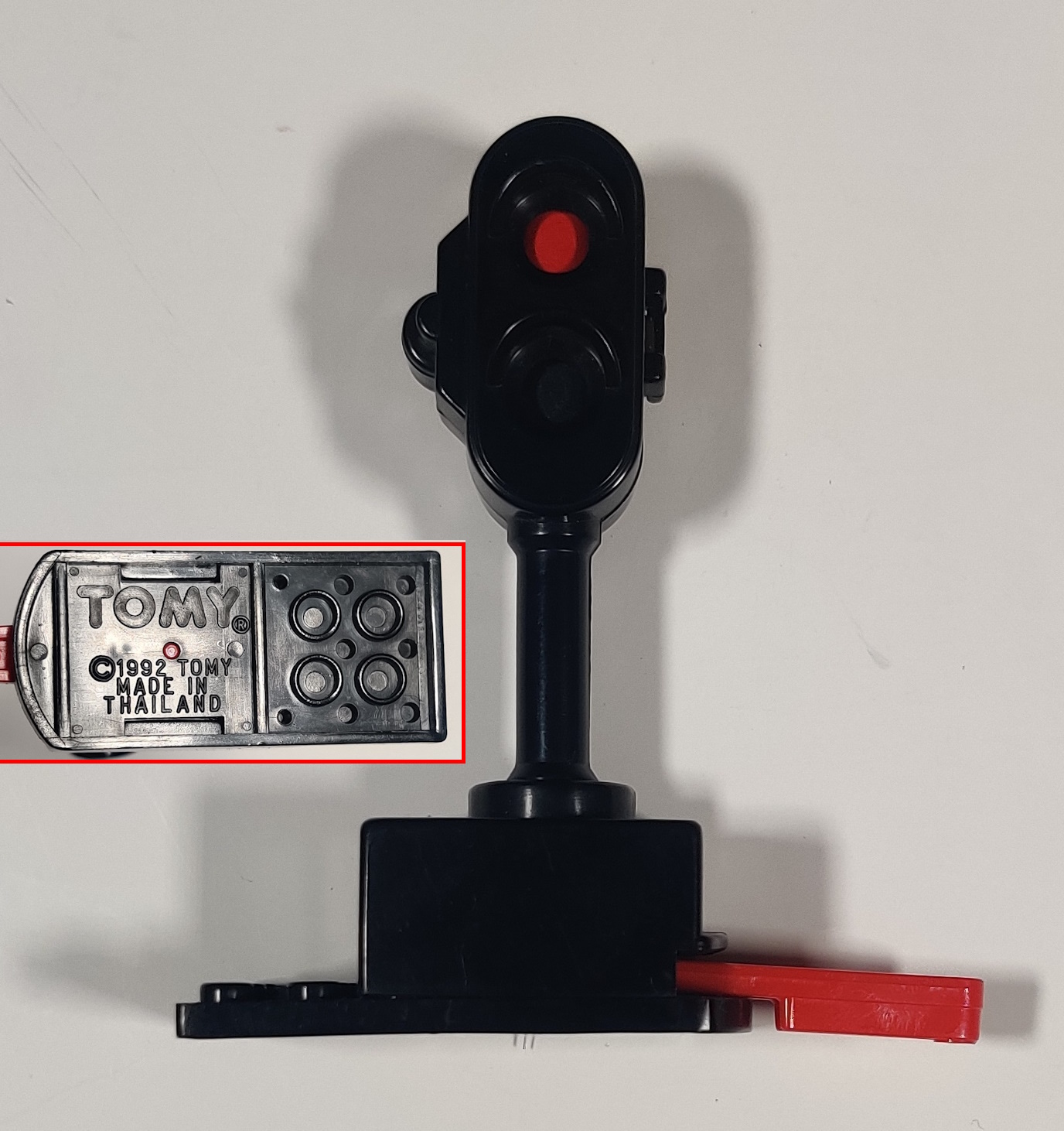

The signal has a very LEGO-looking base and sits in the red position. When a train passes, it flips up into the green position, flipping back down when it is gone. To me this seems a little backwards - surely the signal should normally be green and indicating that the next upcoming train is free to enter the section of rail, turning red as it enters to prevent another train from entering?
1341 Long Tunnel (1994)
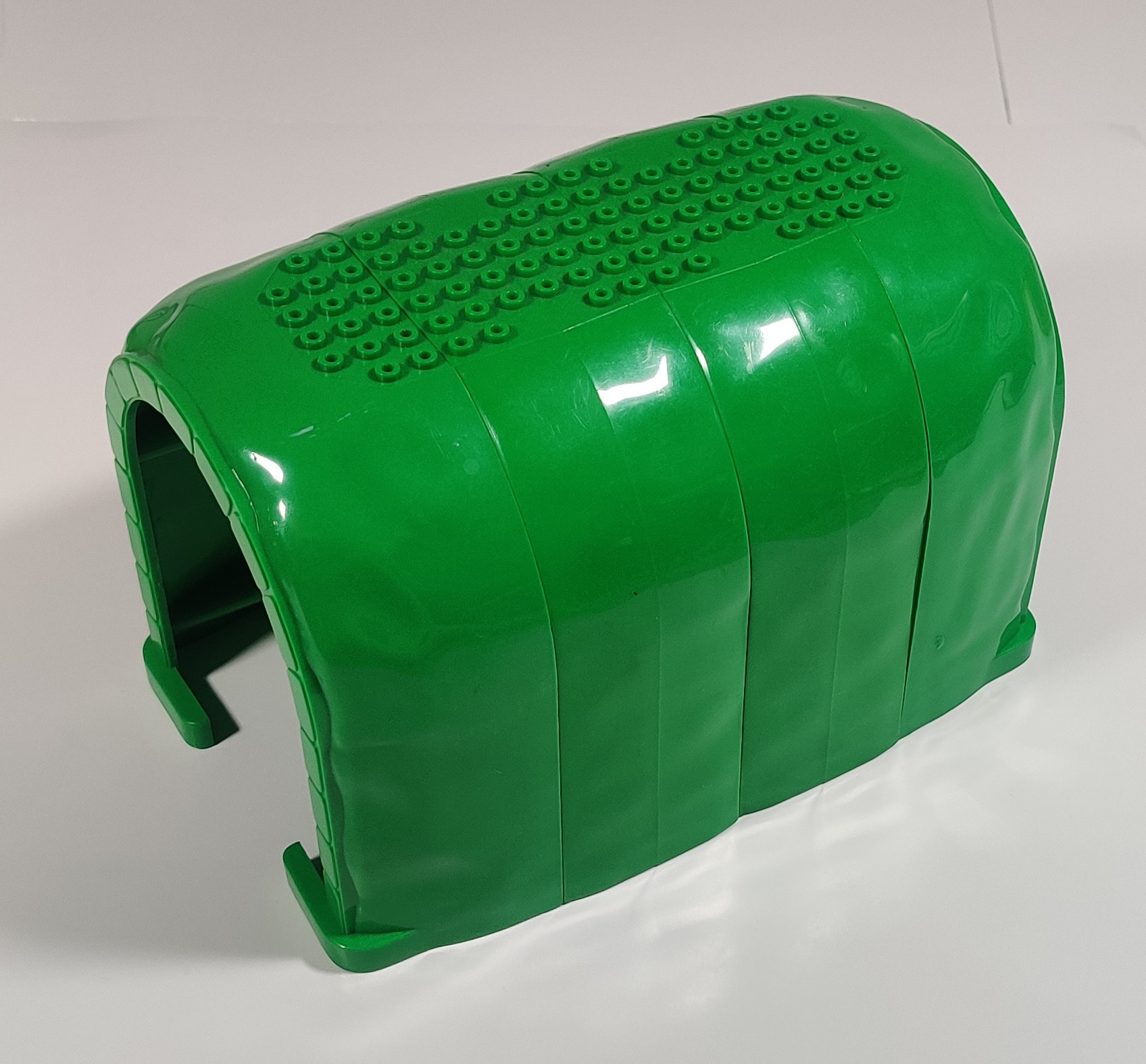
Despite the "normal" two-piece tunnel appearing in sets since 1988 as well as the 1330 Crossing Pack and later a Thomas-series pack, it was not given the "block tunnel" treatment with additional intermediate segments until this 1994 individual release.
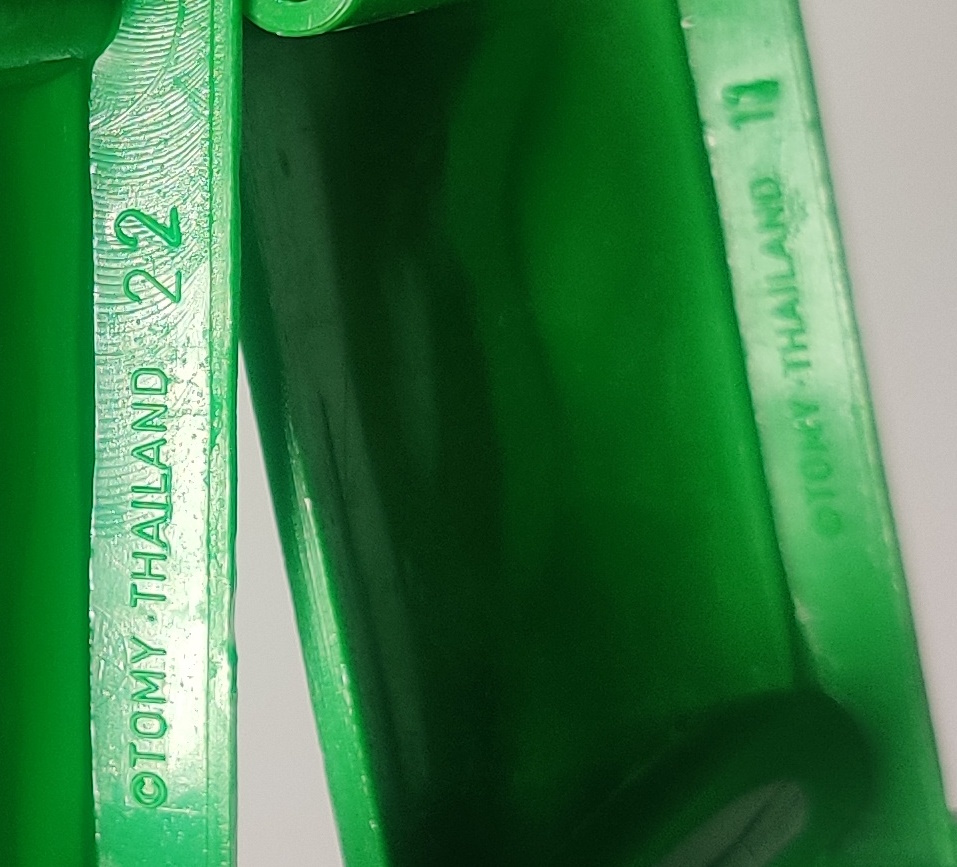
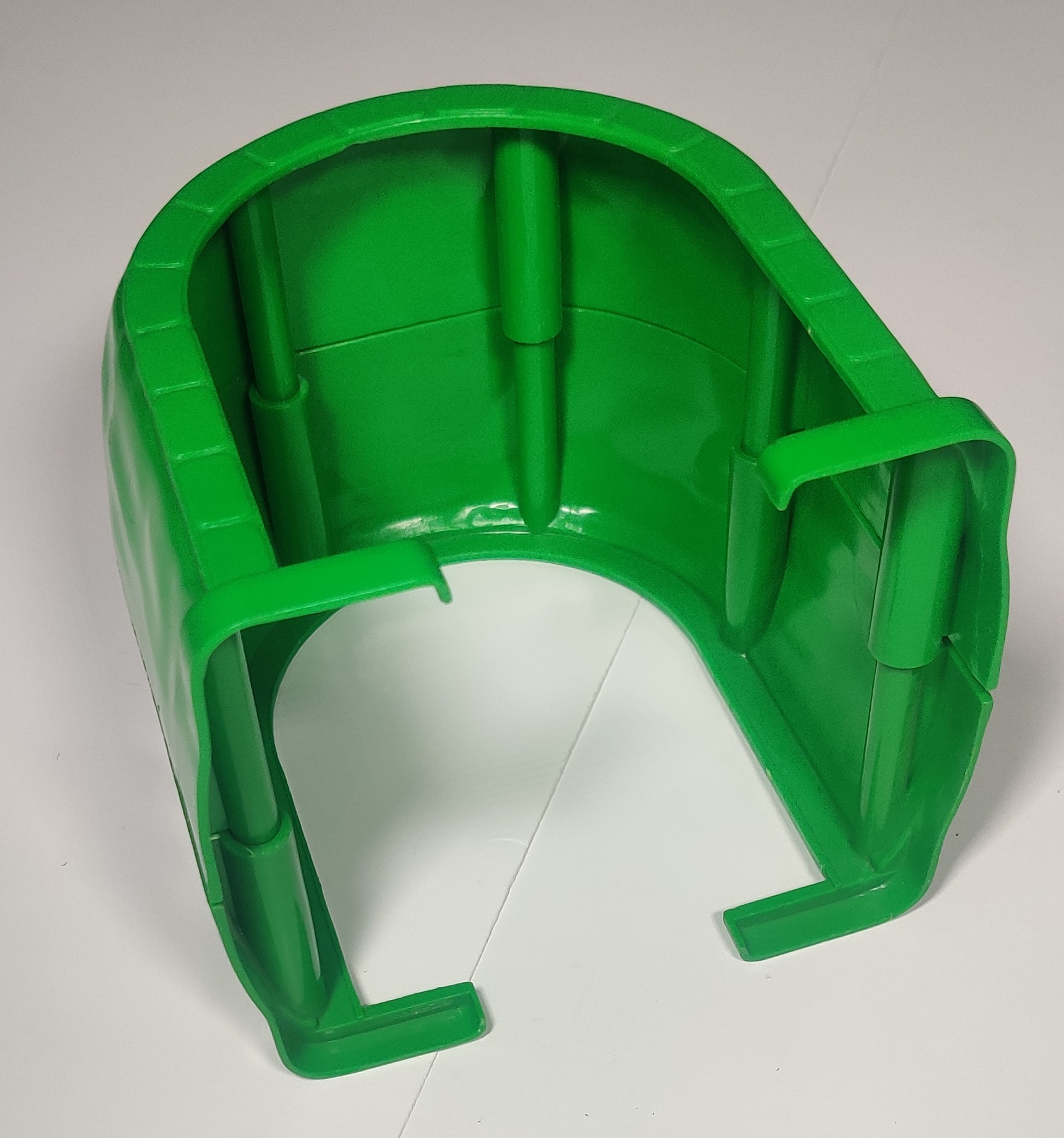
The components are marked Thailand and fit together using a series of alternating pegs and tubes that fit together when flipped around, which is a clever evolution on the earlier one-way Plarail block tunnel design. The intermediate sections (wedges? leafs?) do not engage with every tube, skipping the ones midway up the side walls.
1346 Autobridge Set (1994)
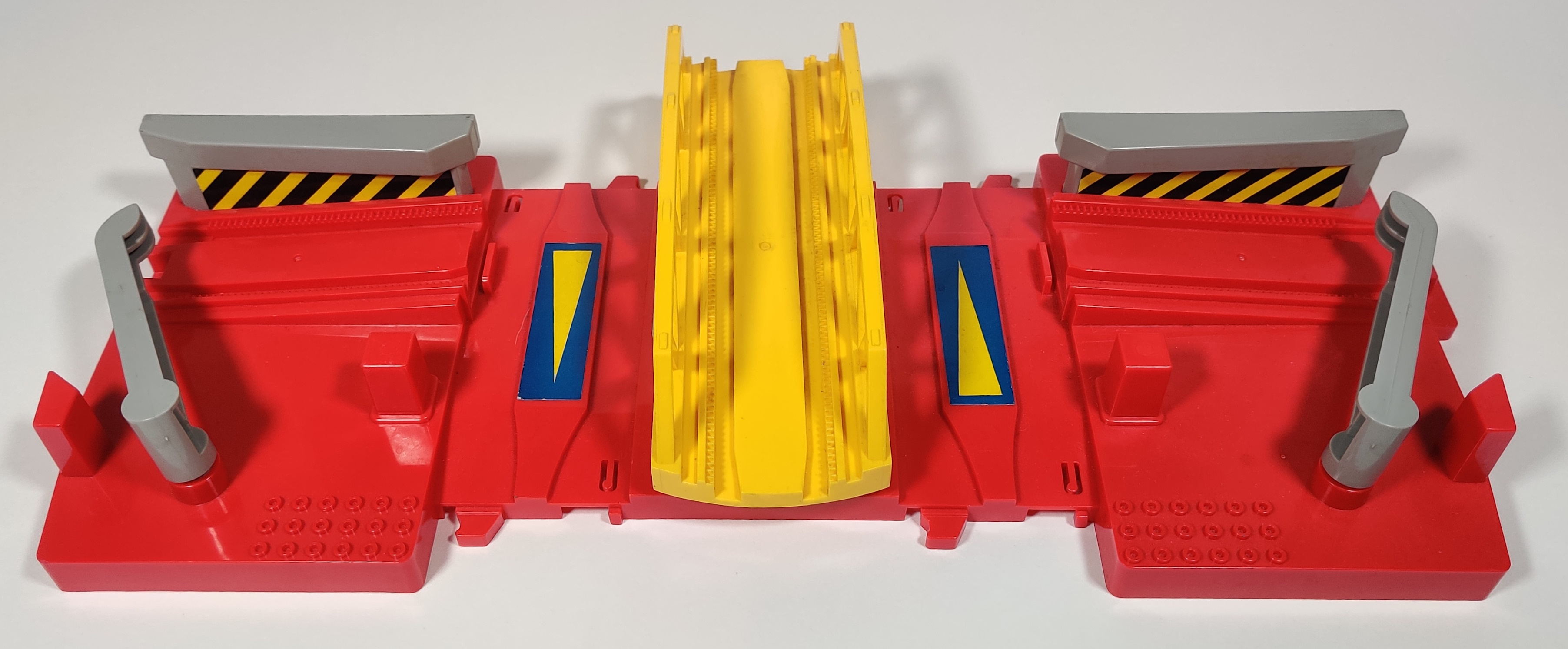
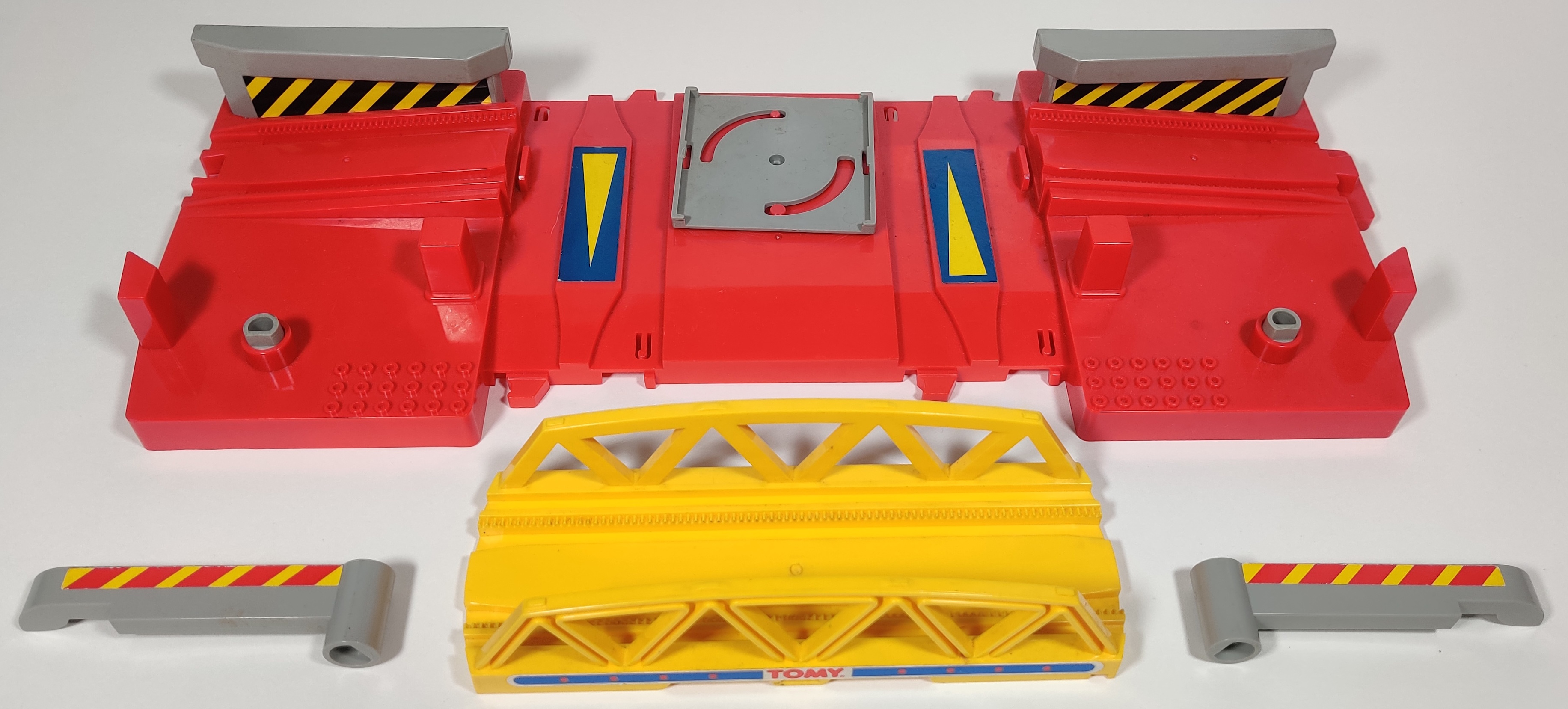
An automatically rotating bridge that is triggered by an oncoming train. The grey lever arm pieces are somewhat hard to find, I have three bridges and just one pair of triggers.
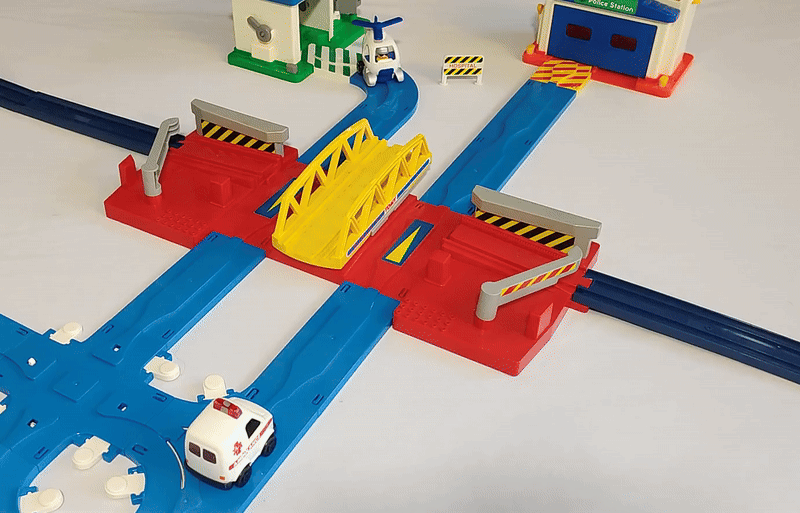
The bridge is normally open to let Fun Runs World (I'll get to covering them someday) veicles pass.
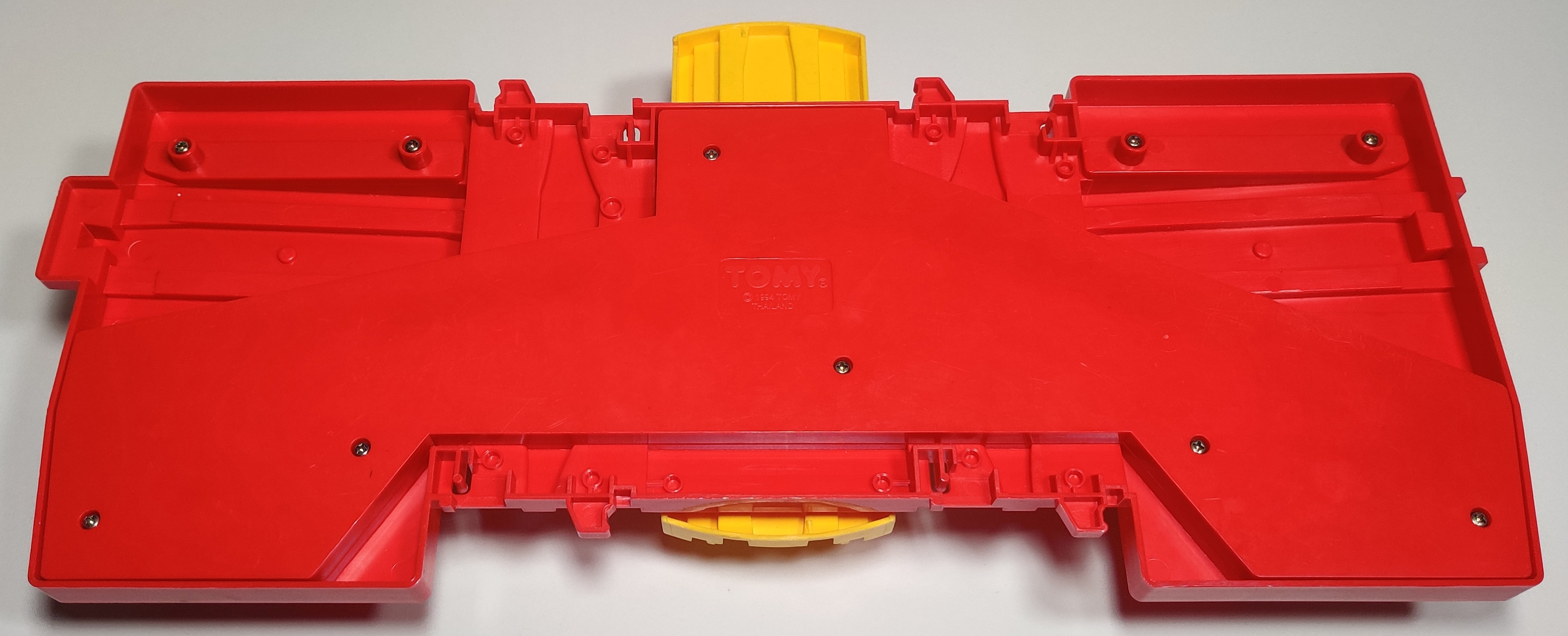
This was the last new regular accessory released for Tomy Train, I believe.
| Sets | Trains | Rail | Accessories | Thomas series |